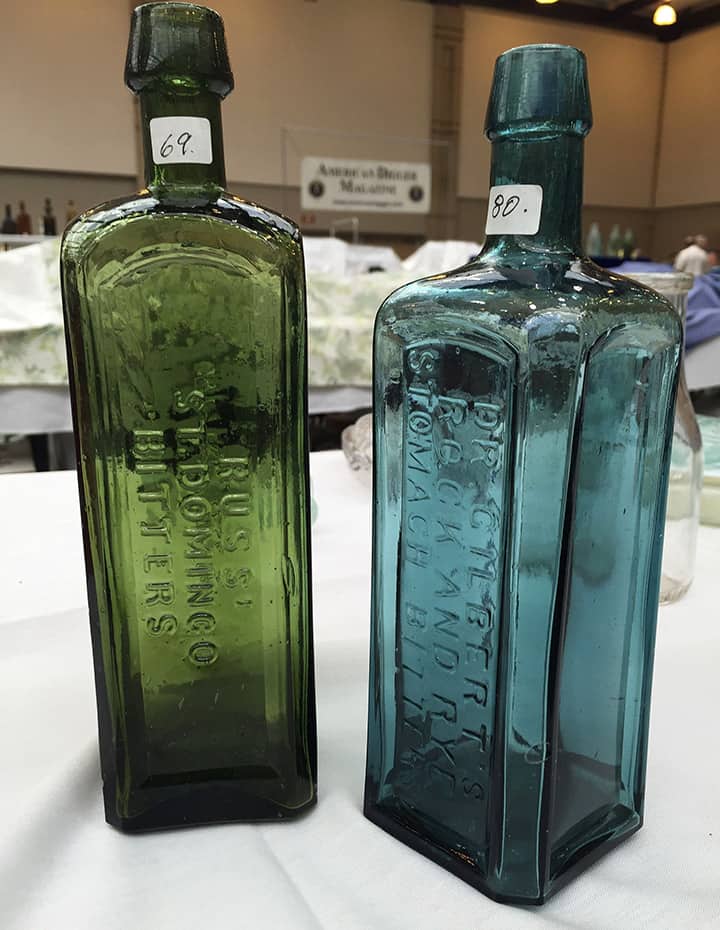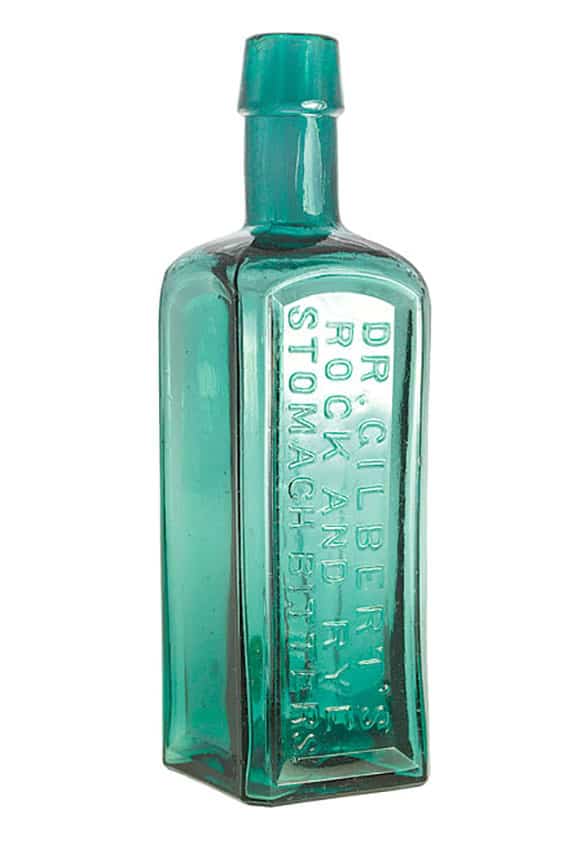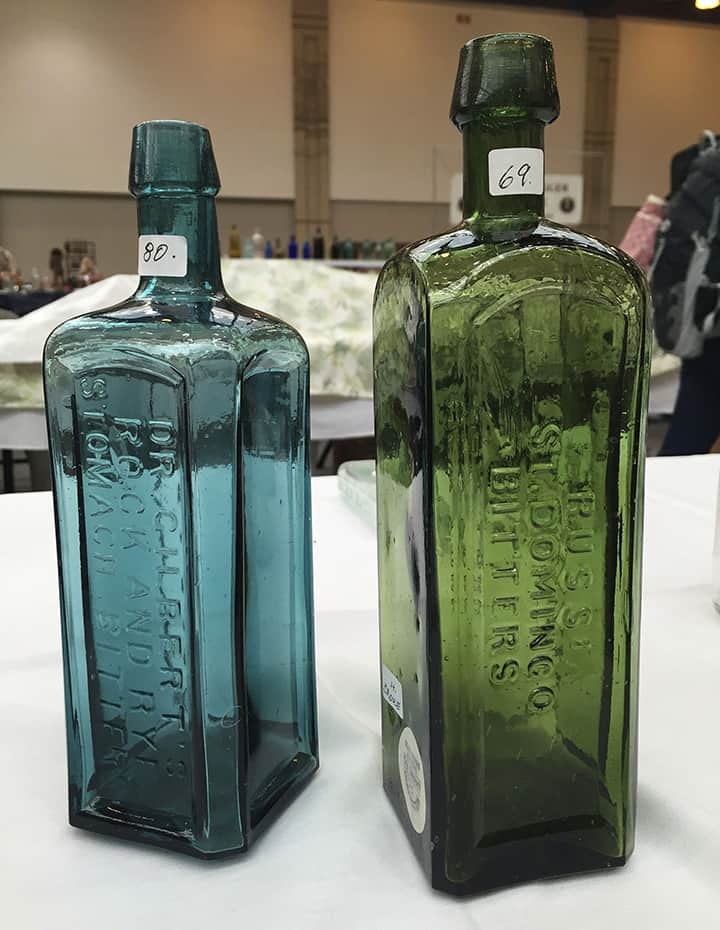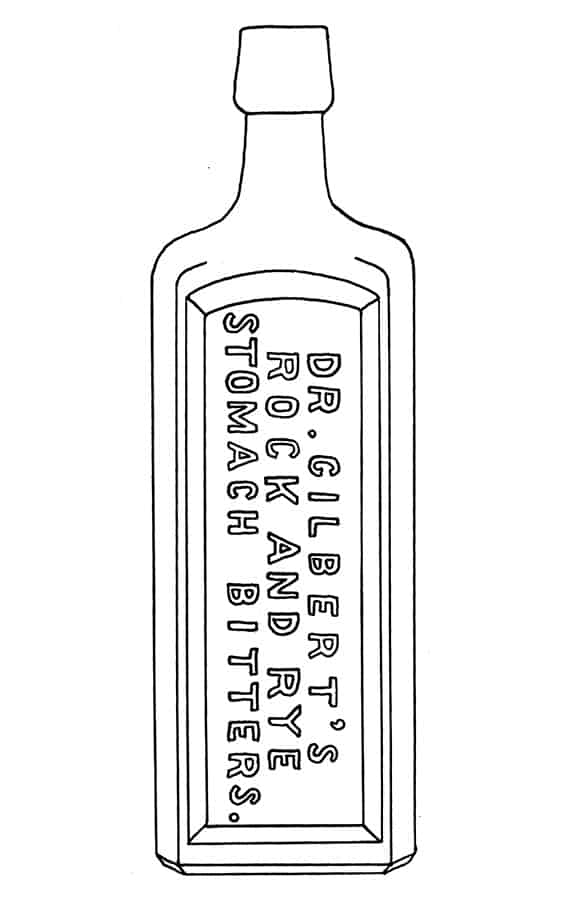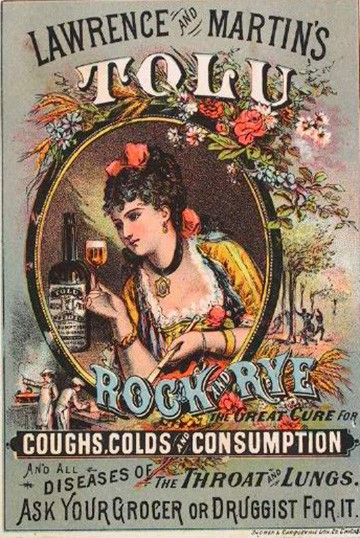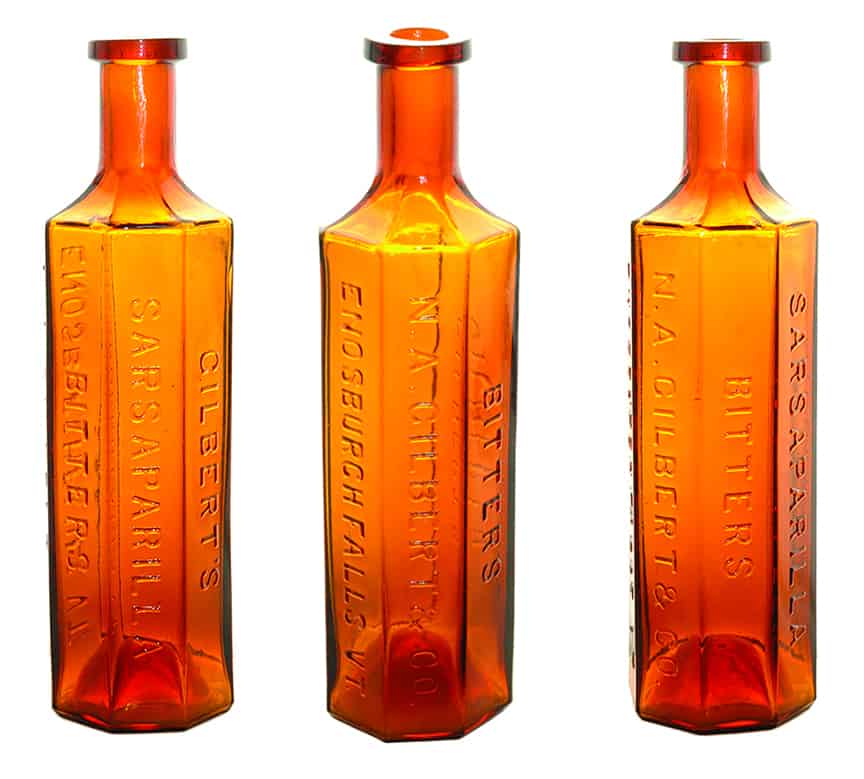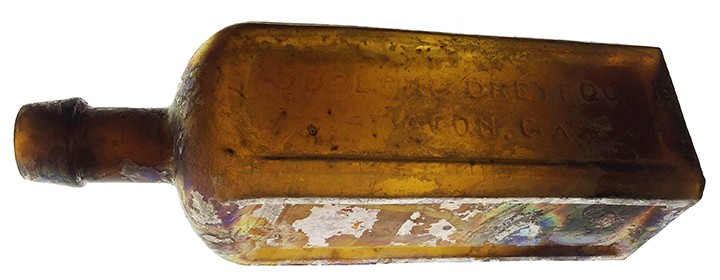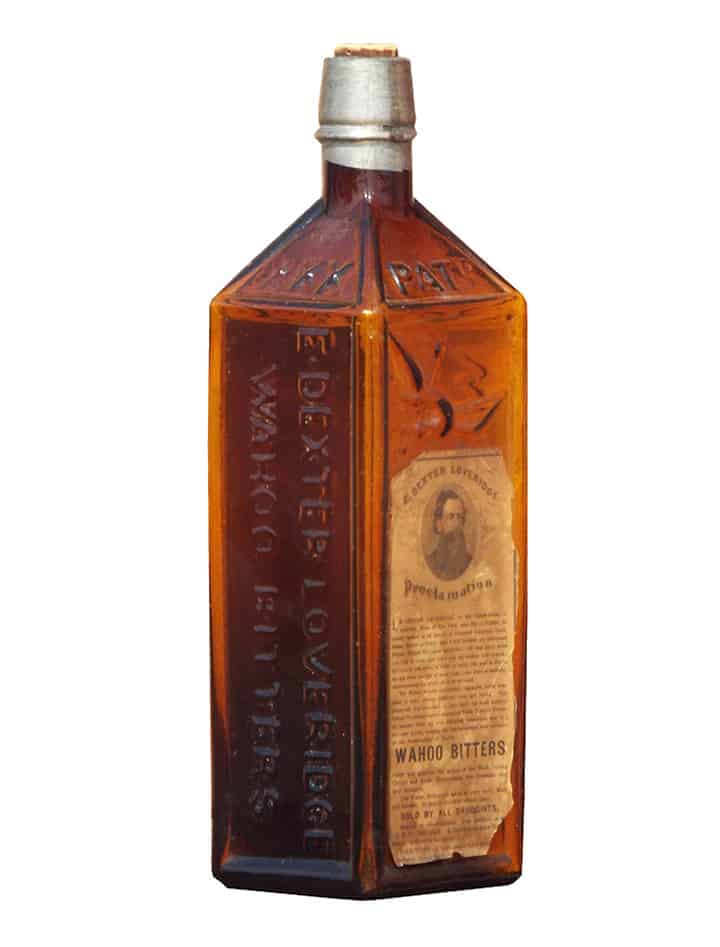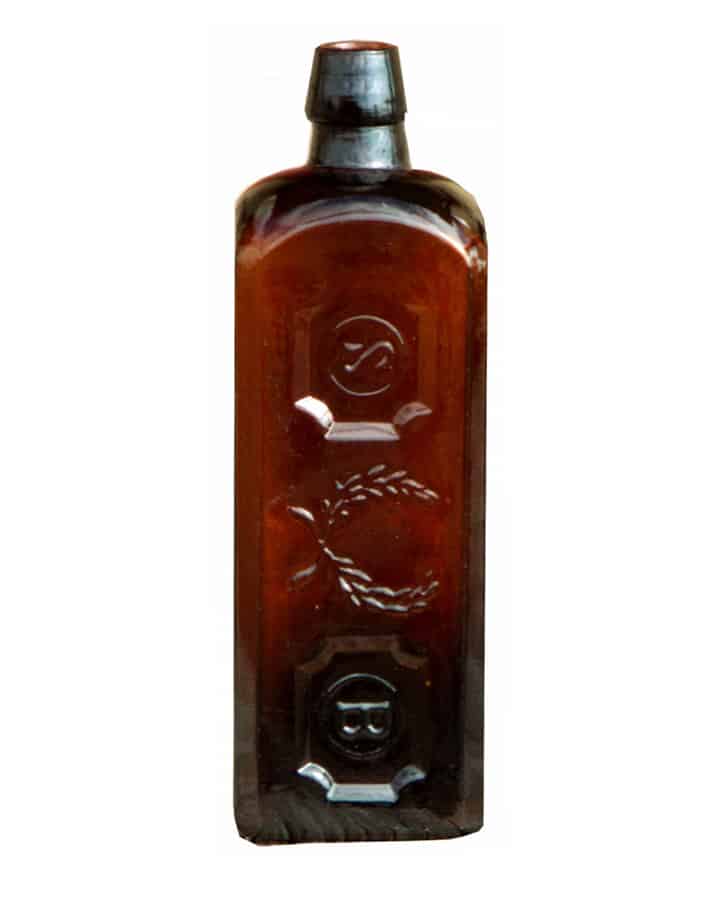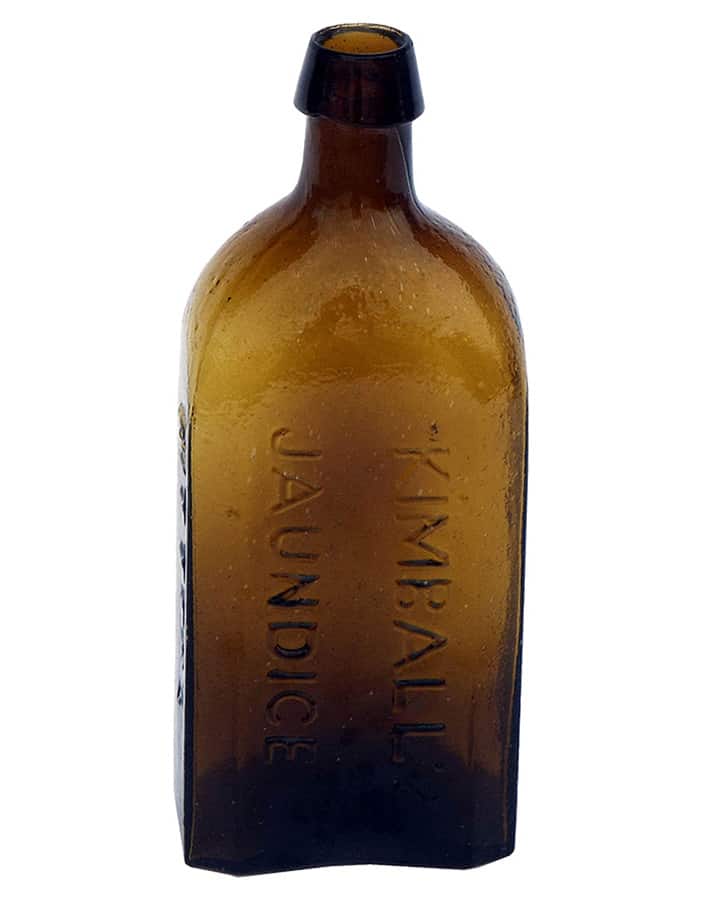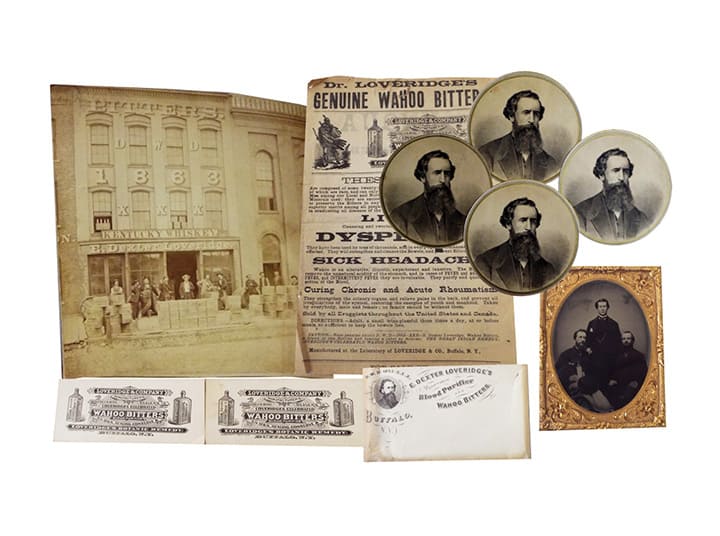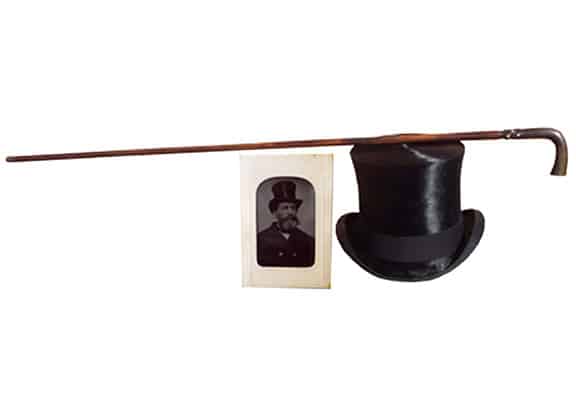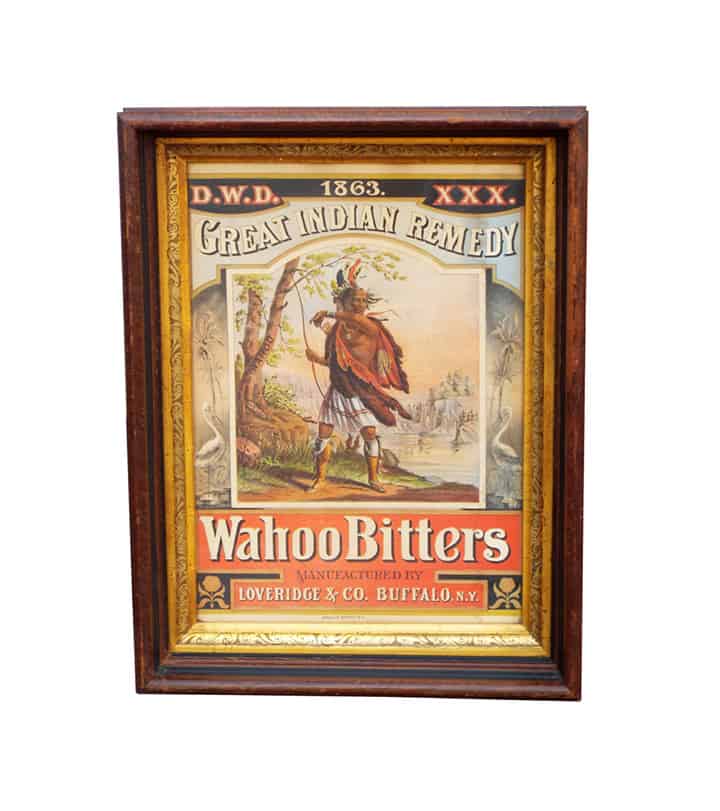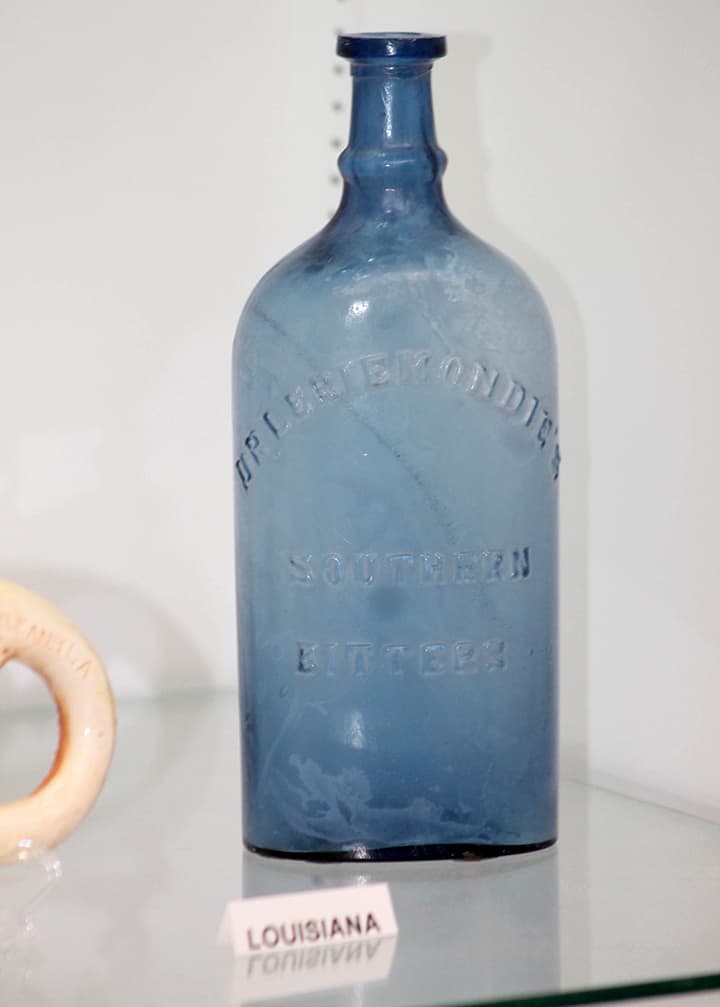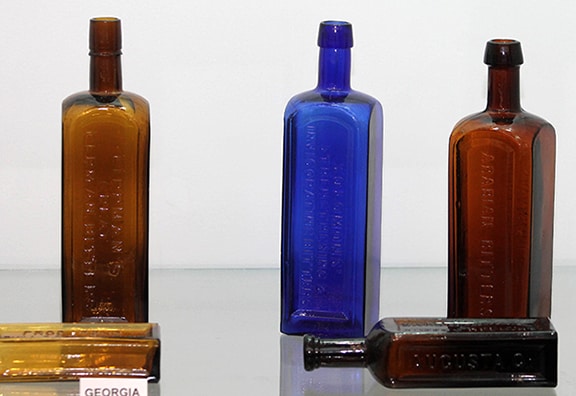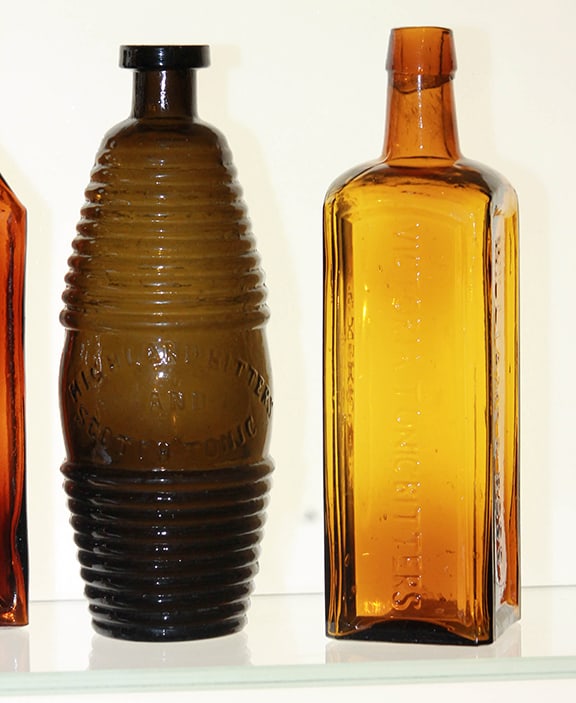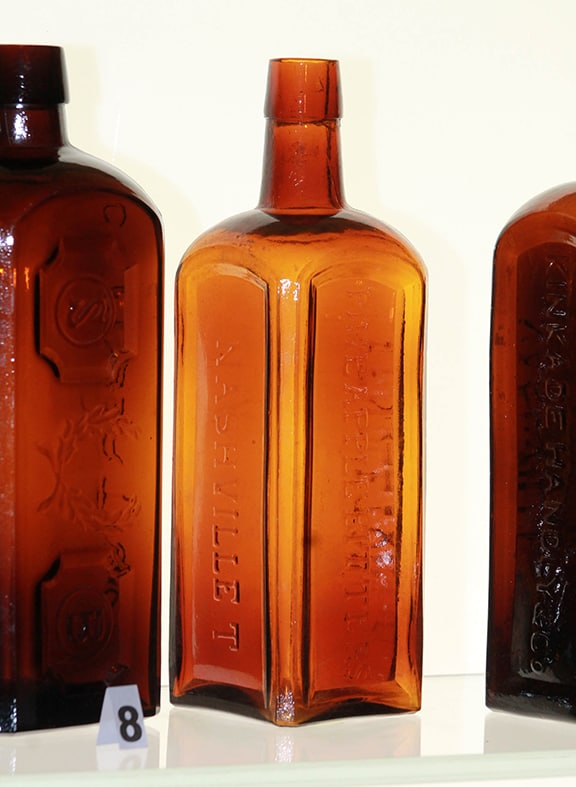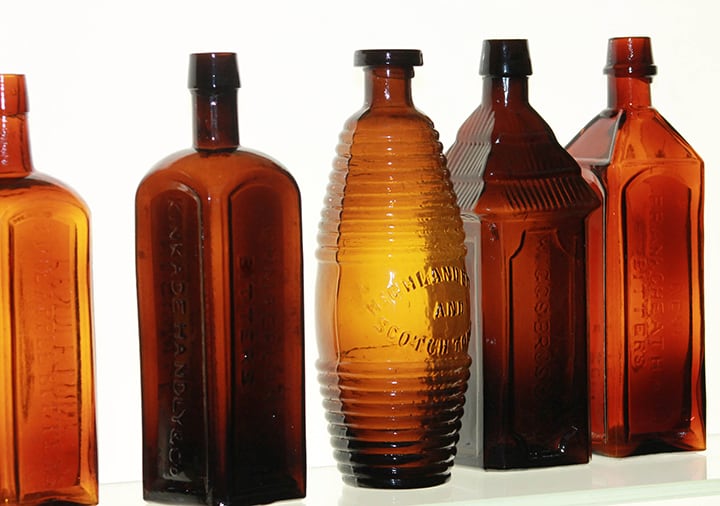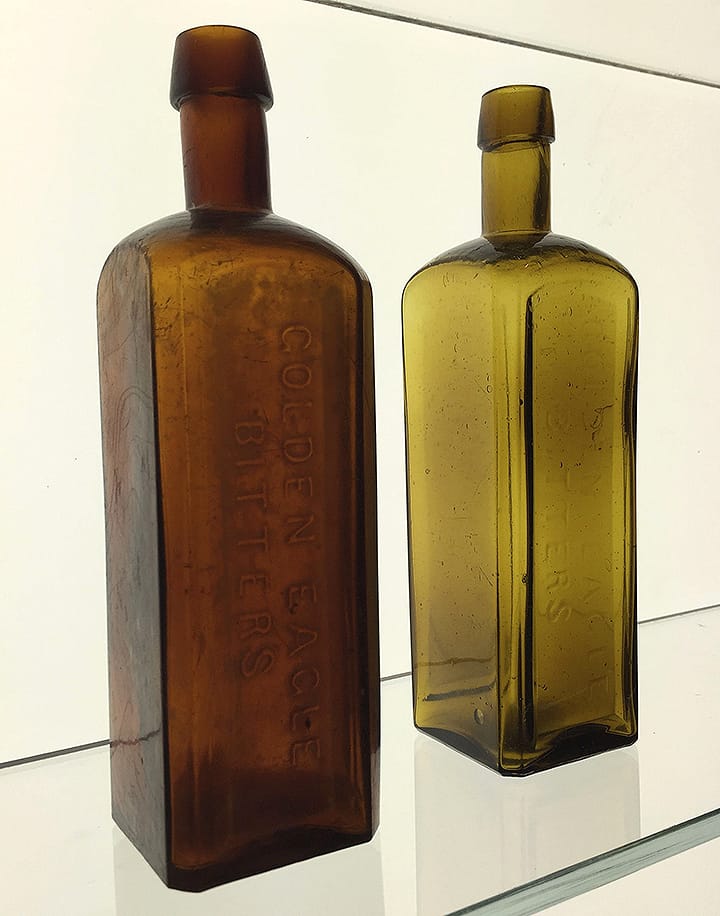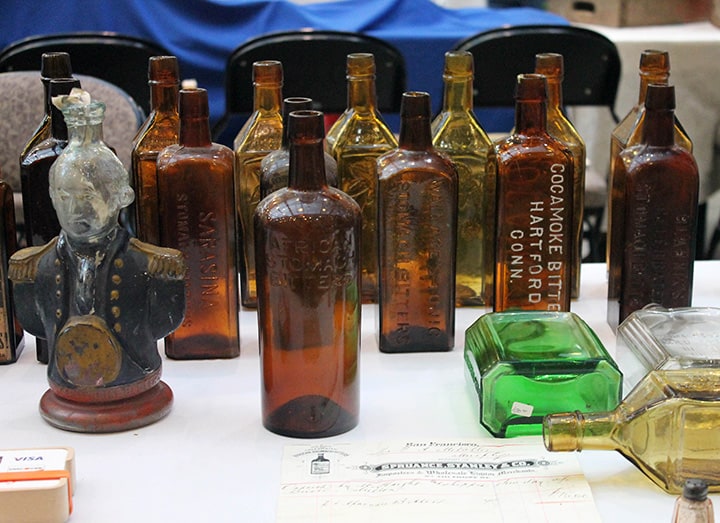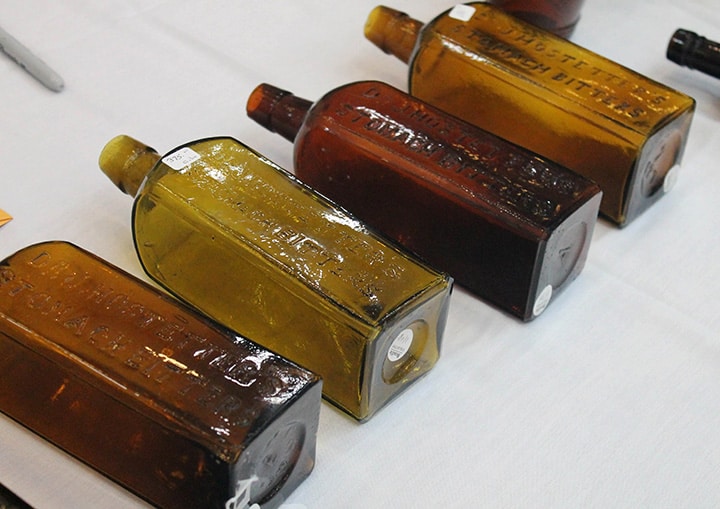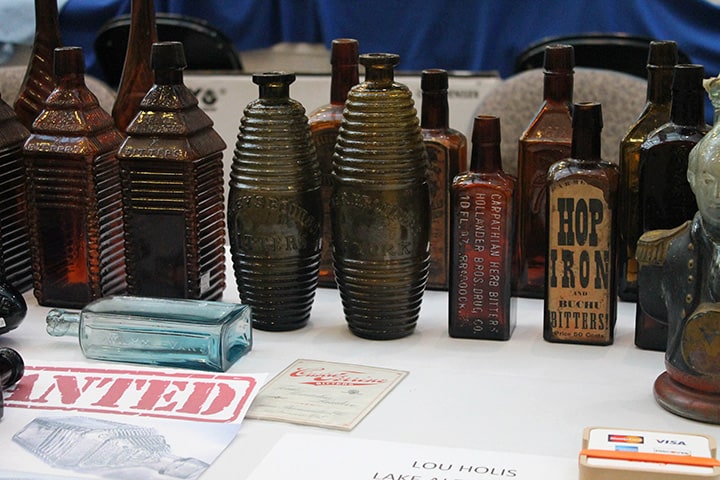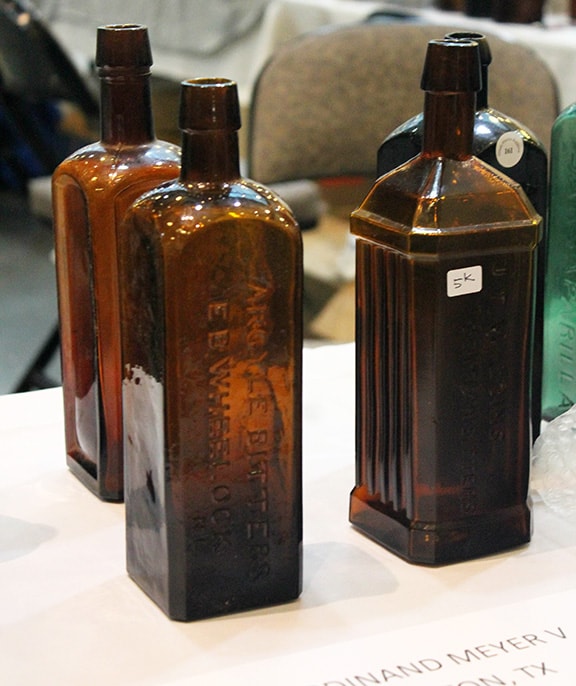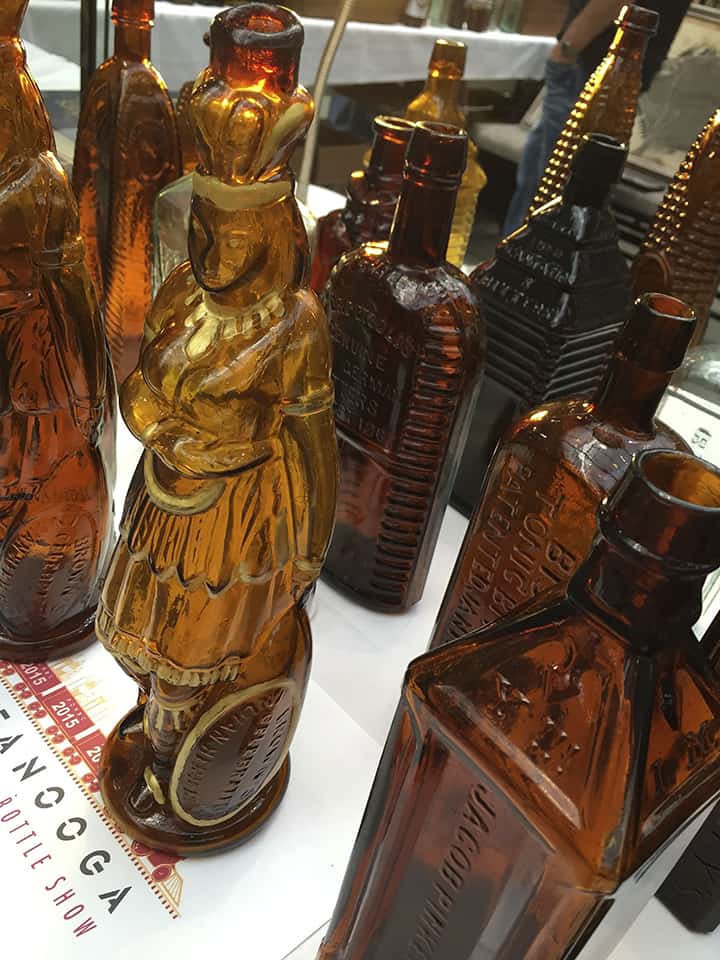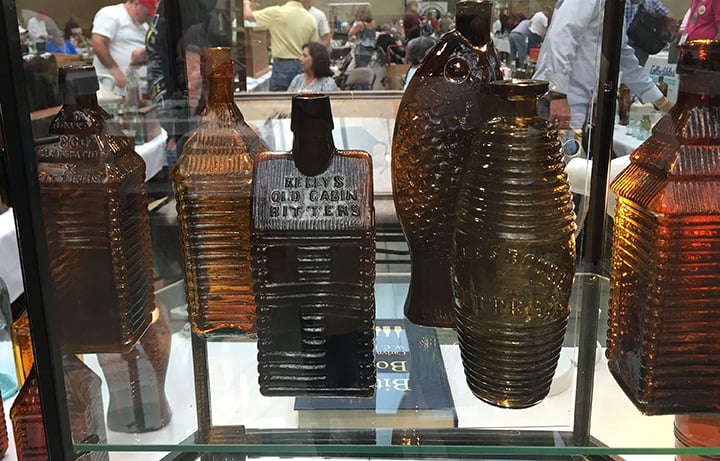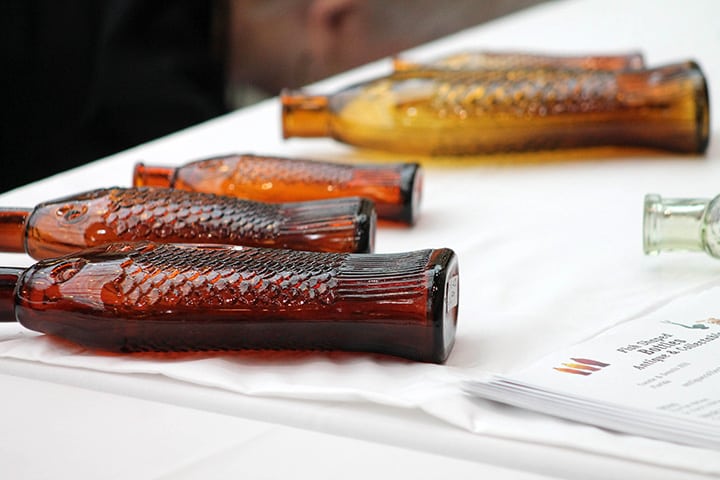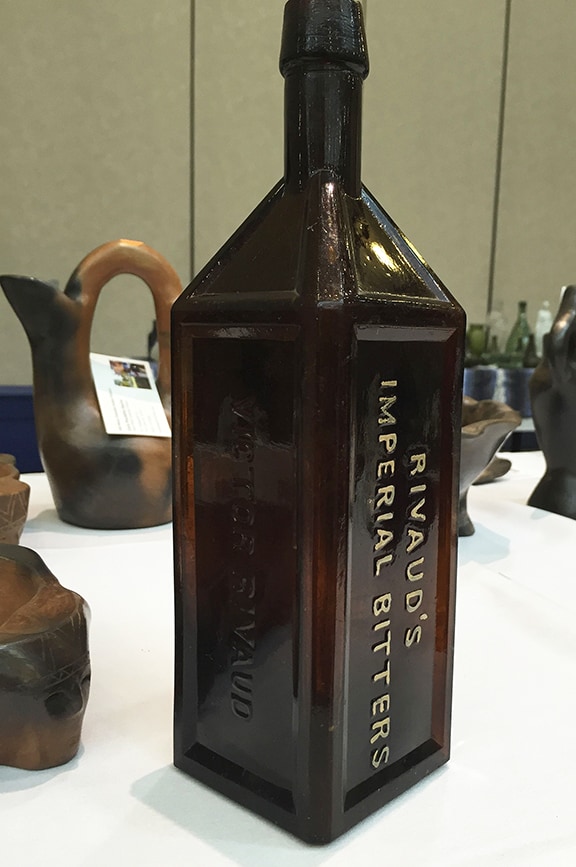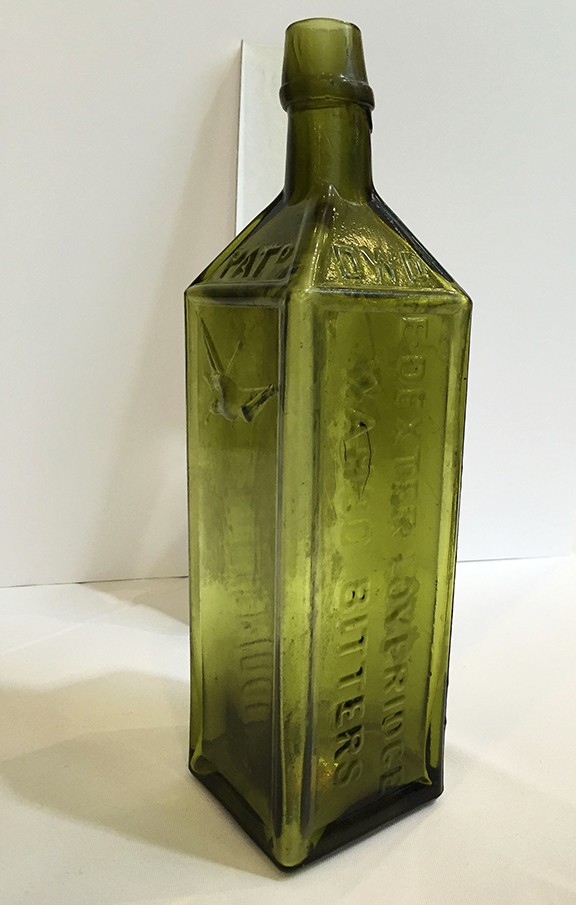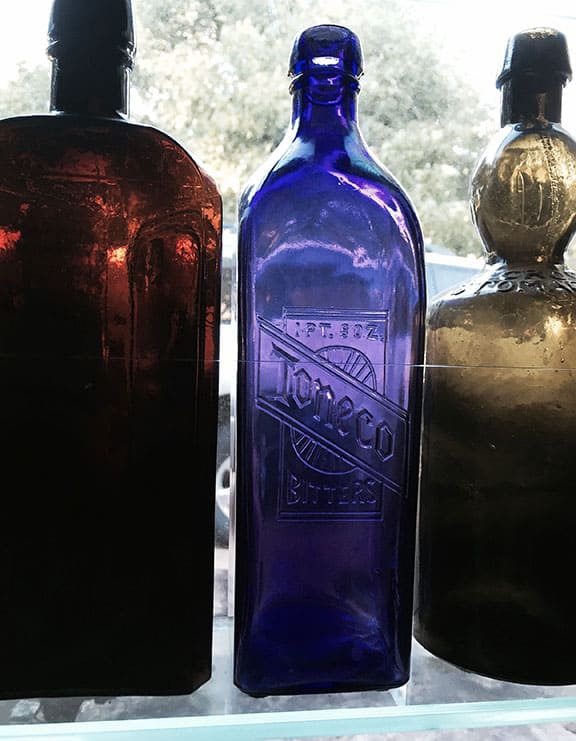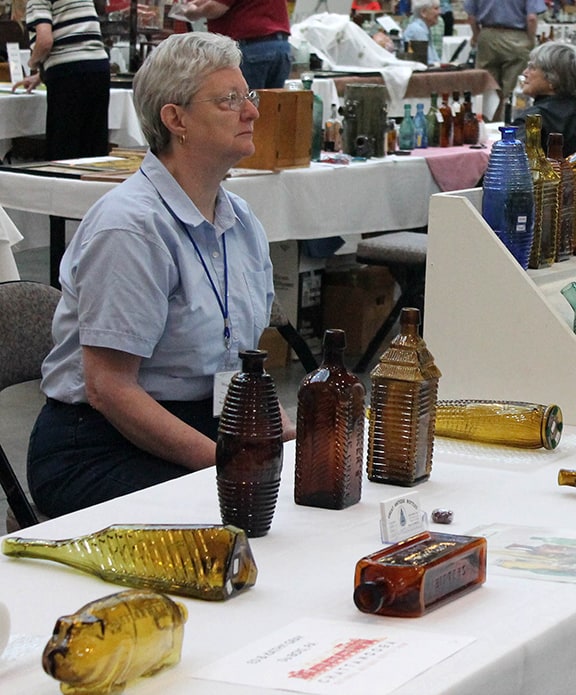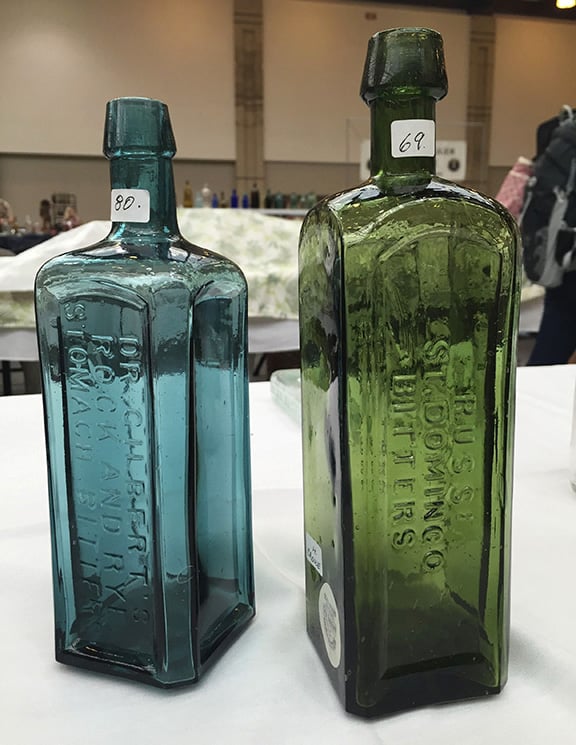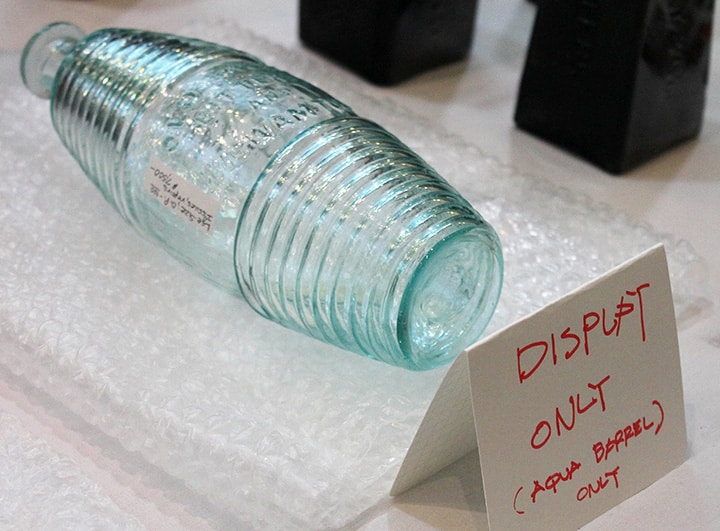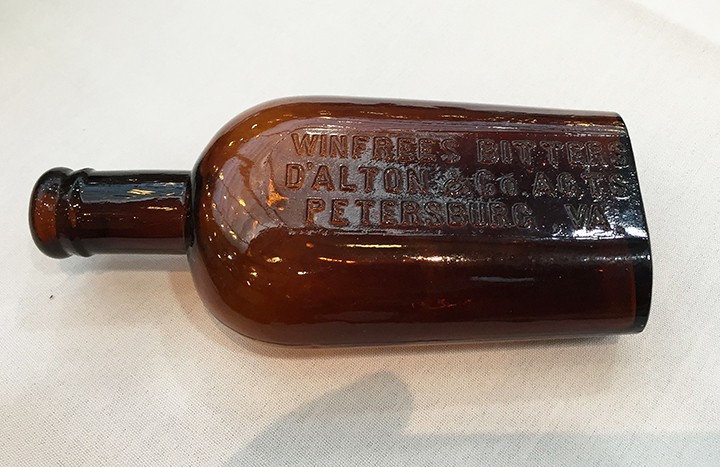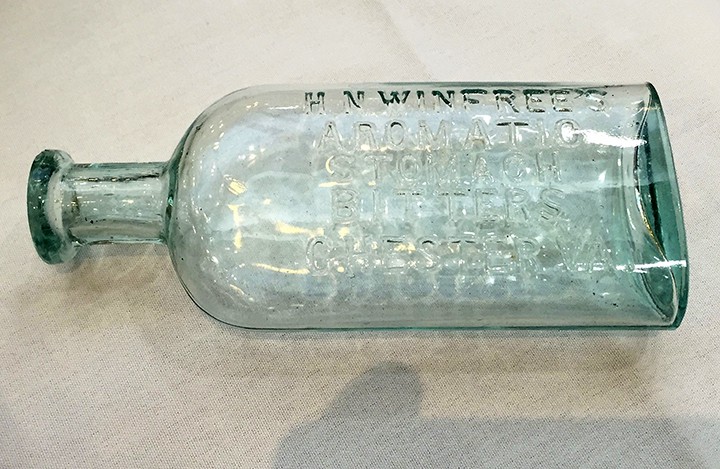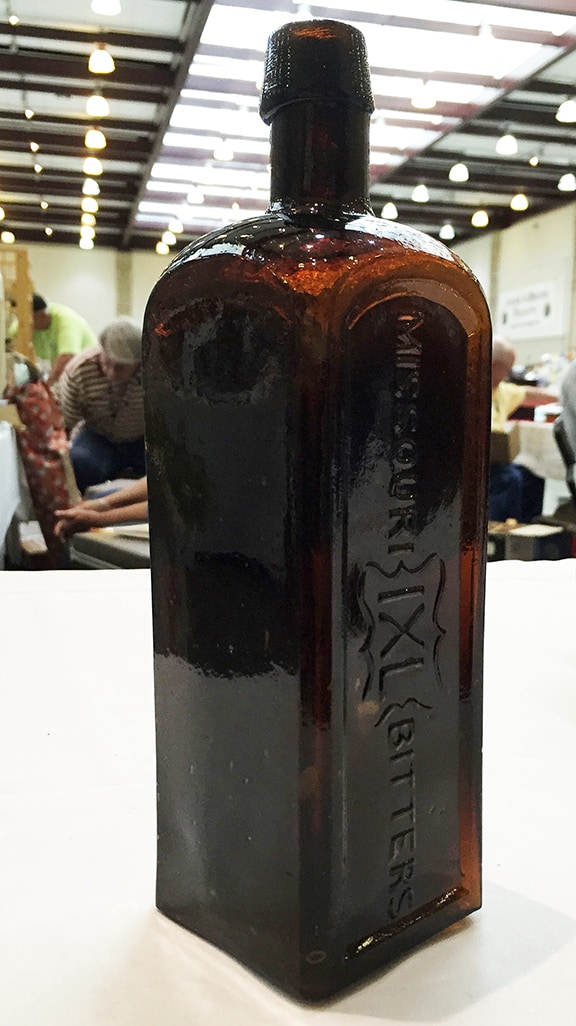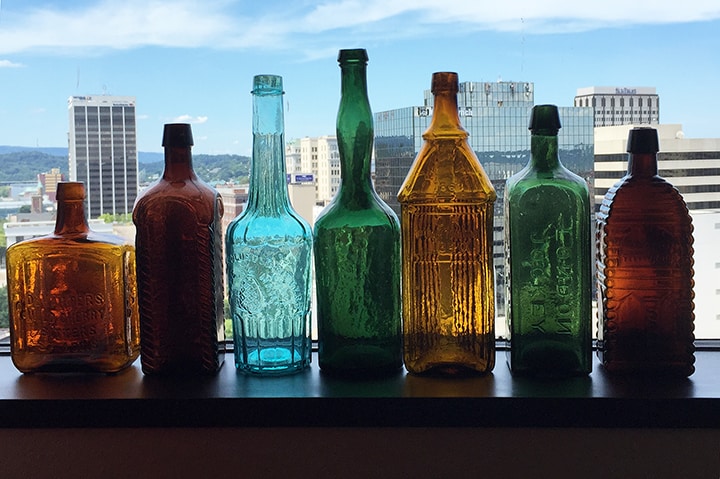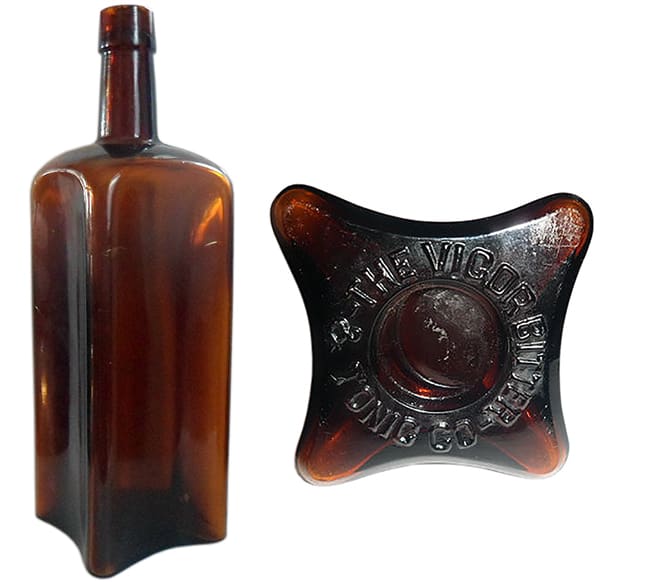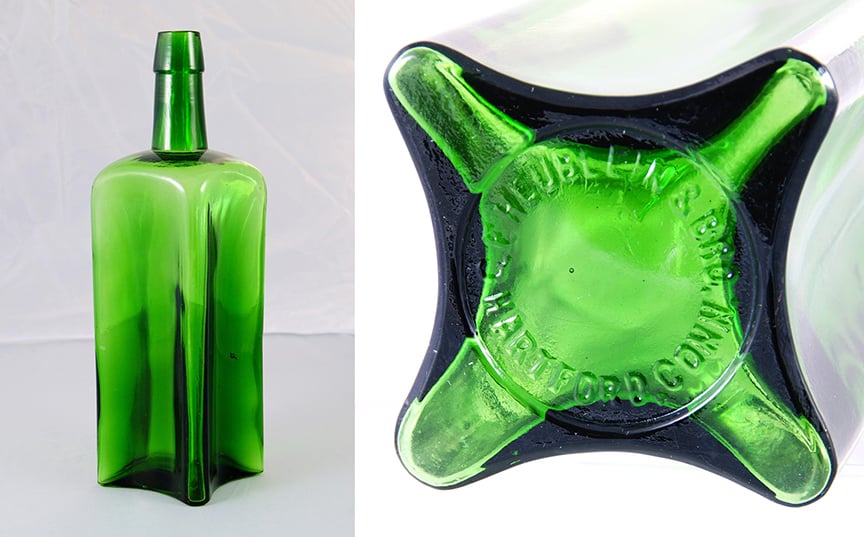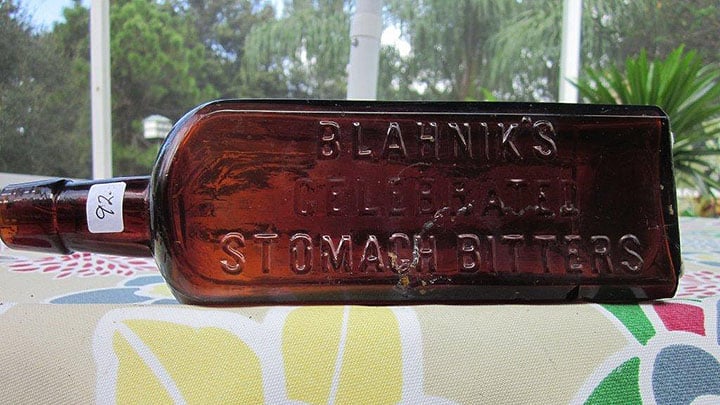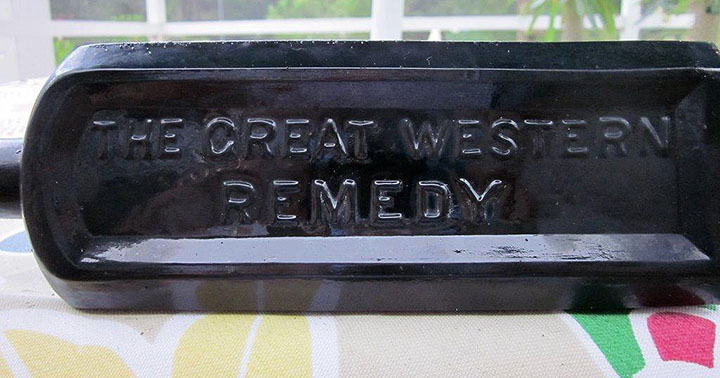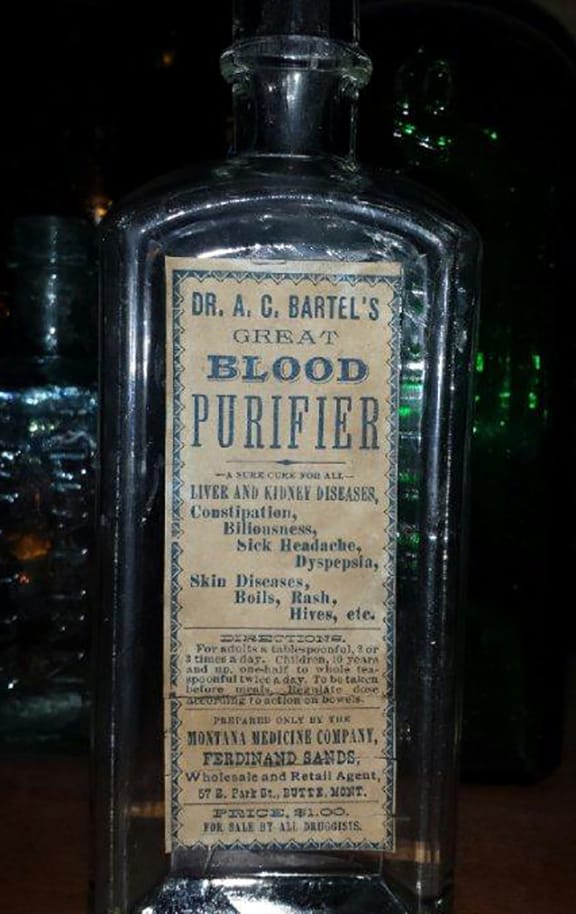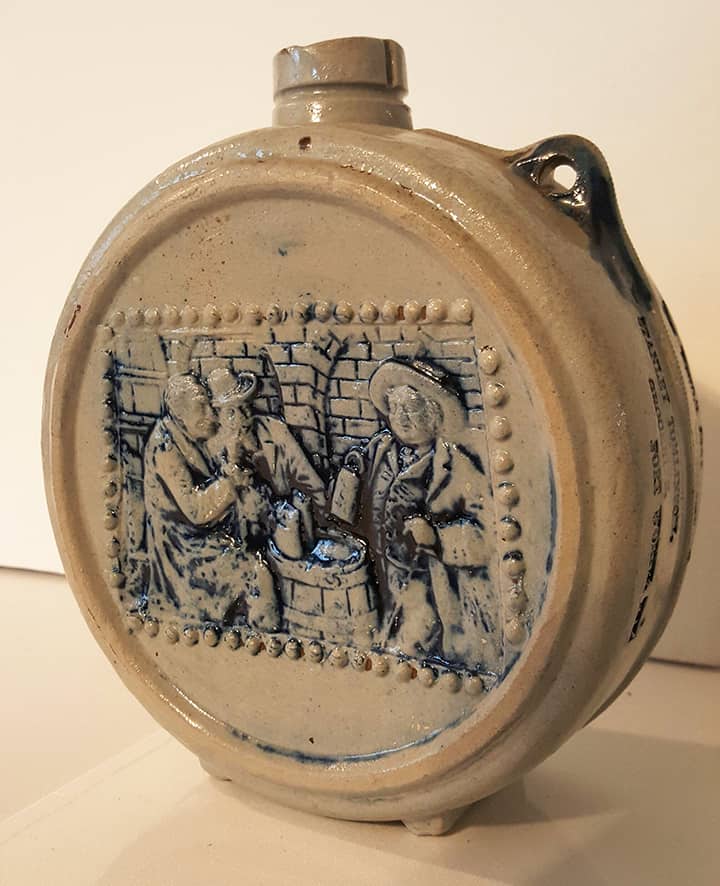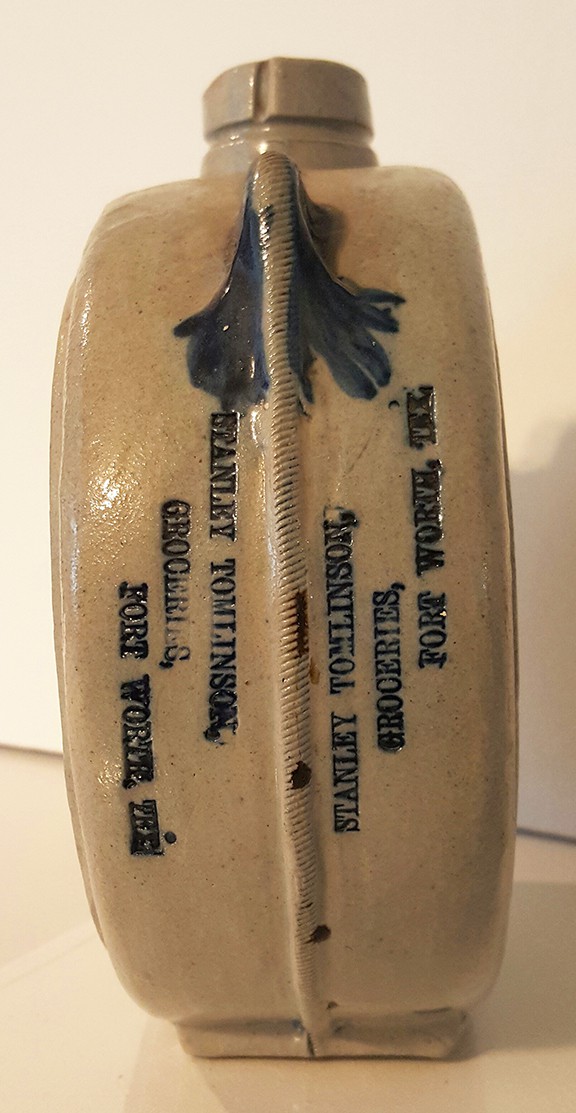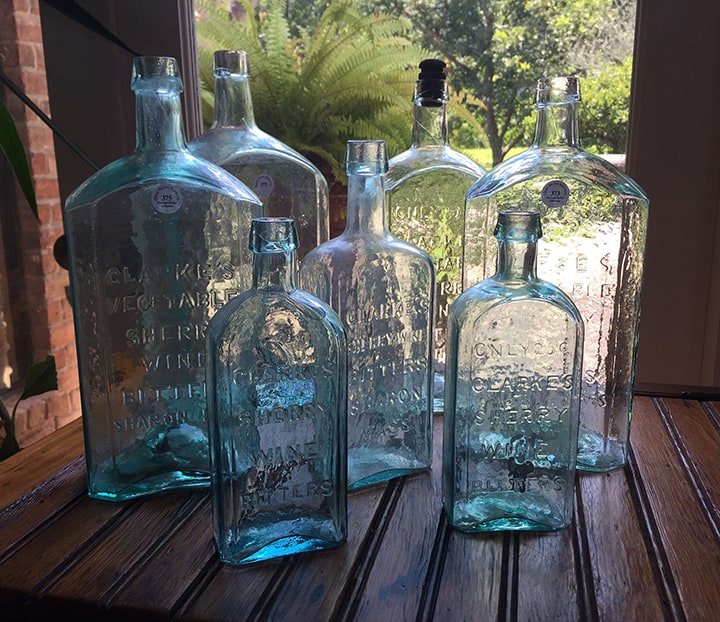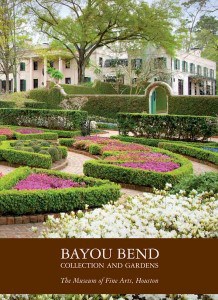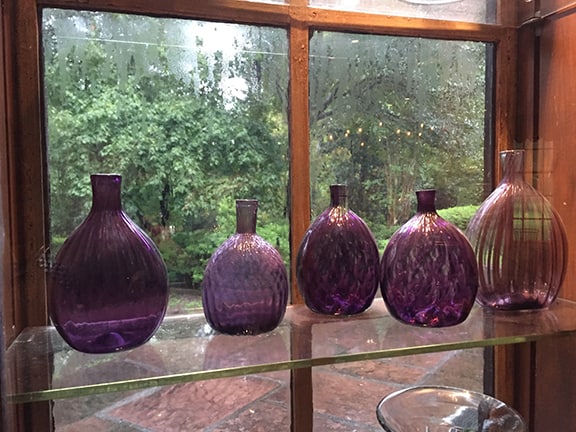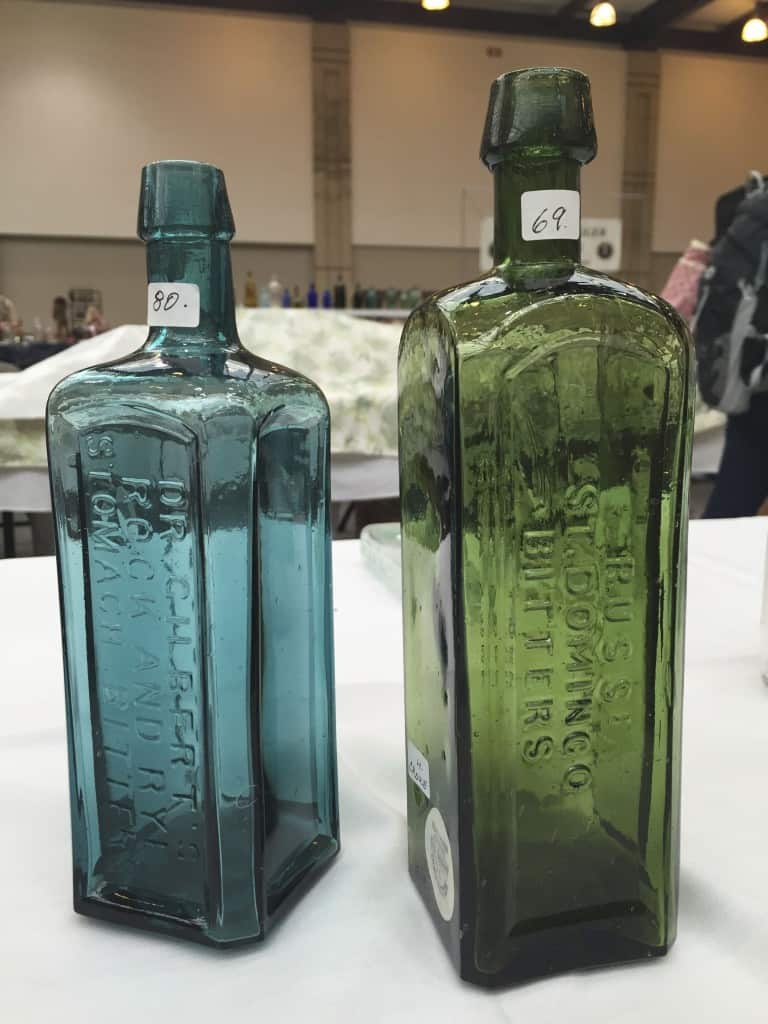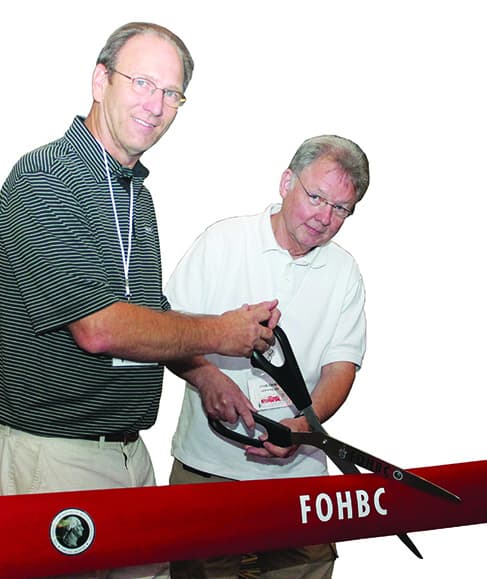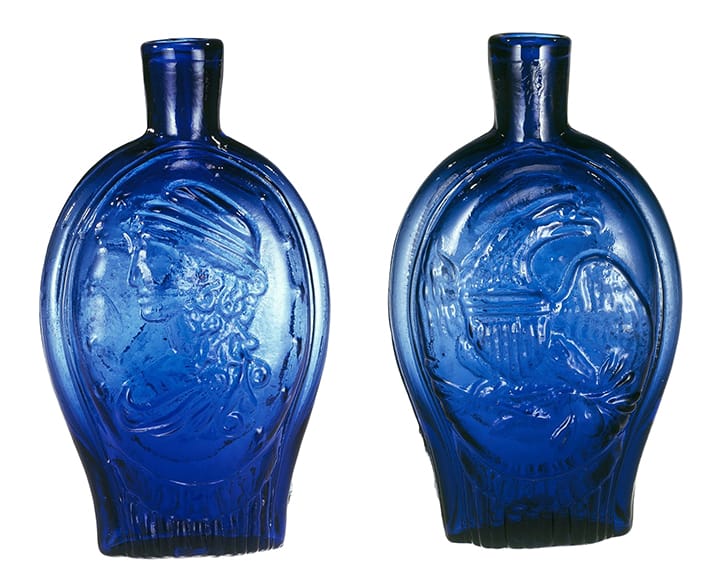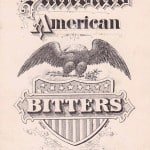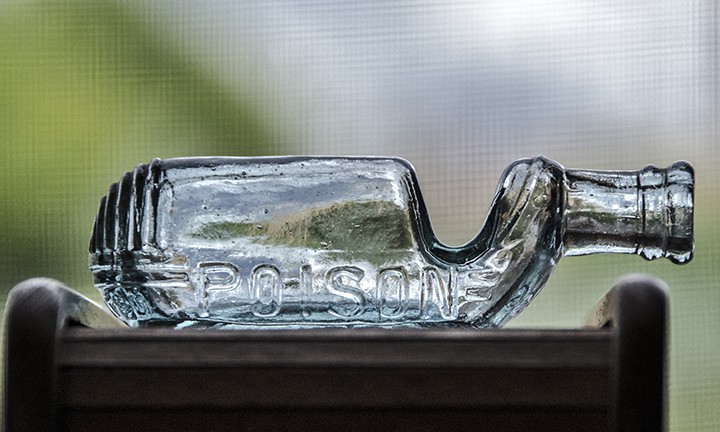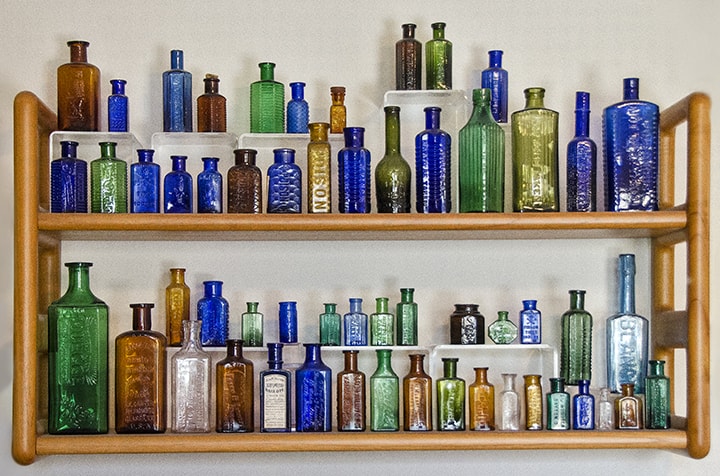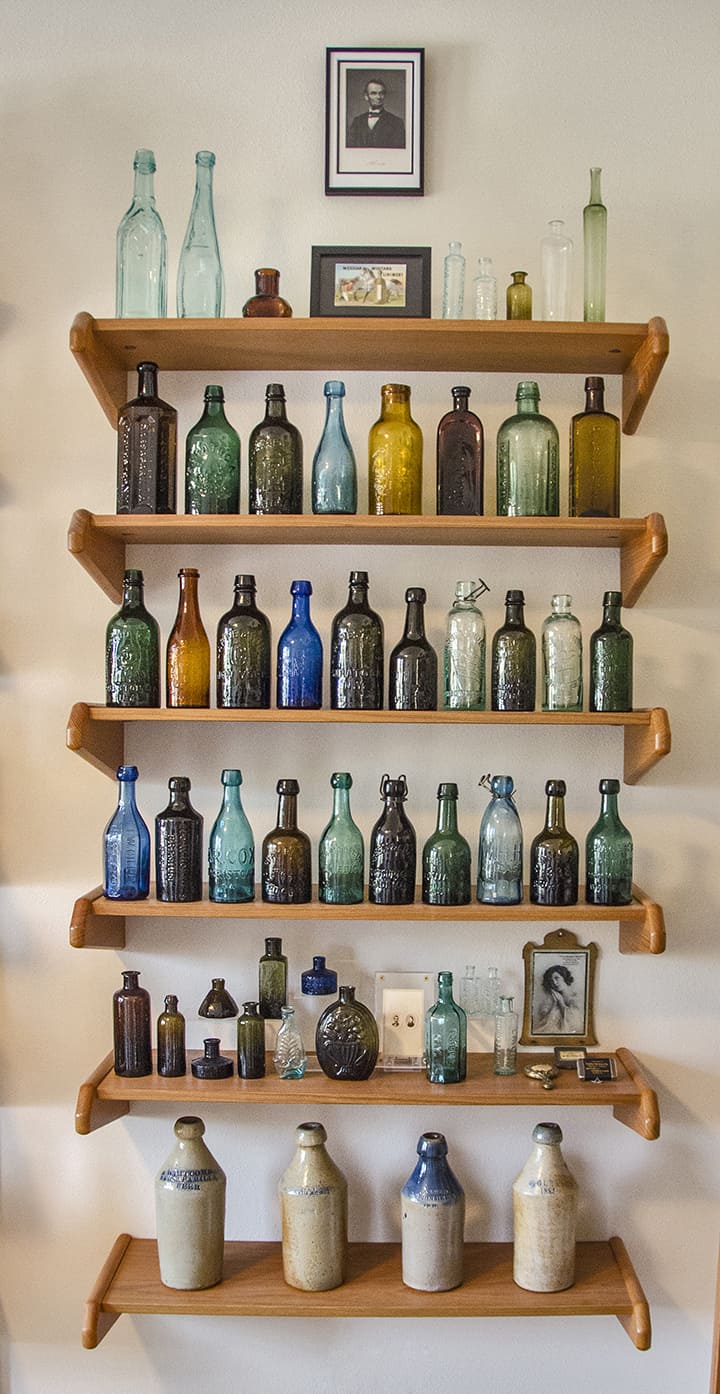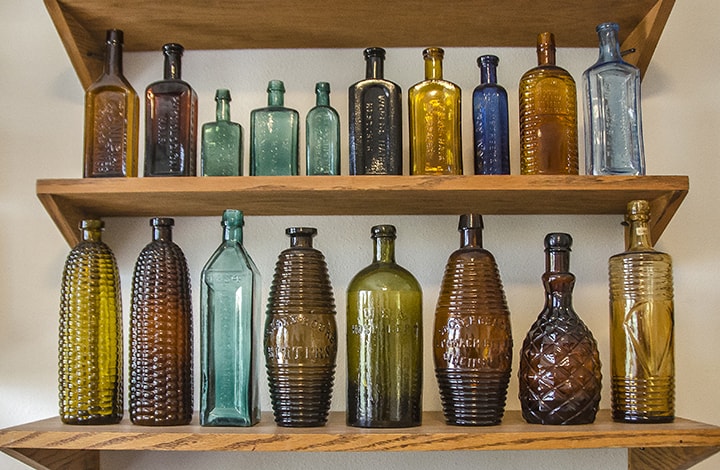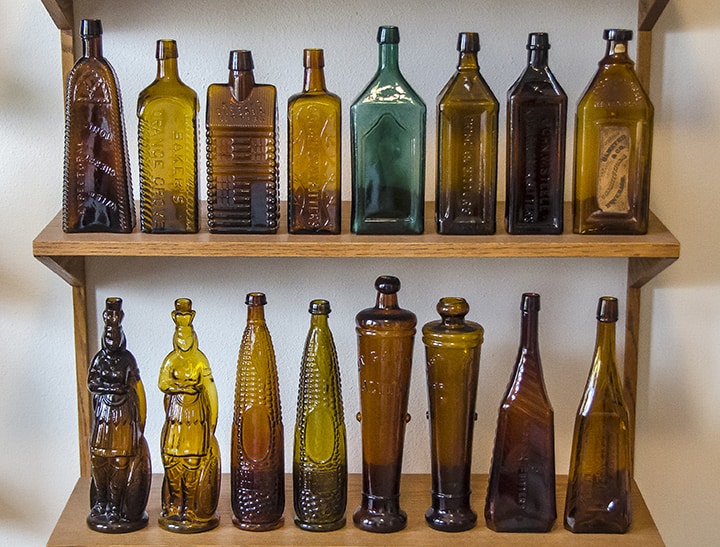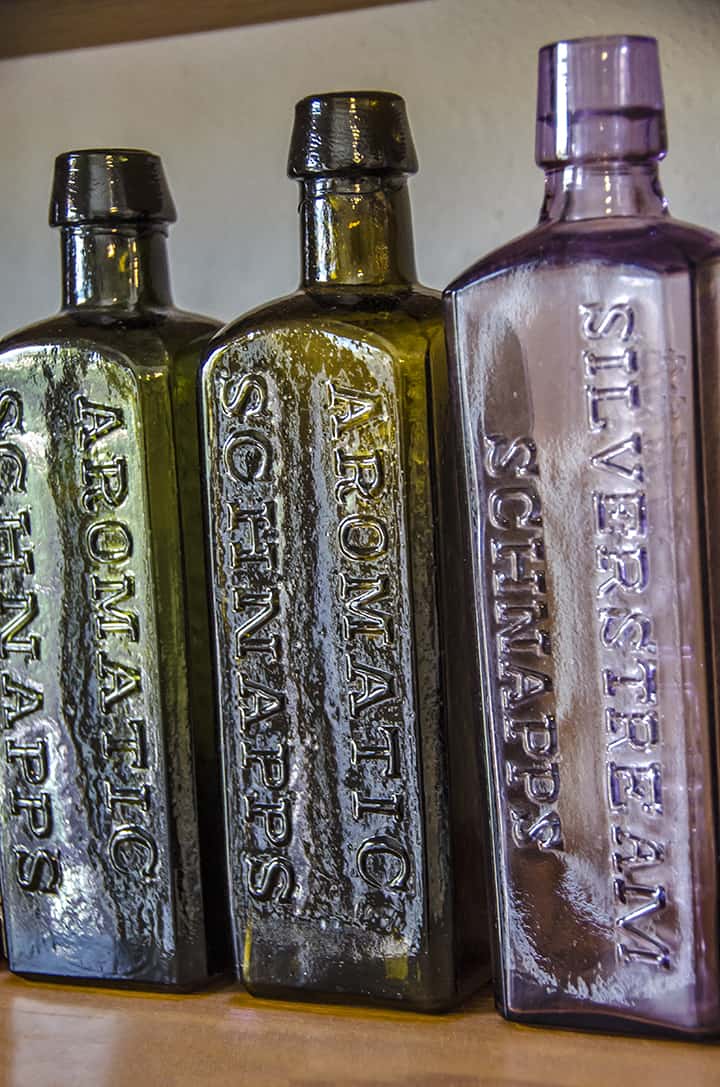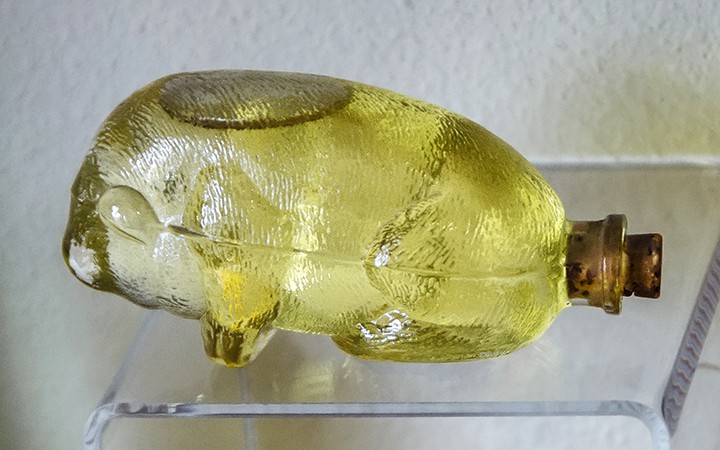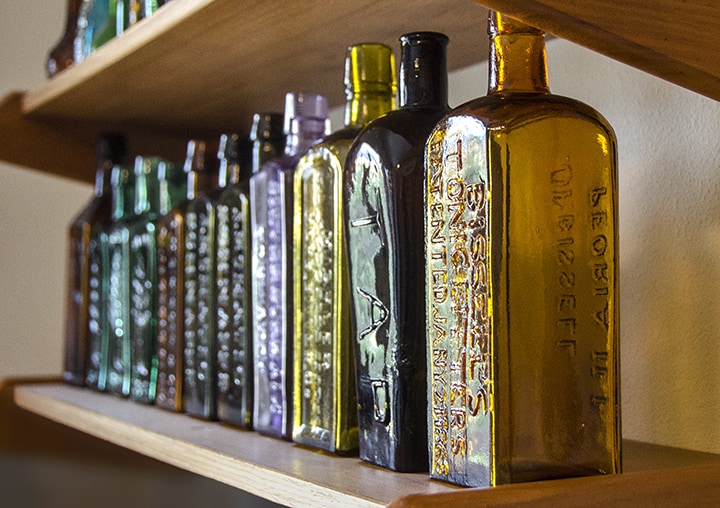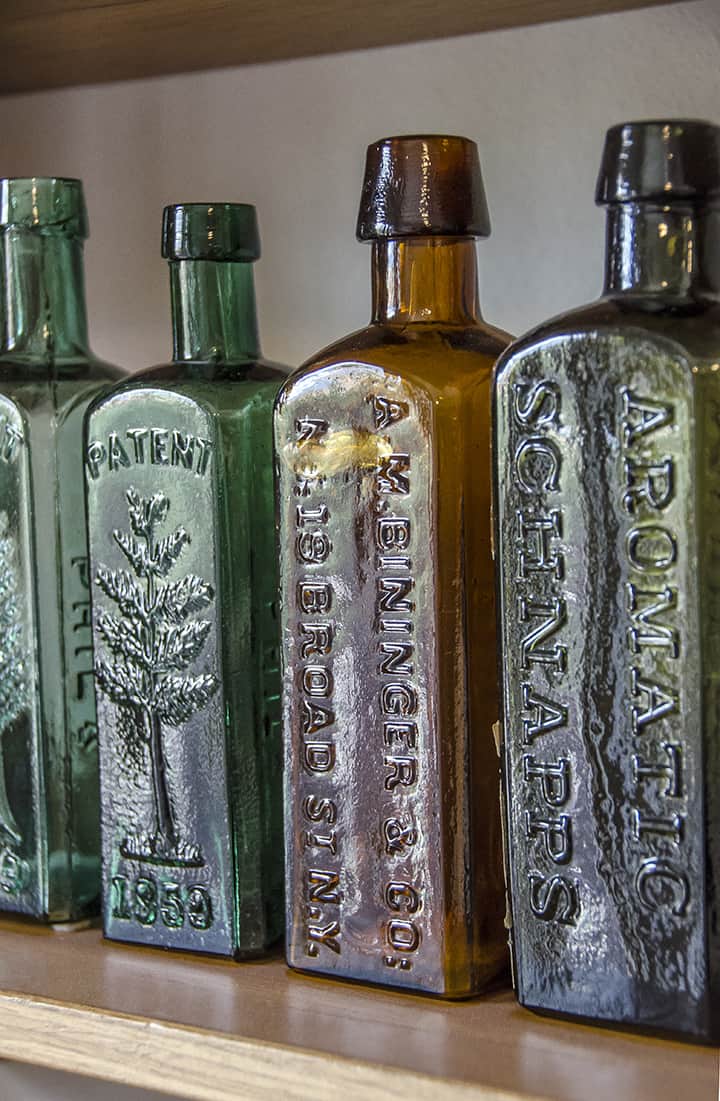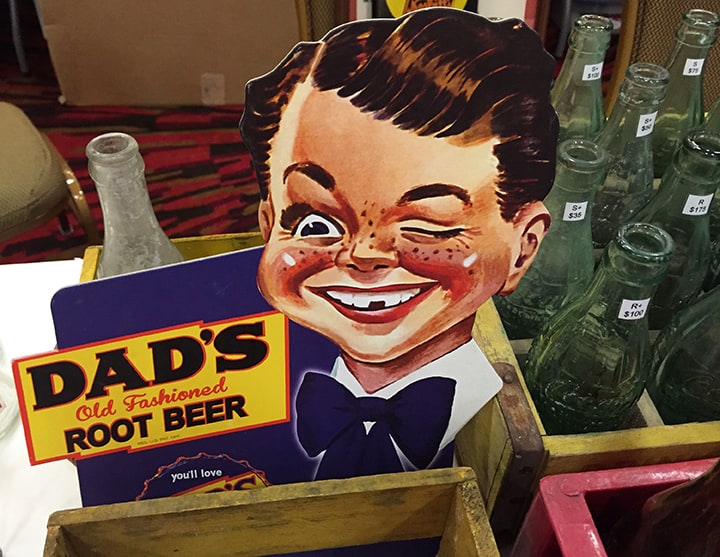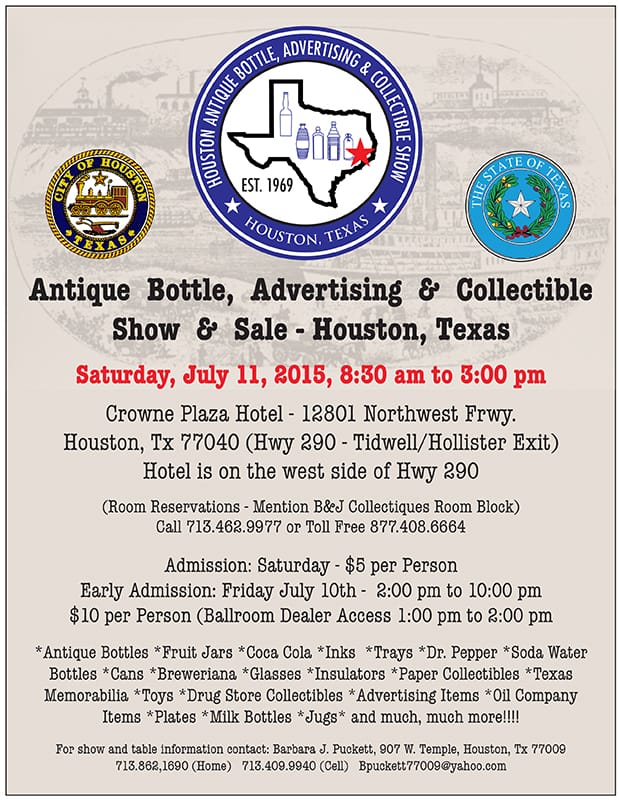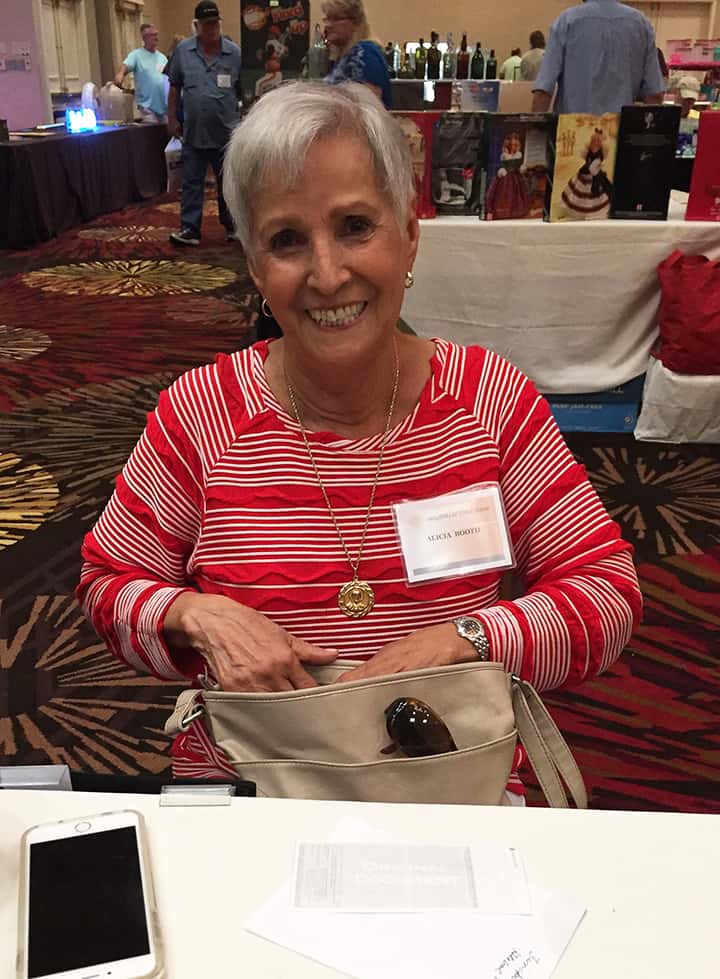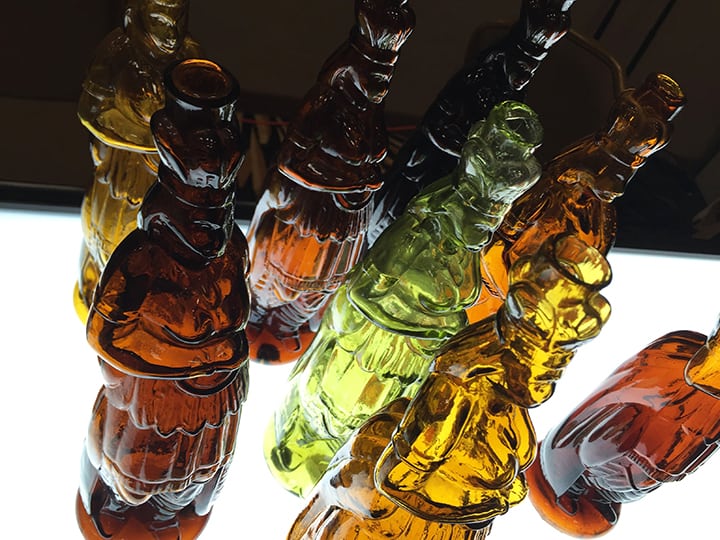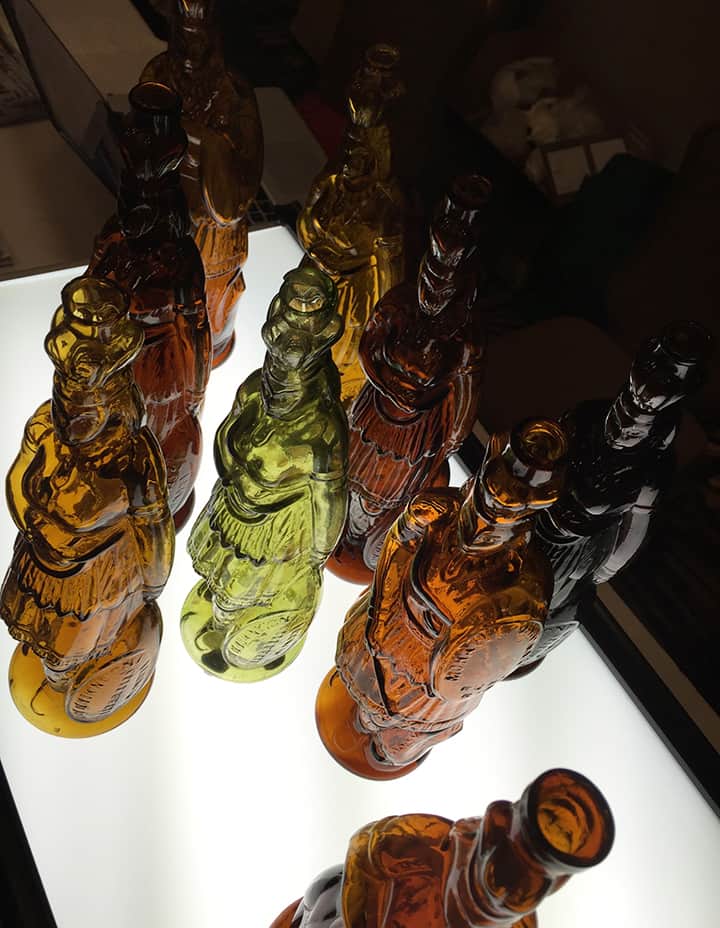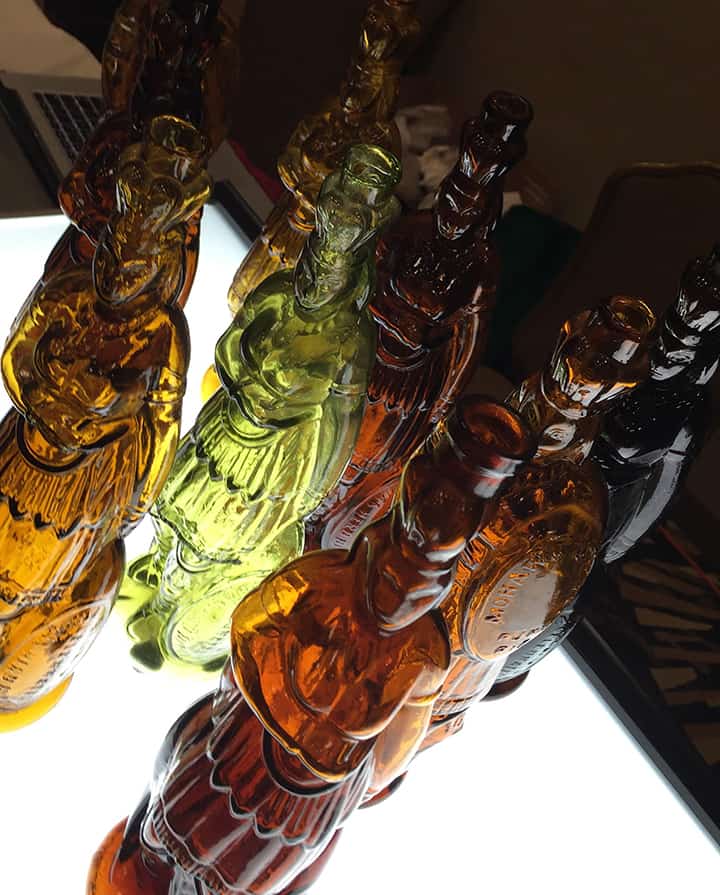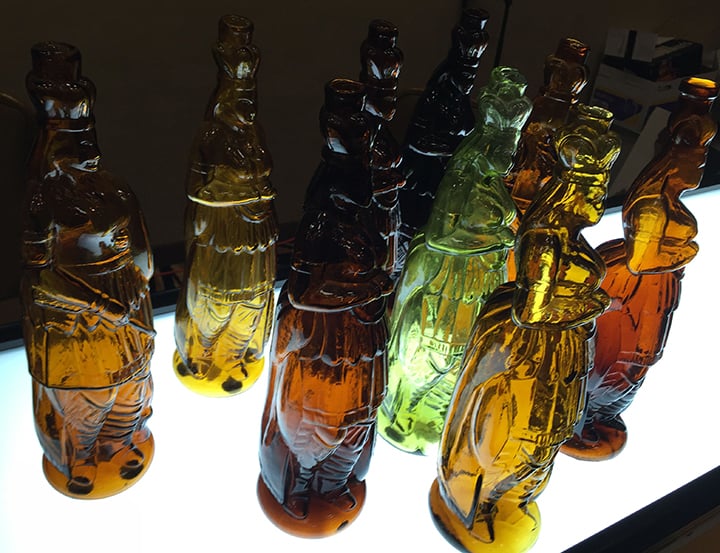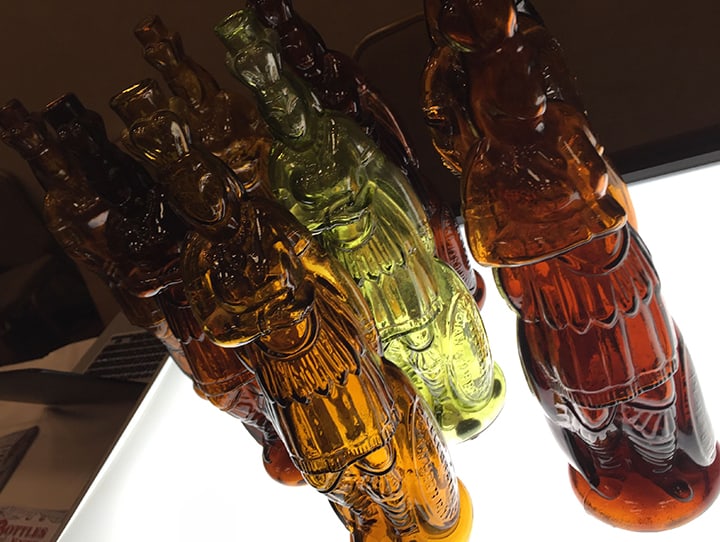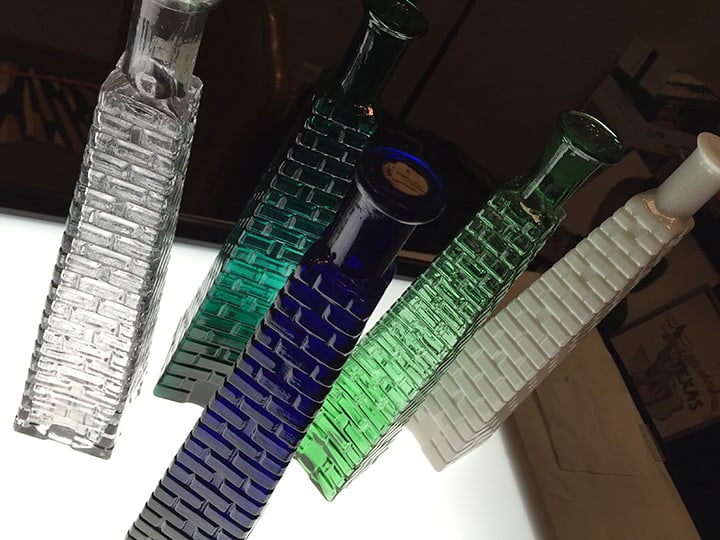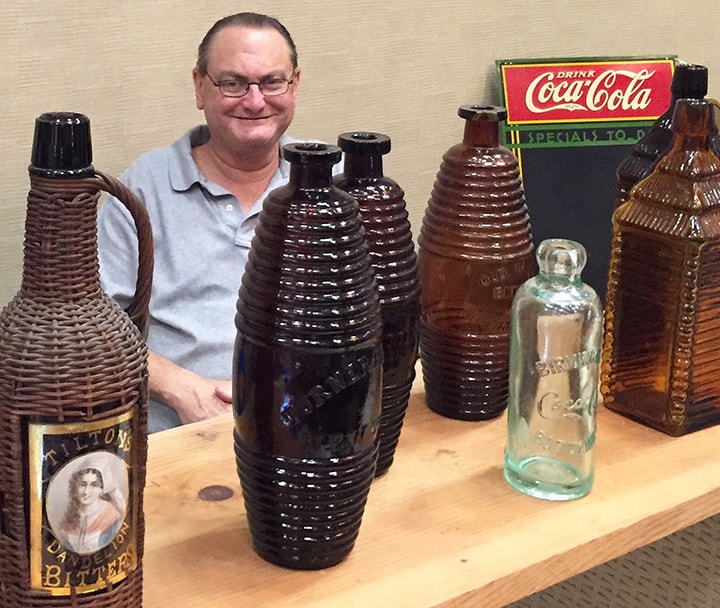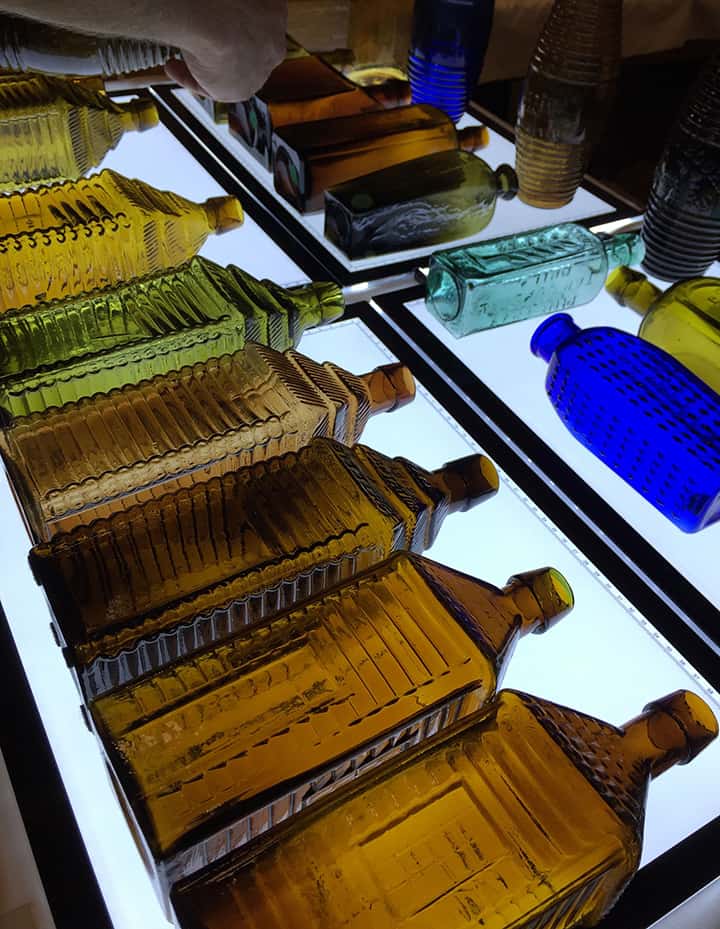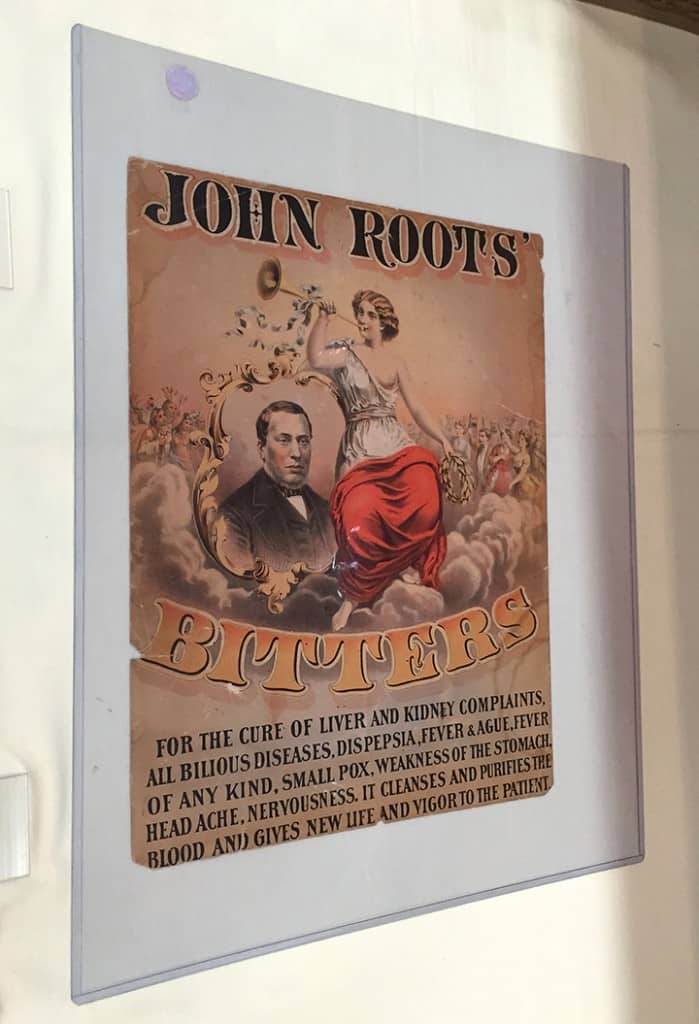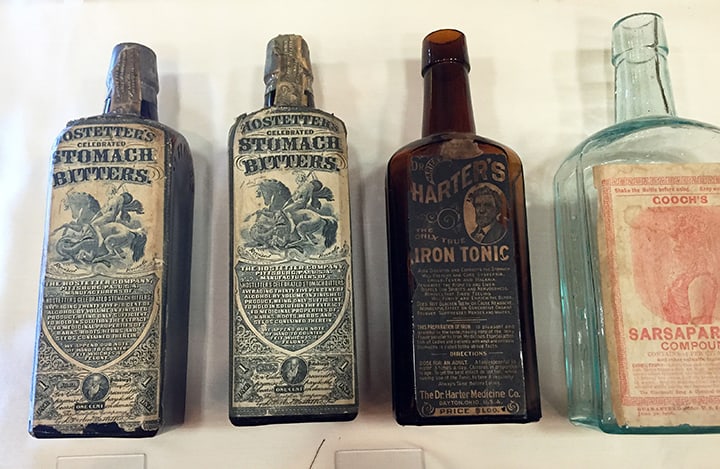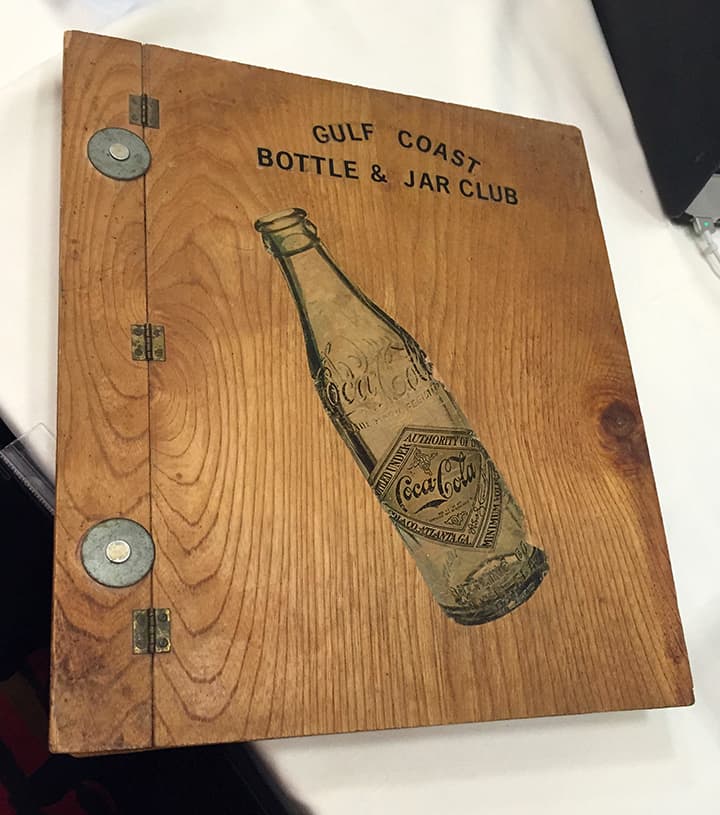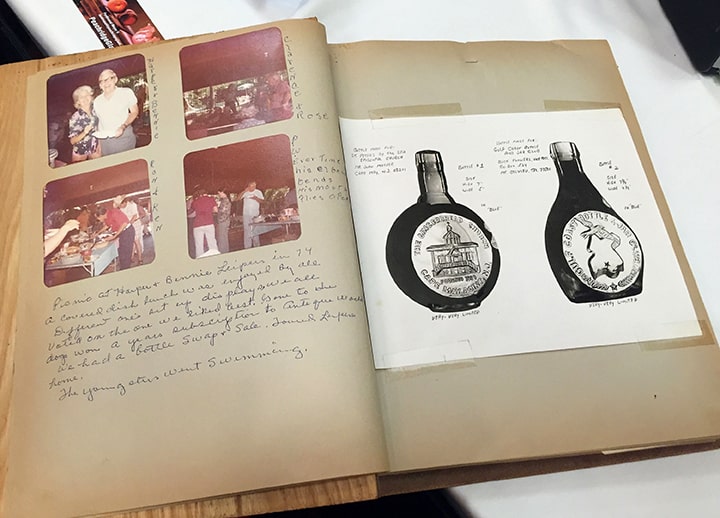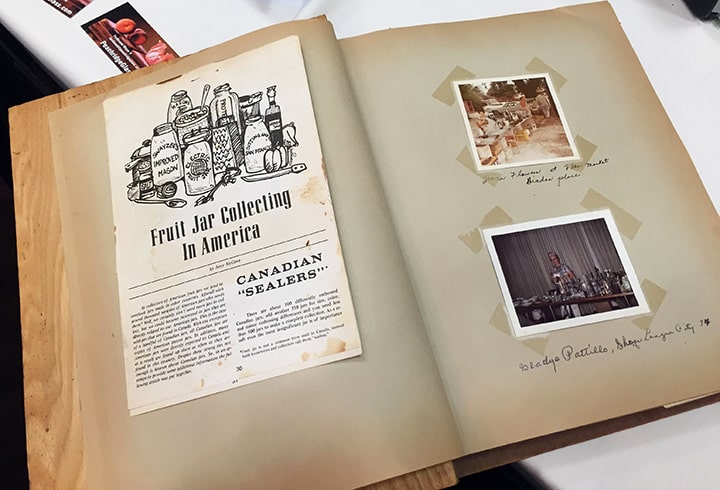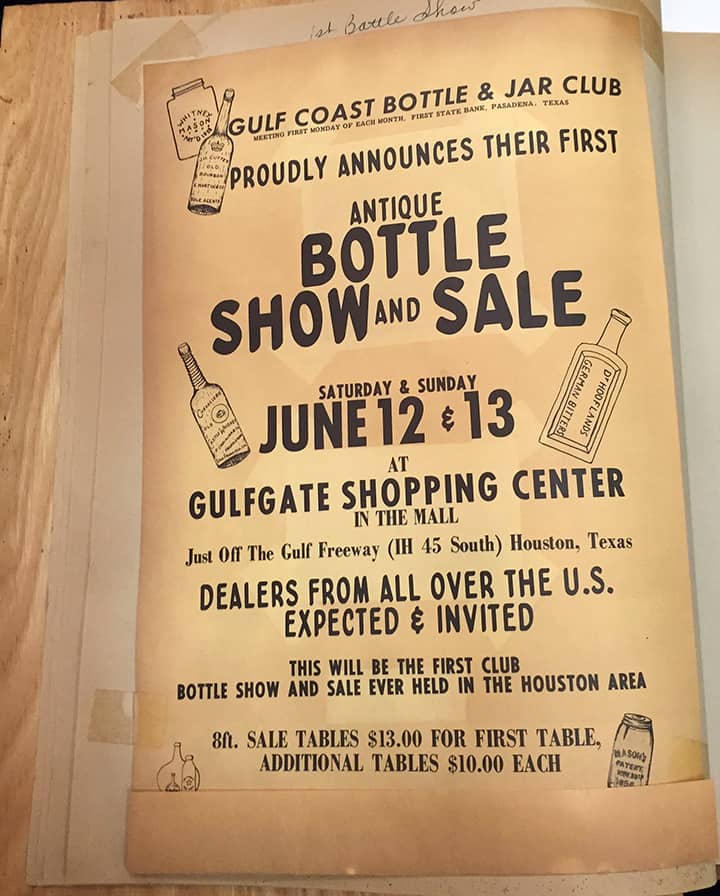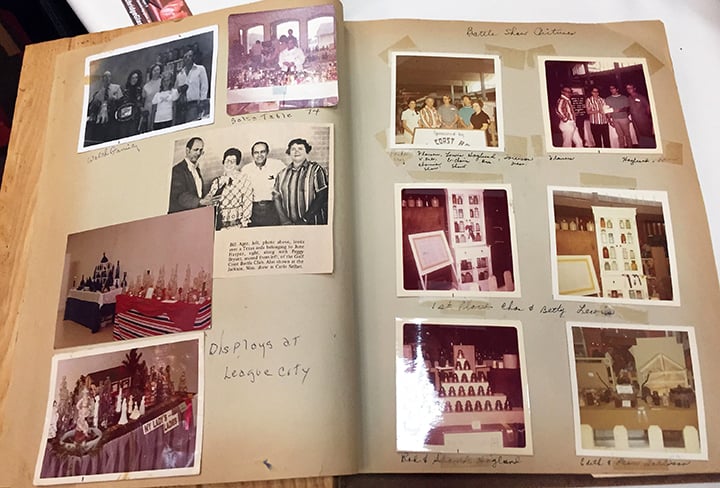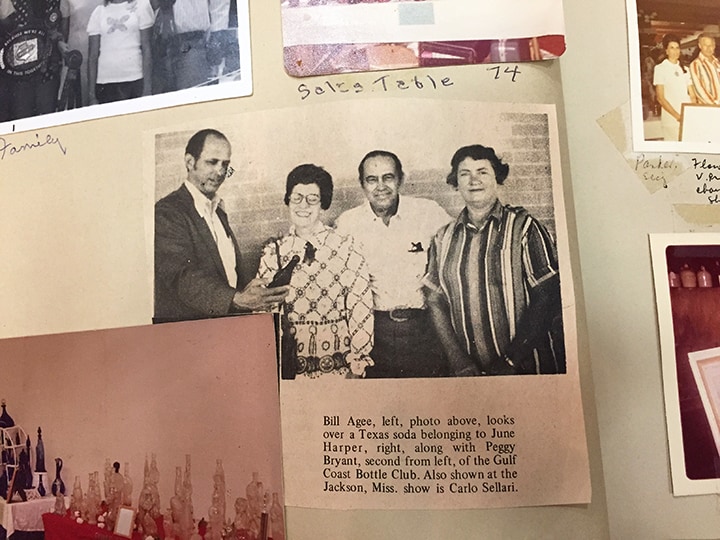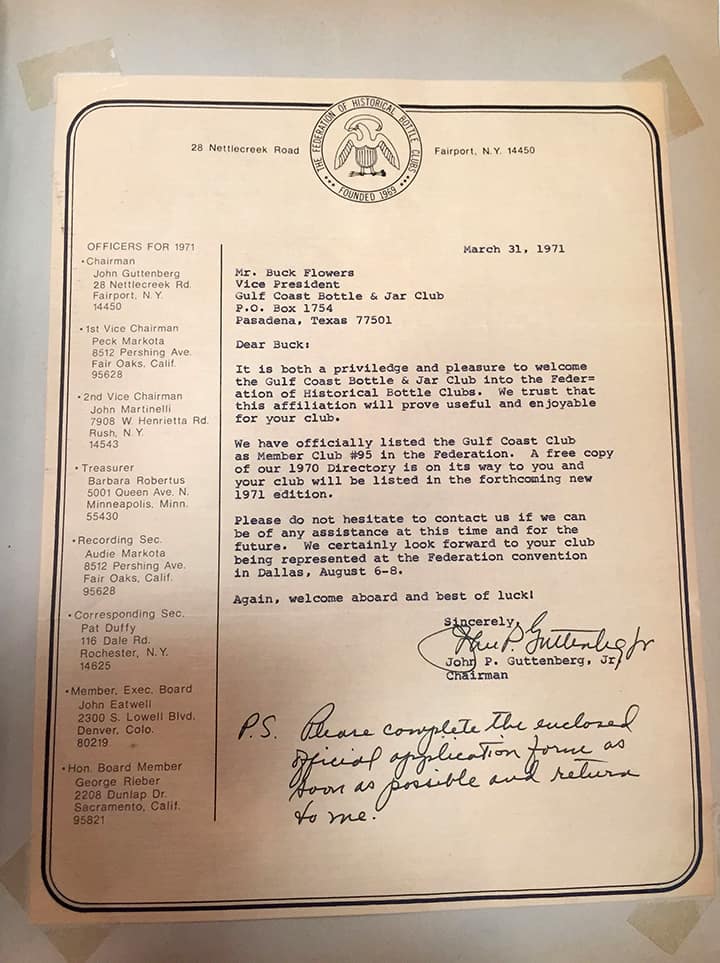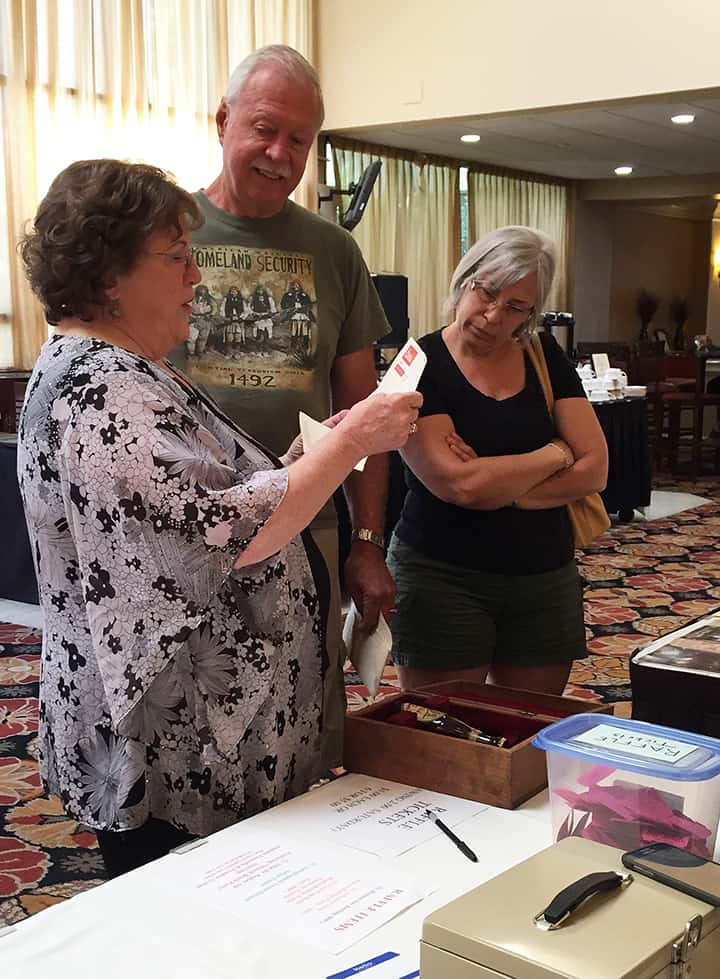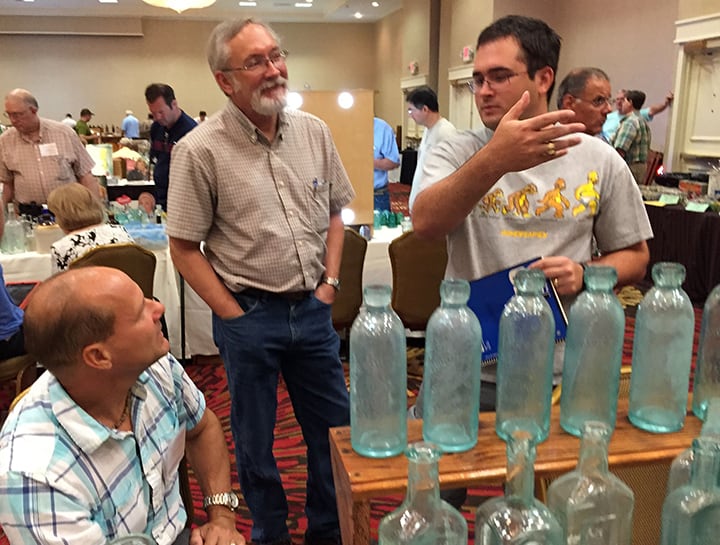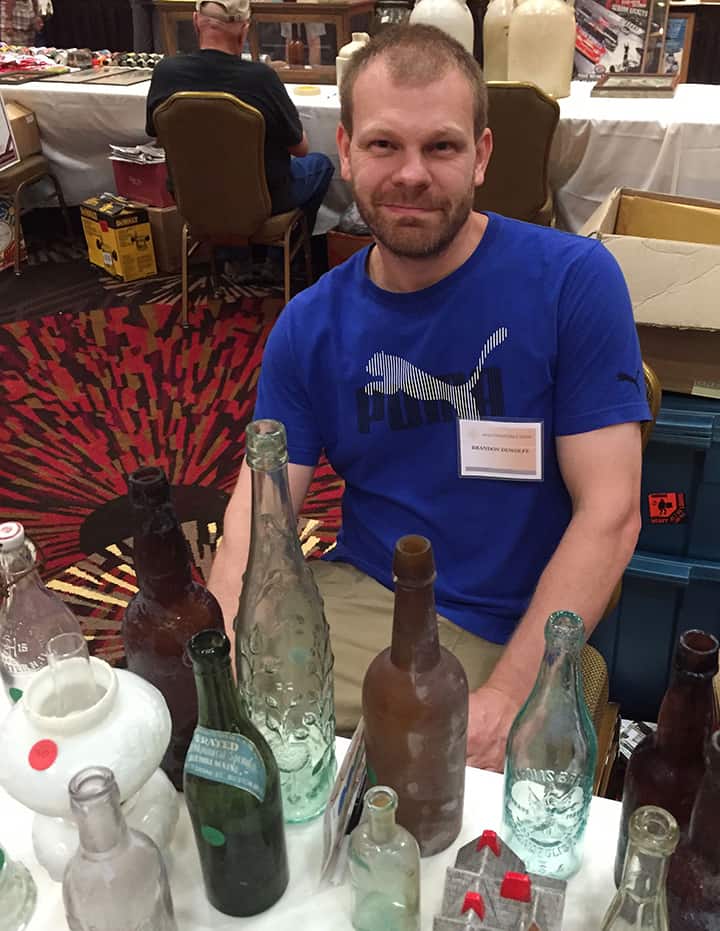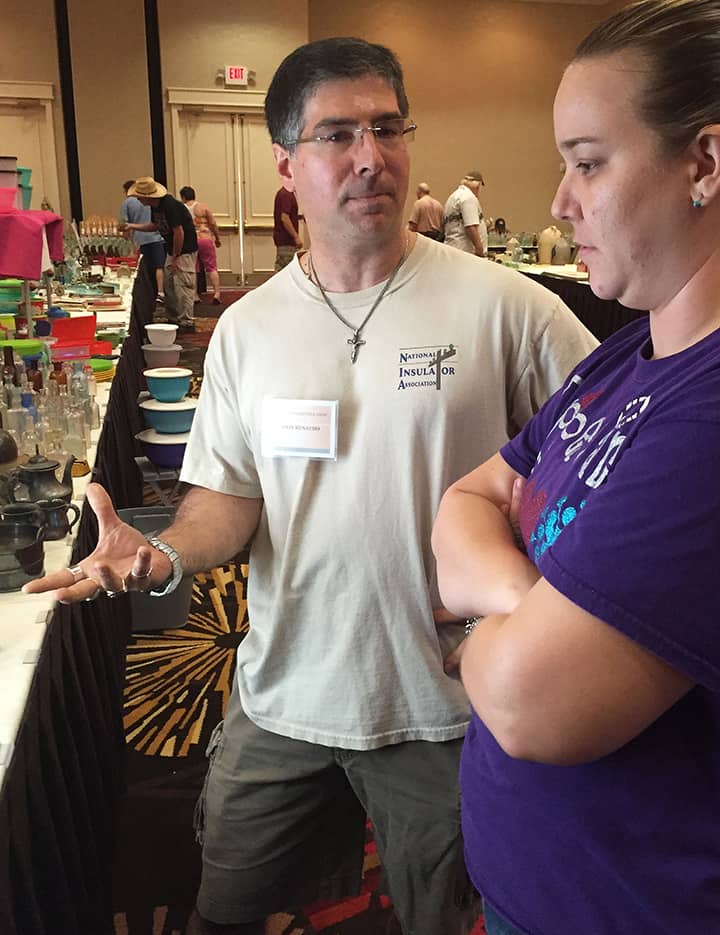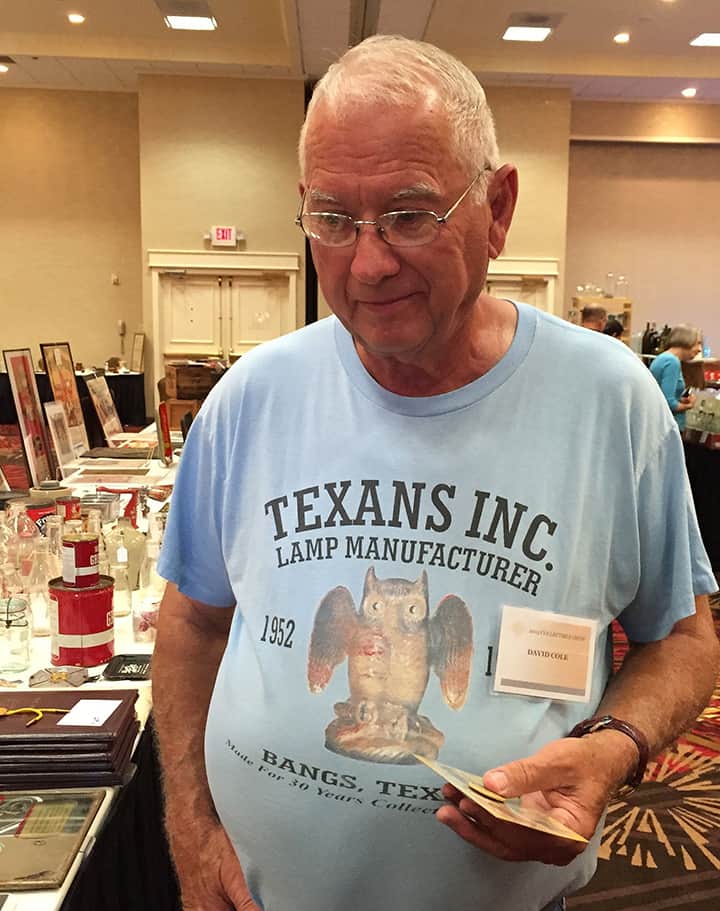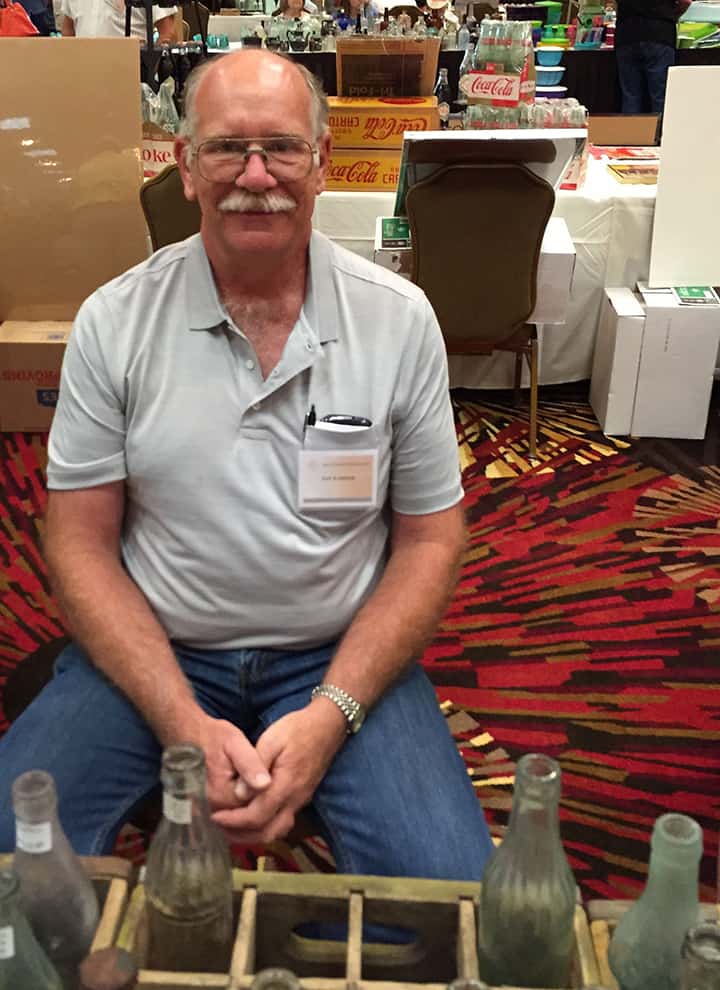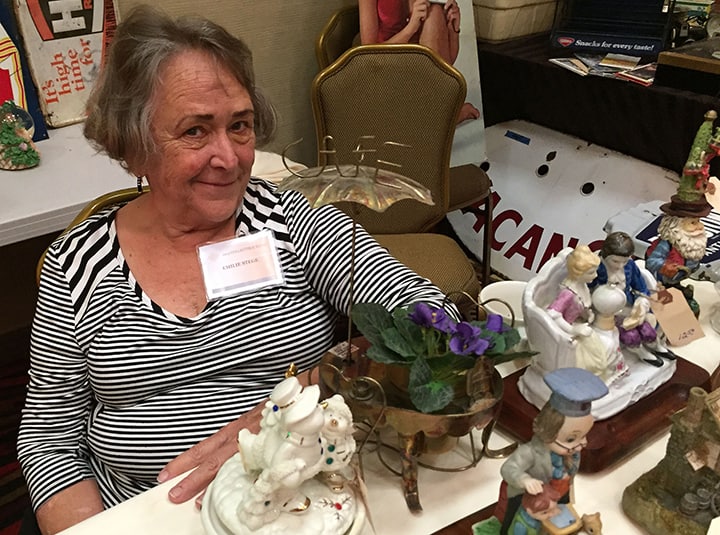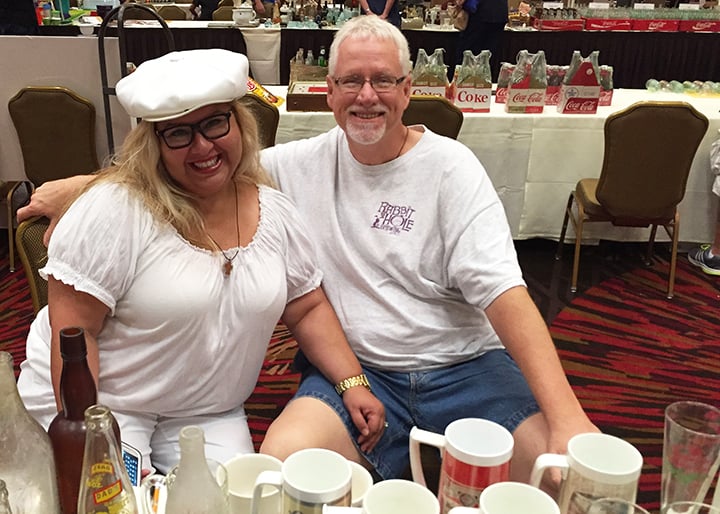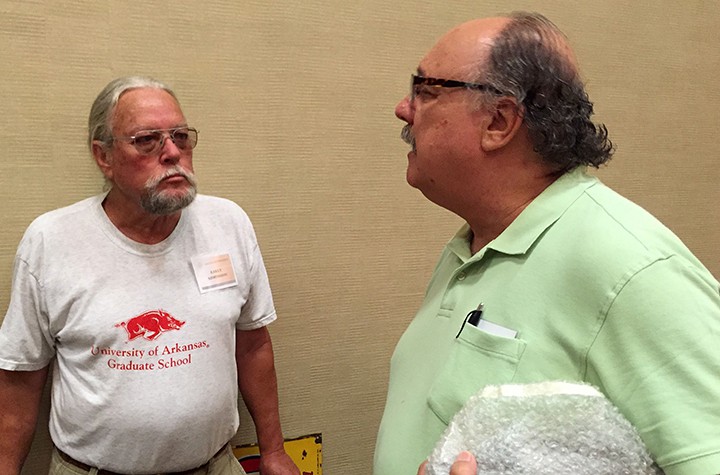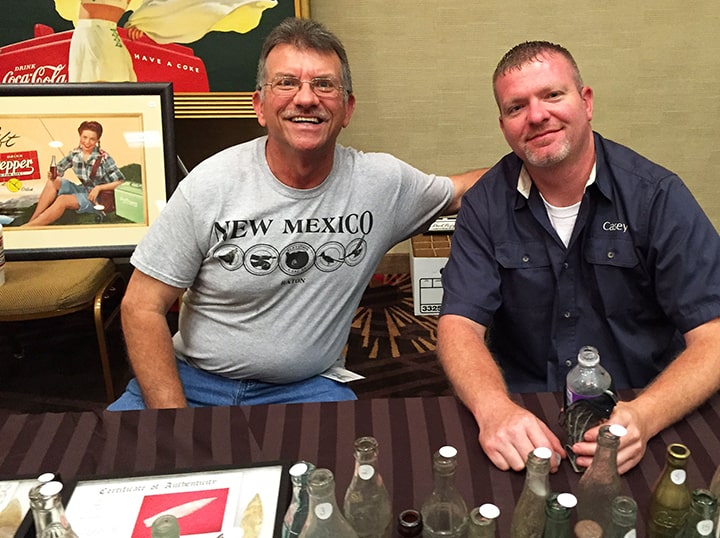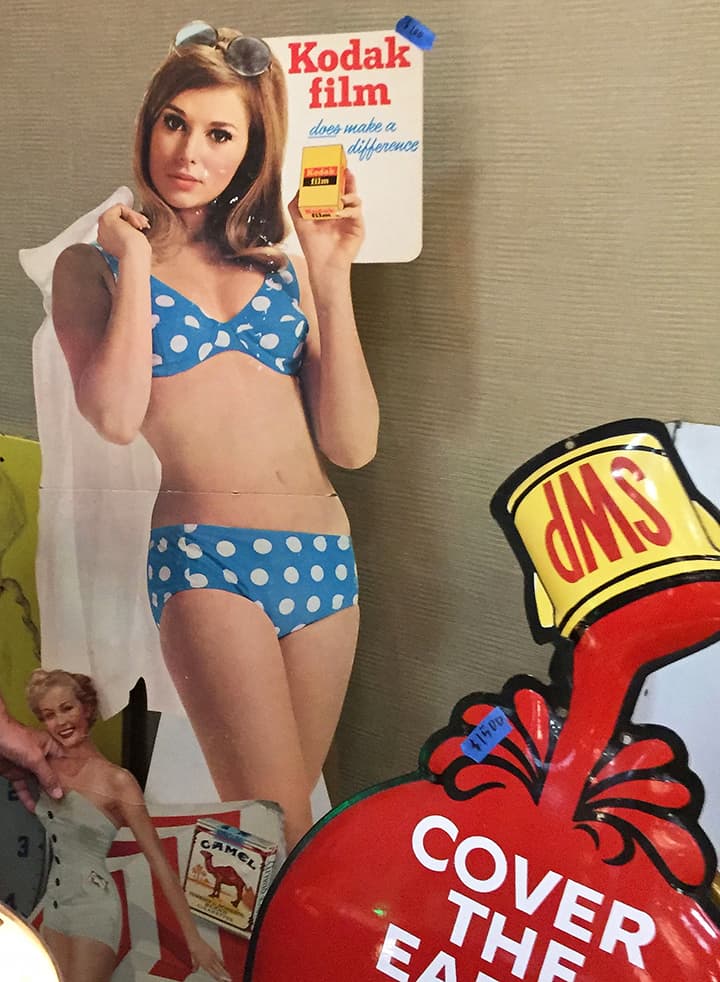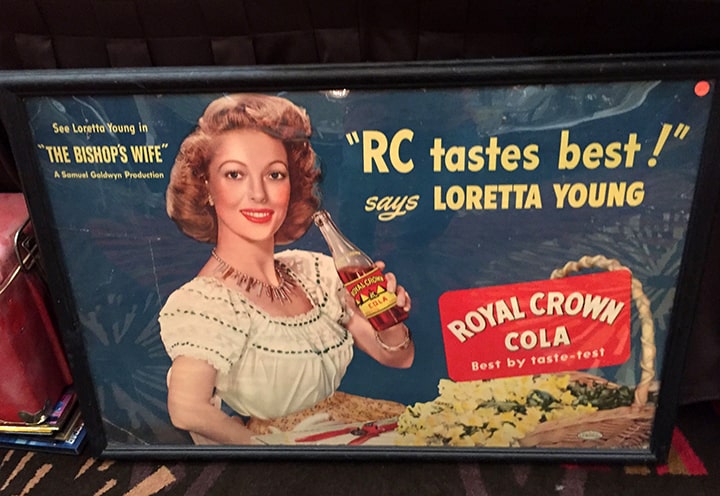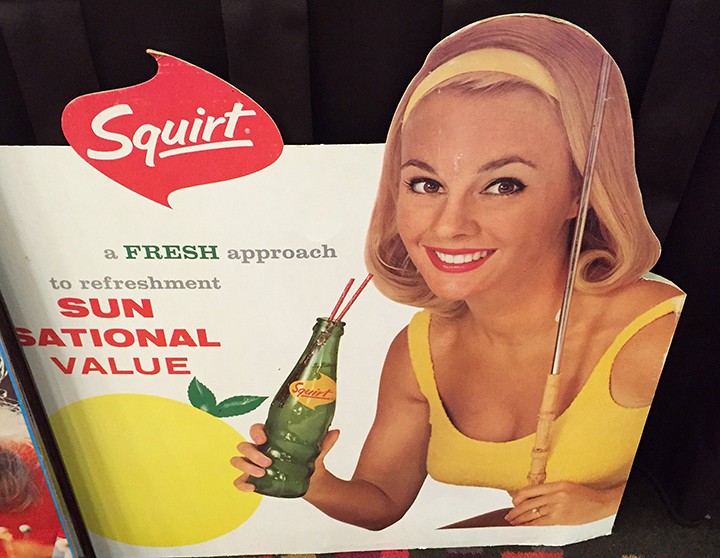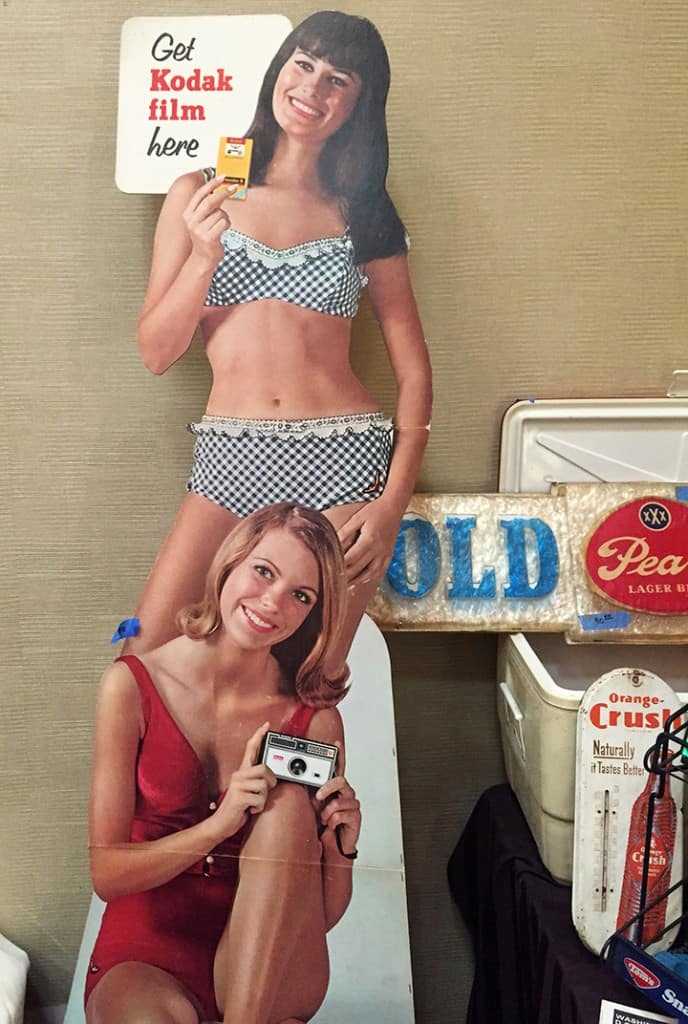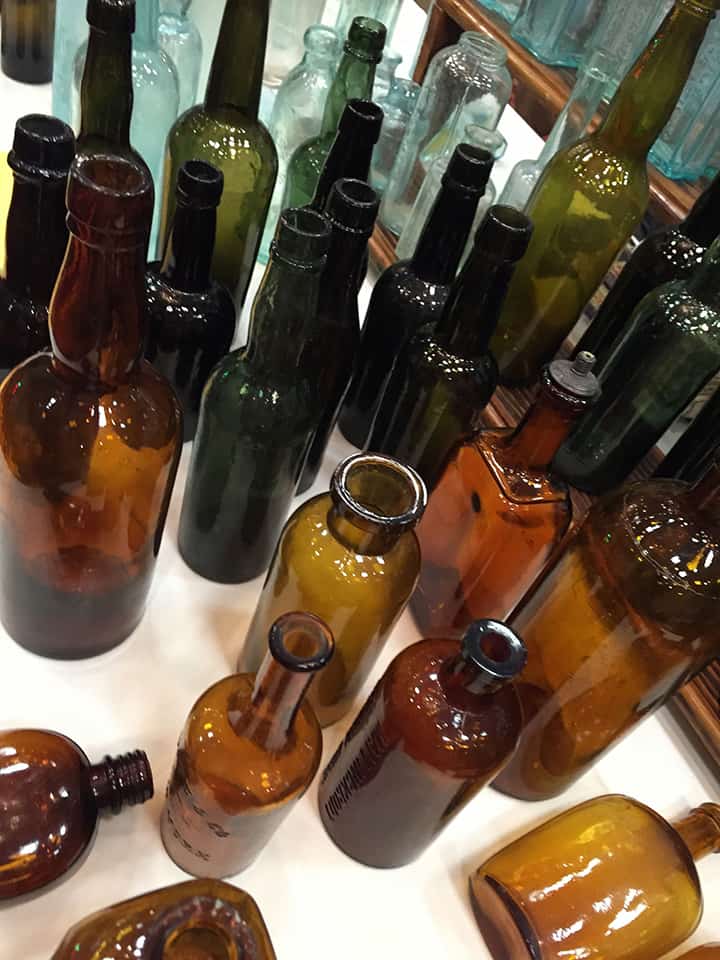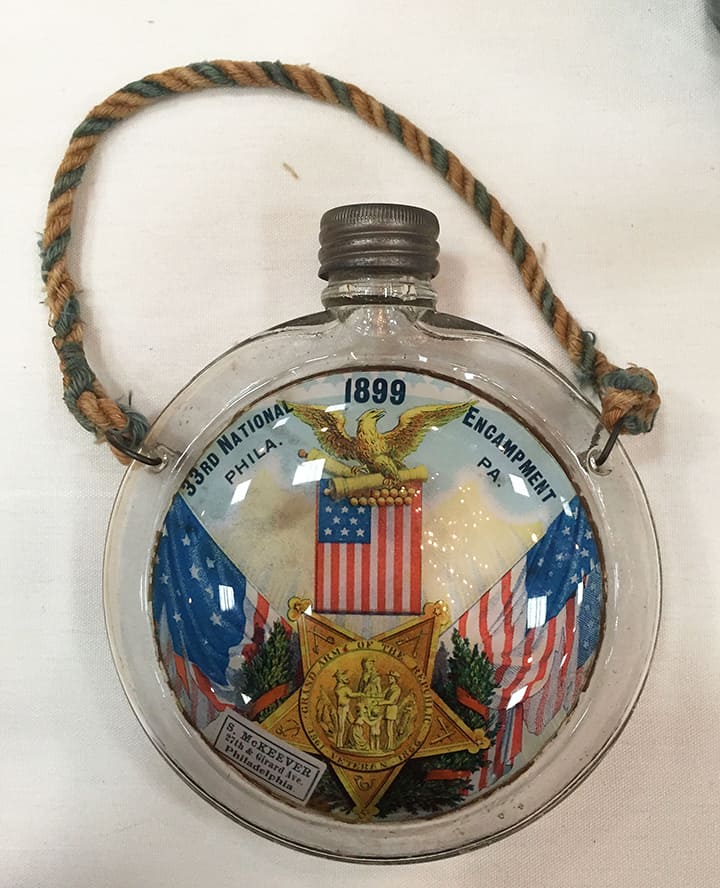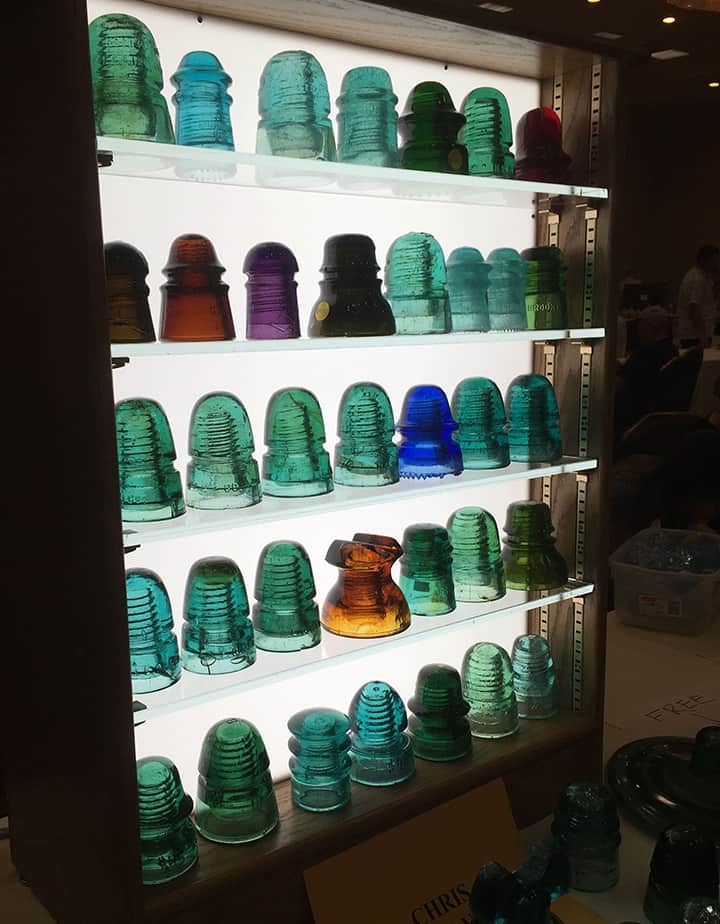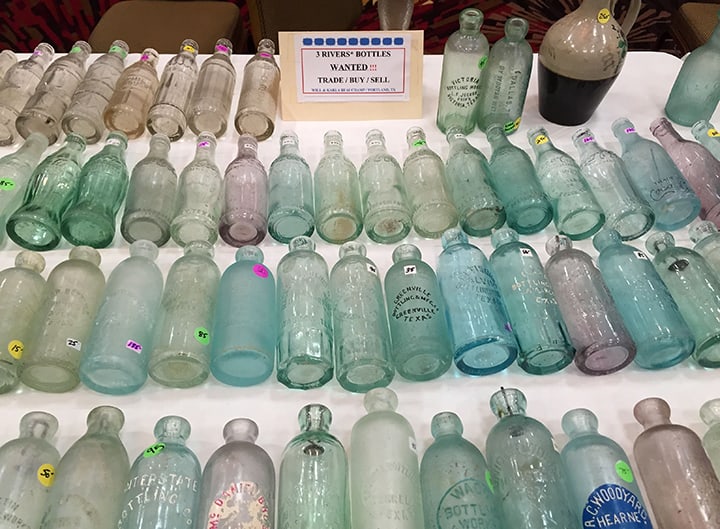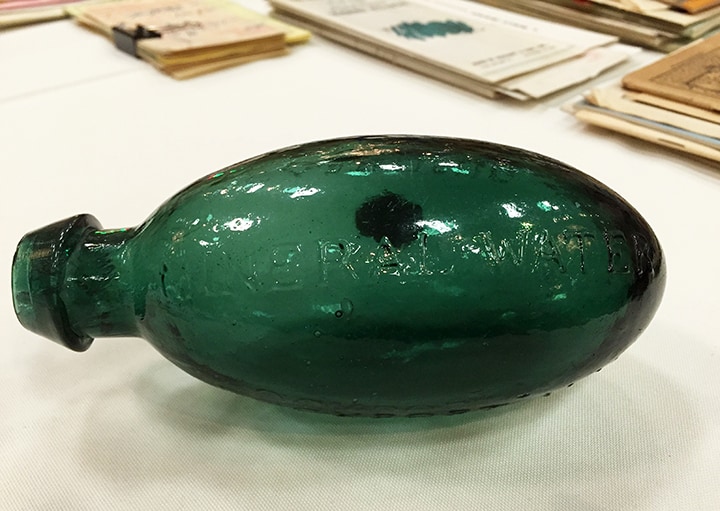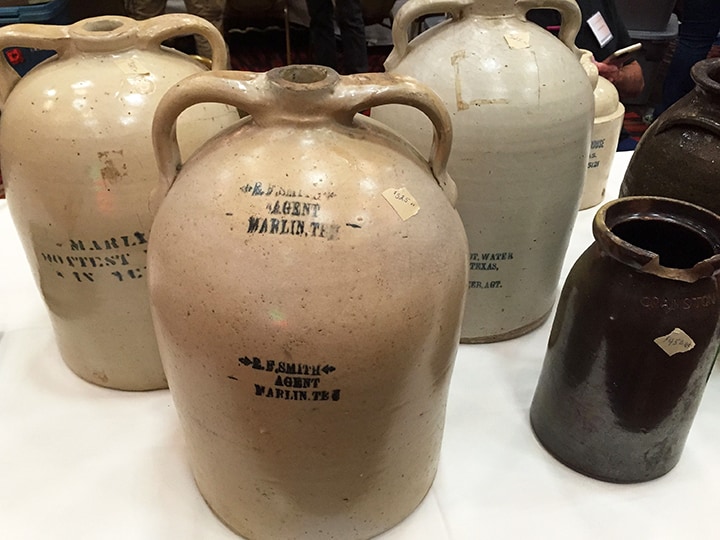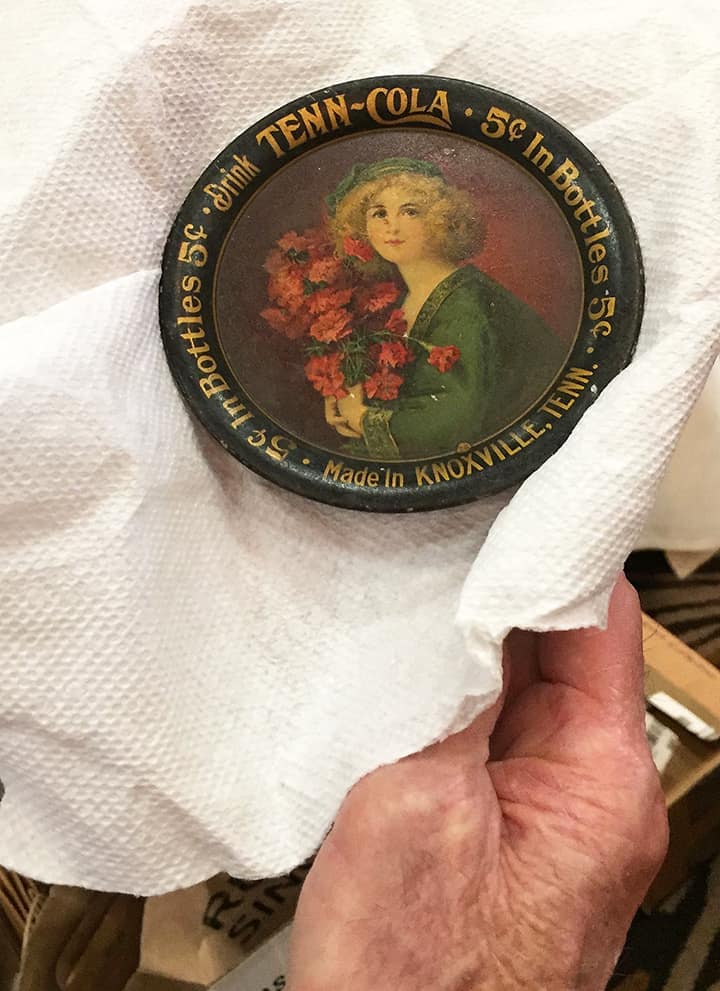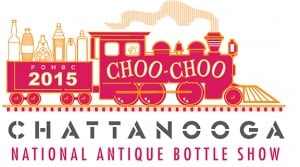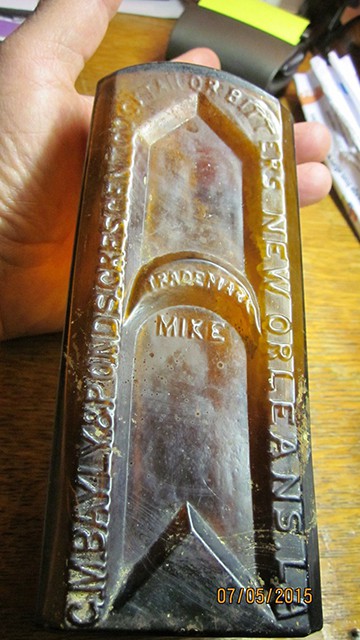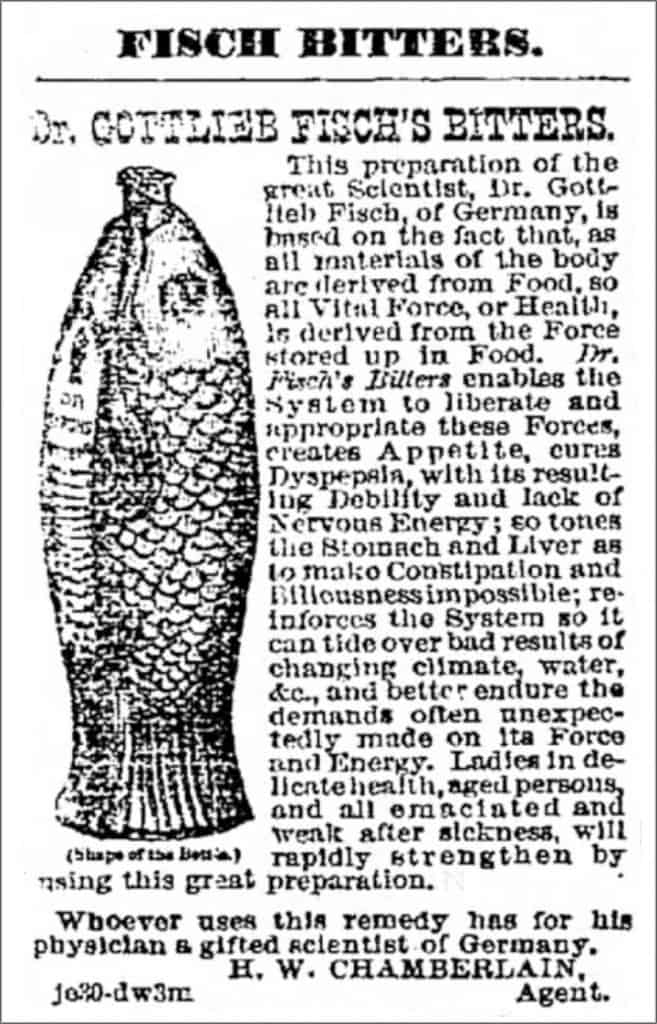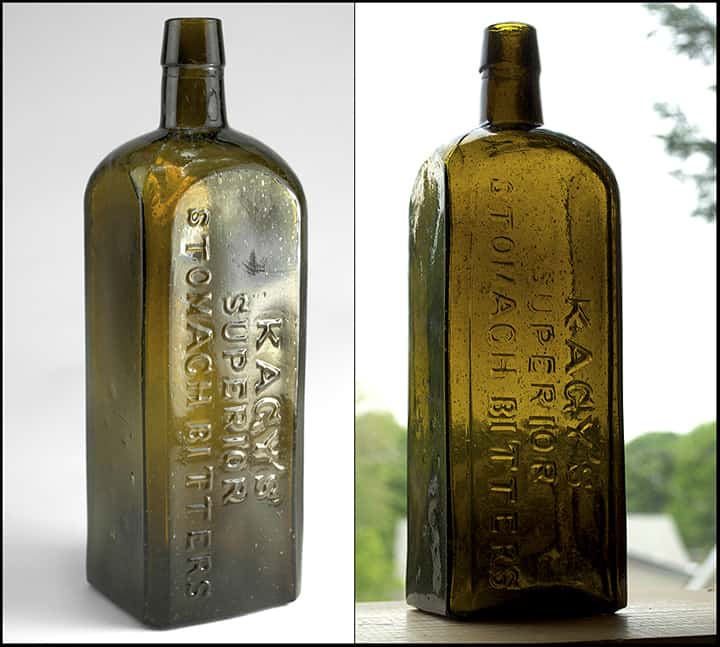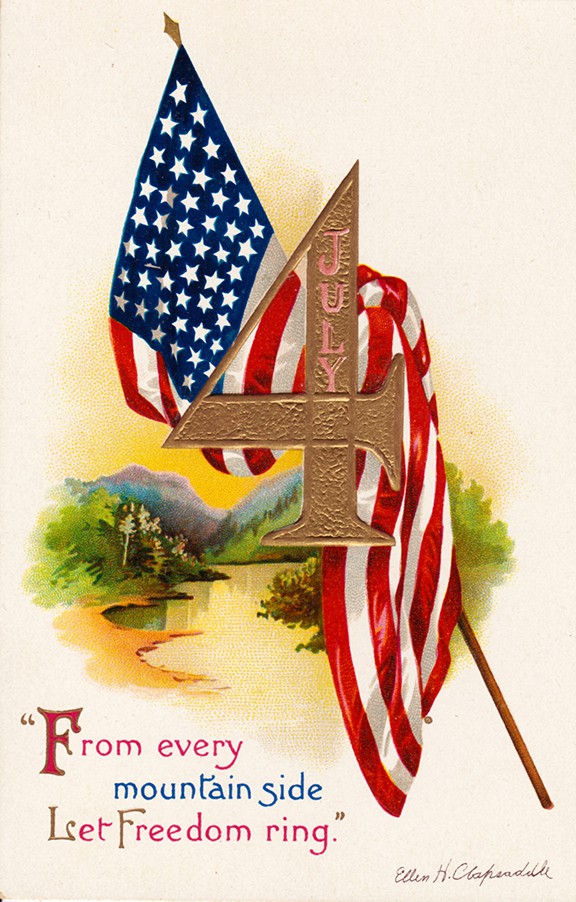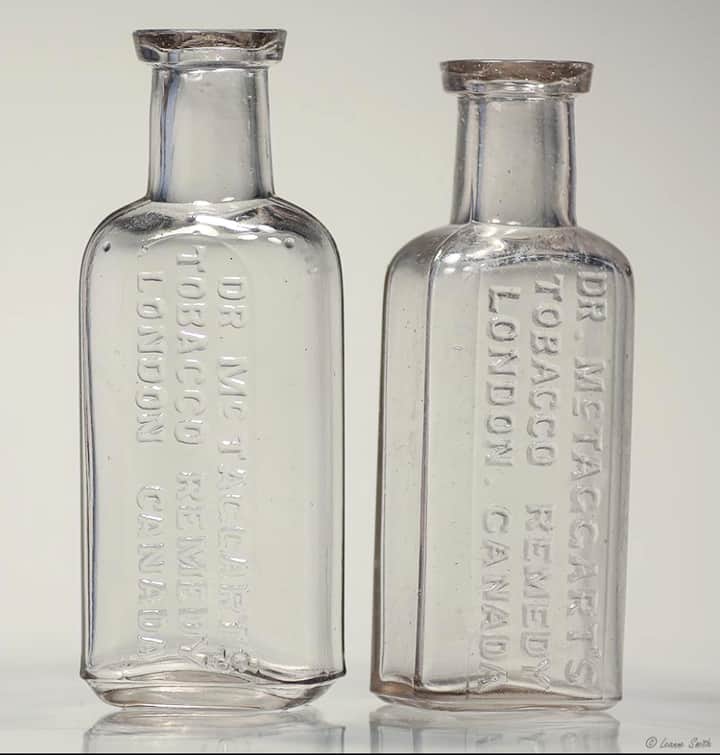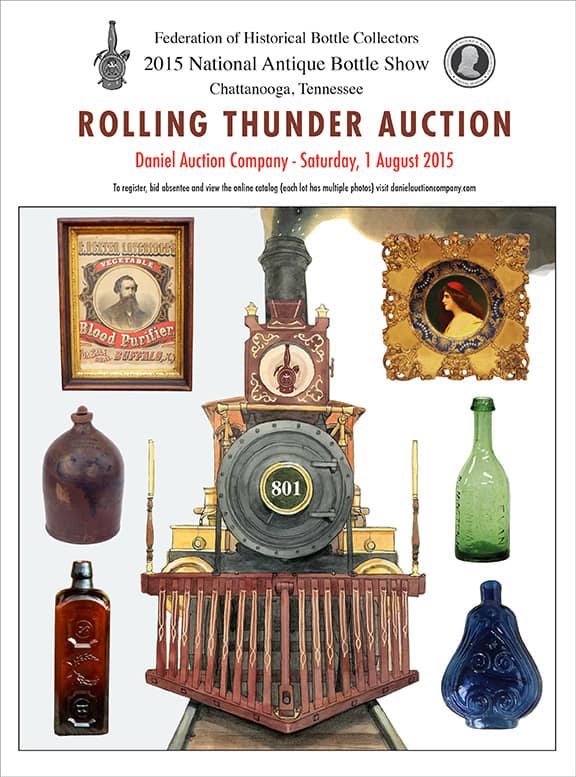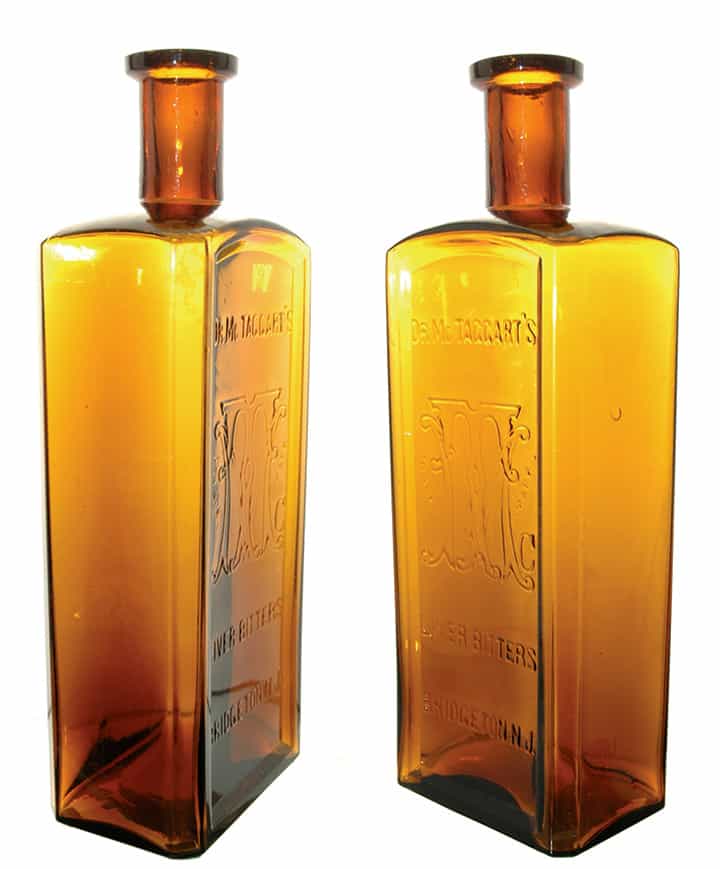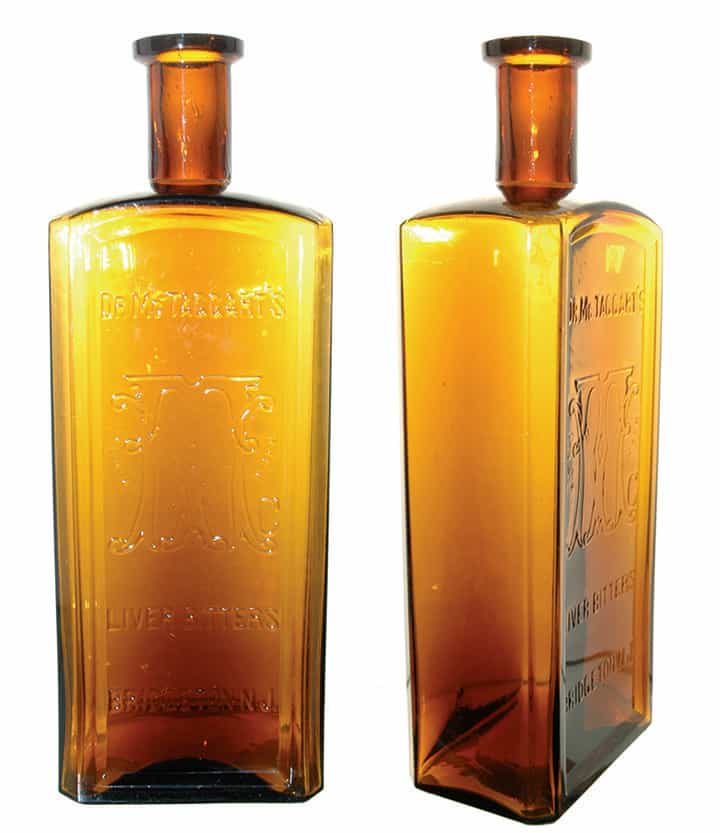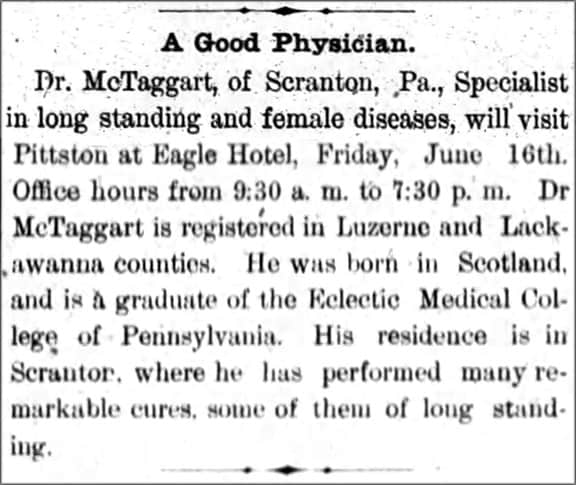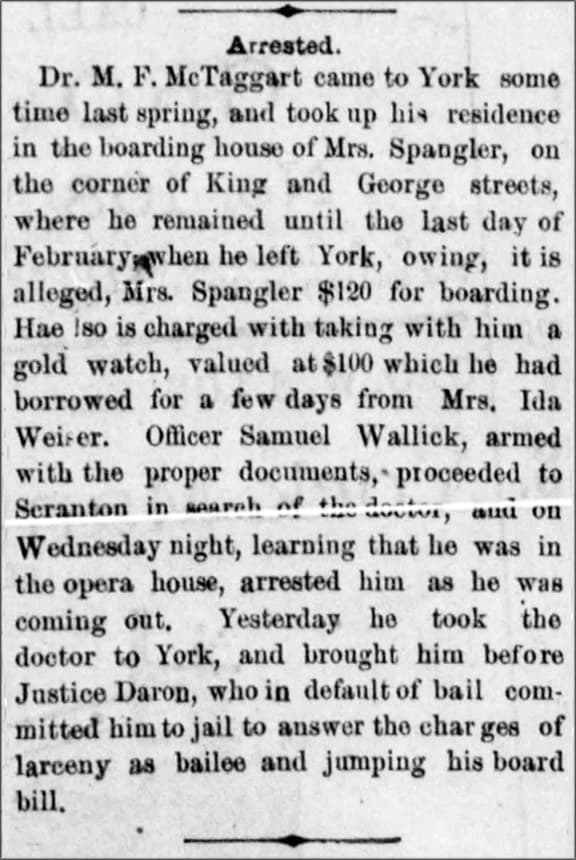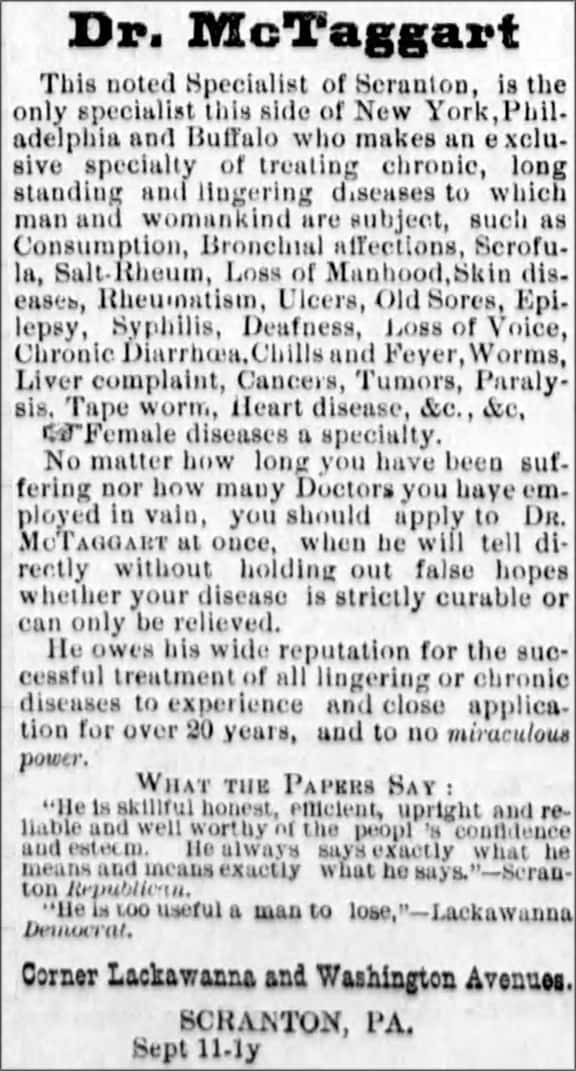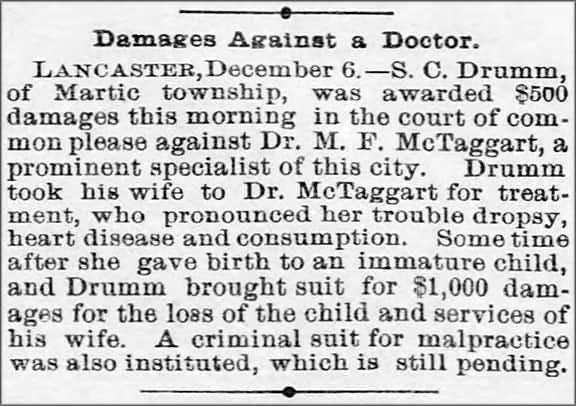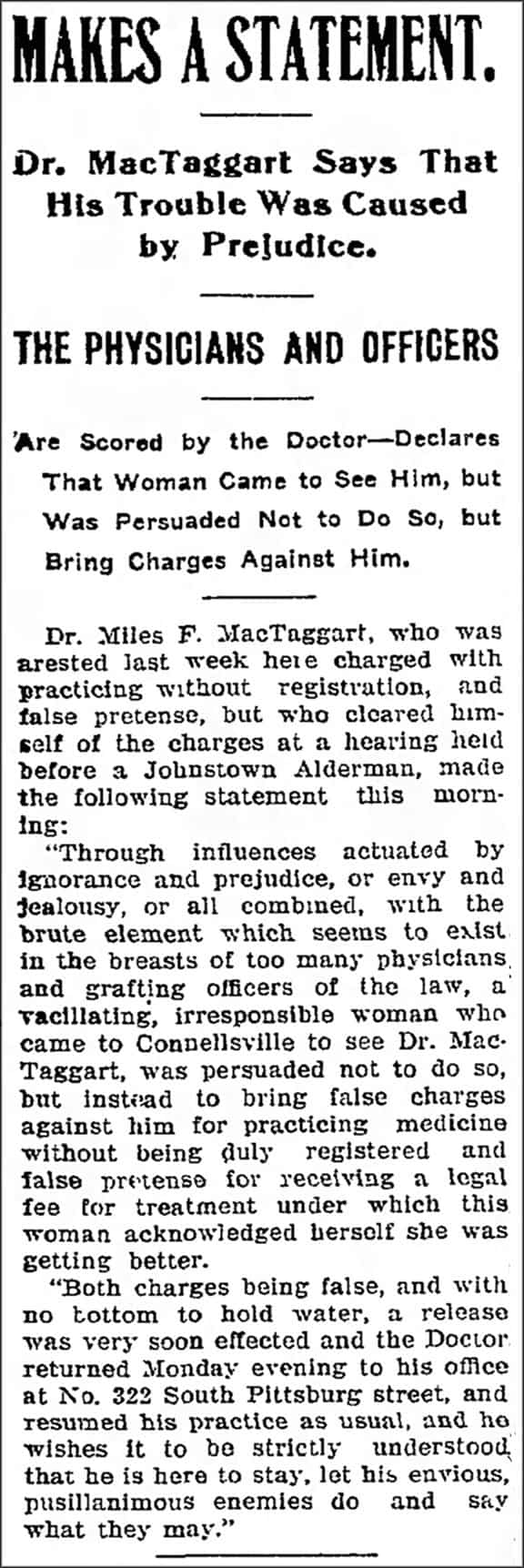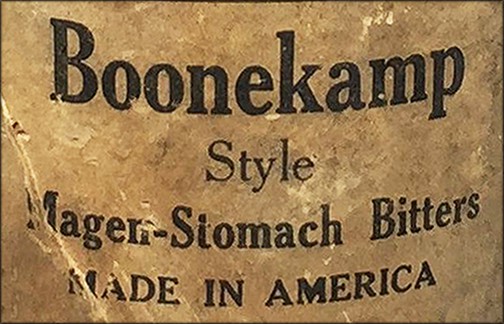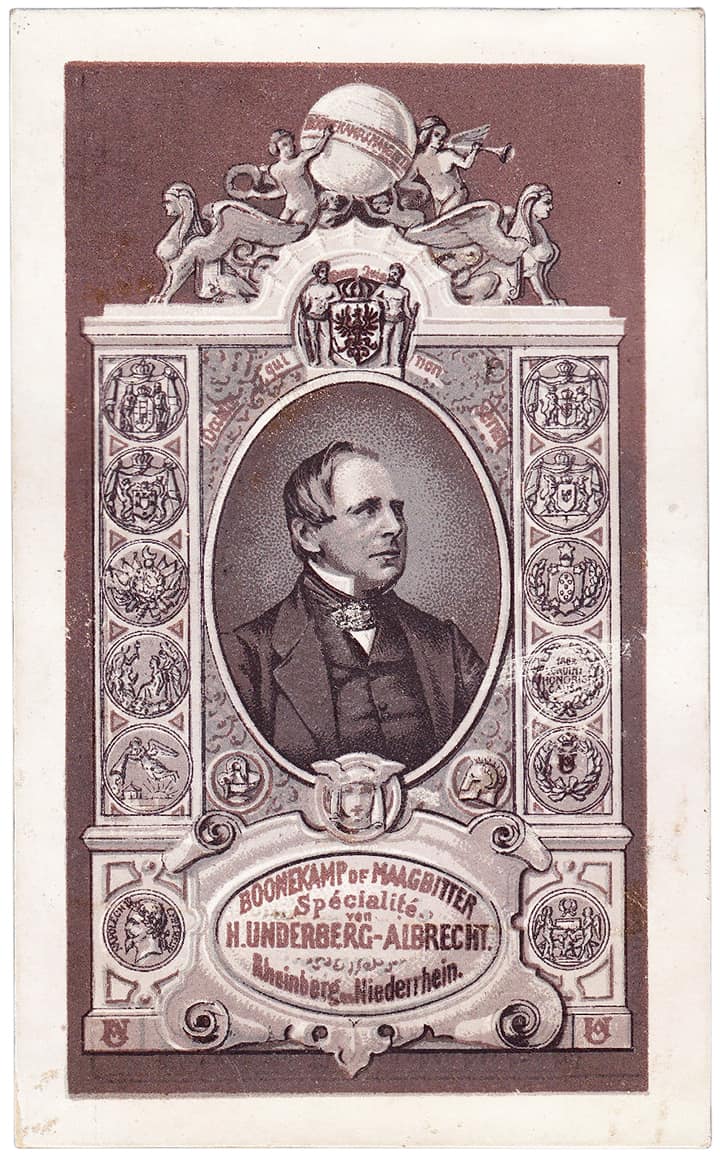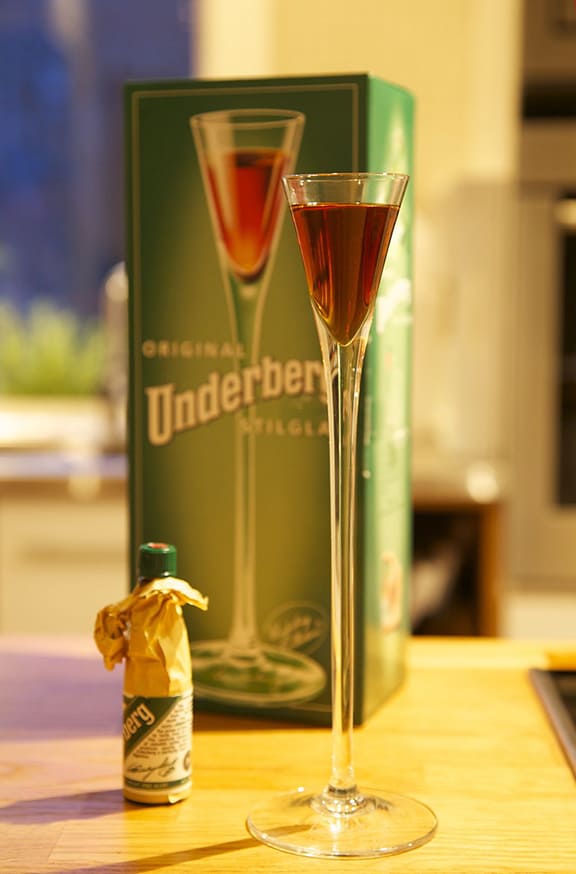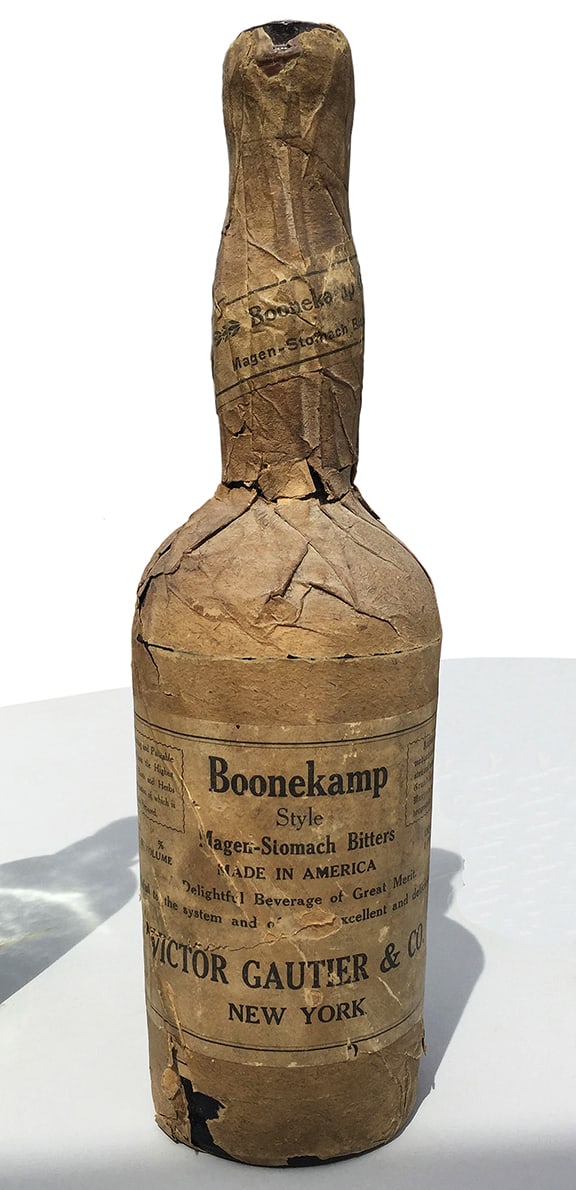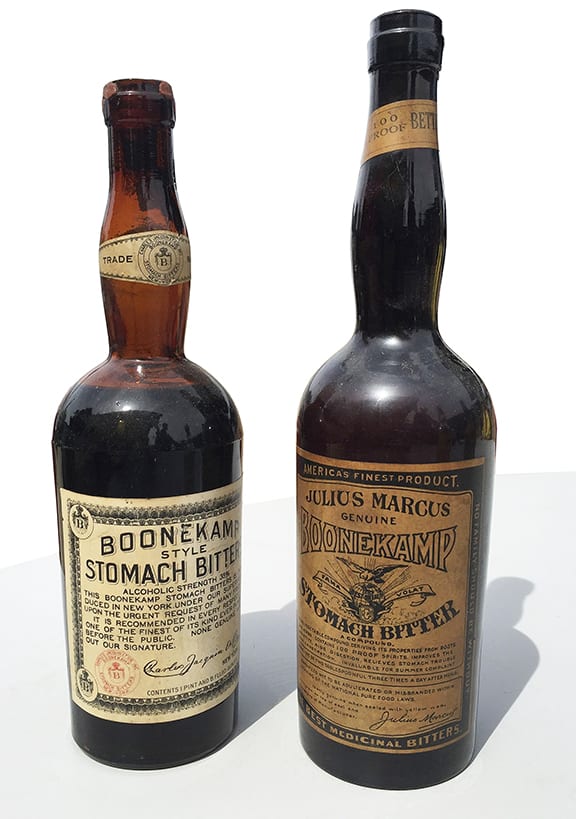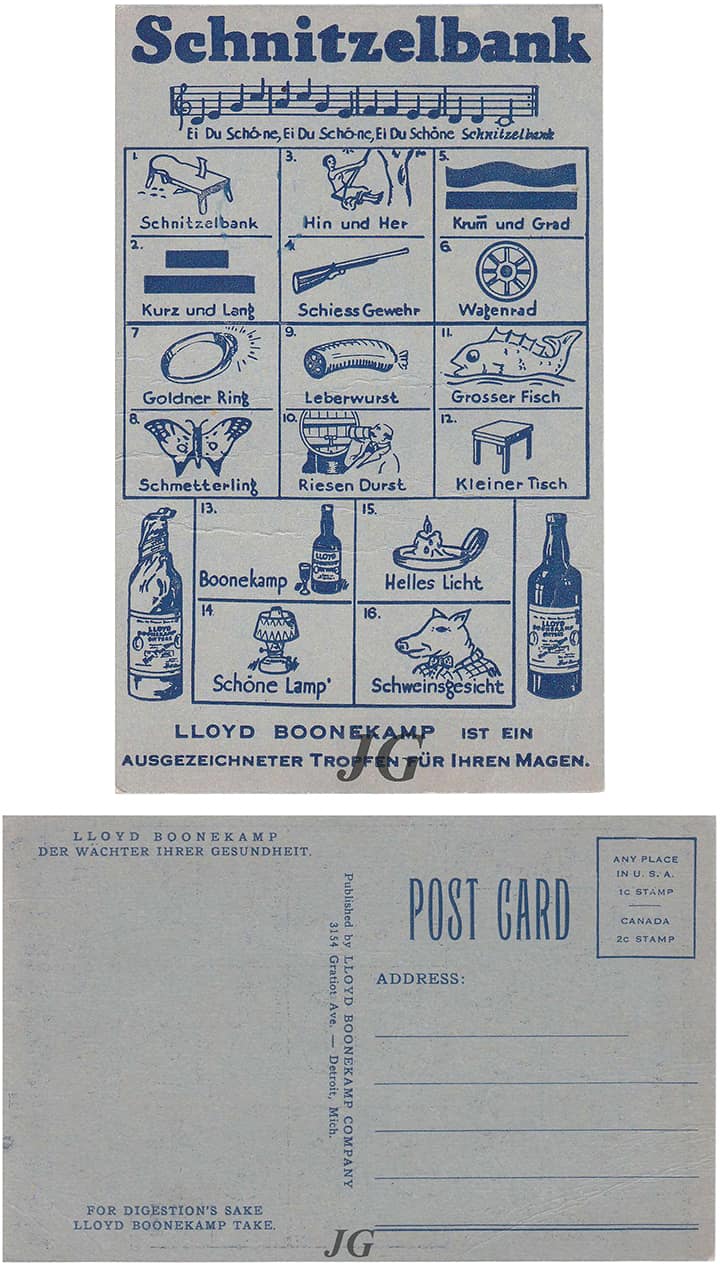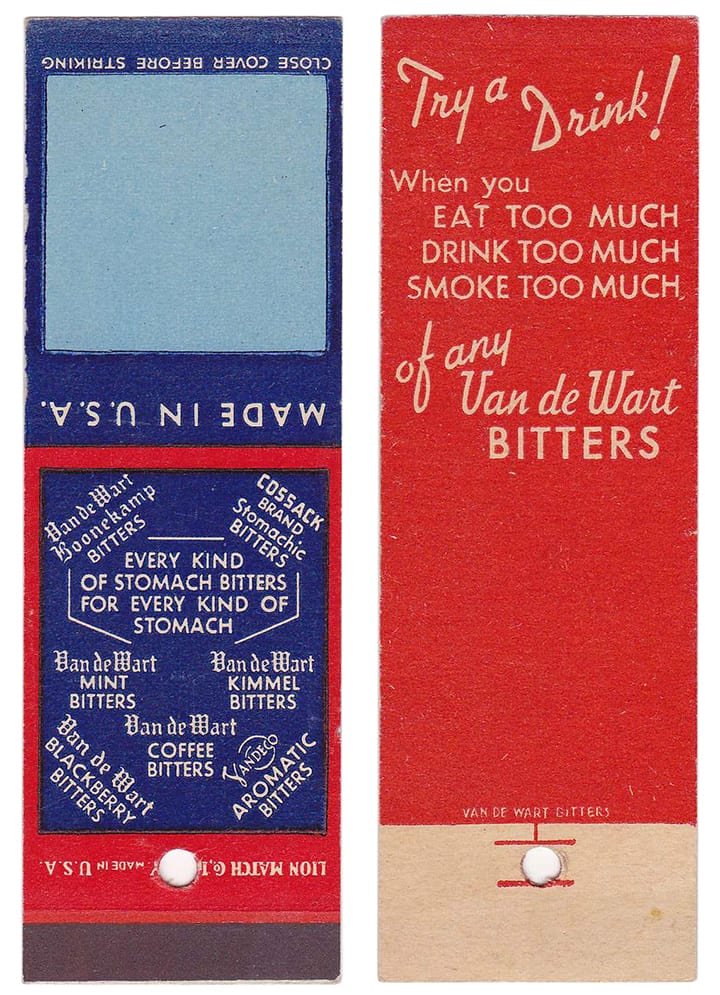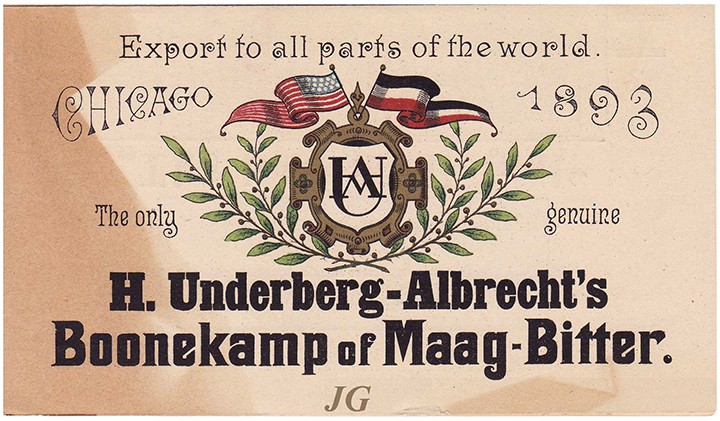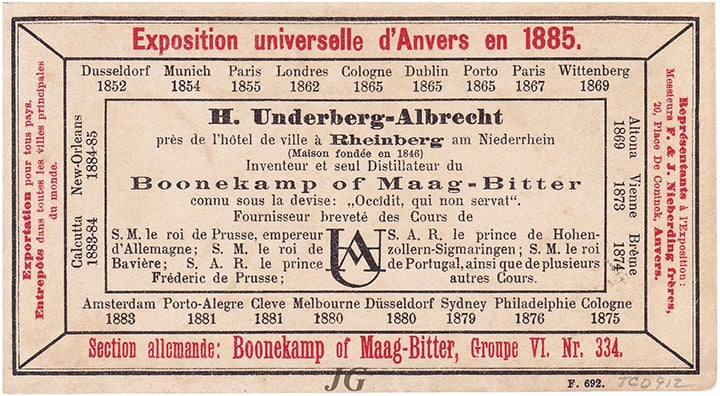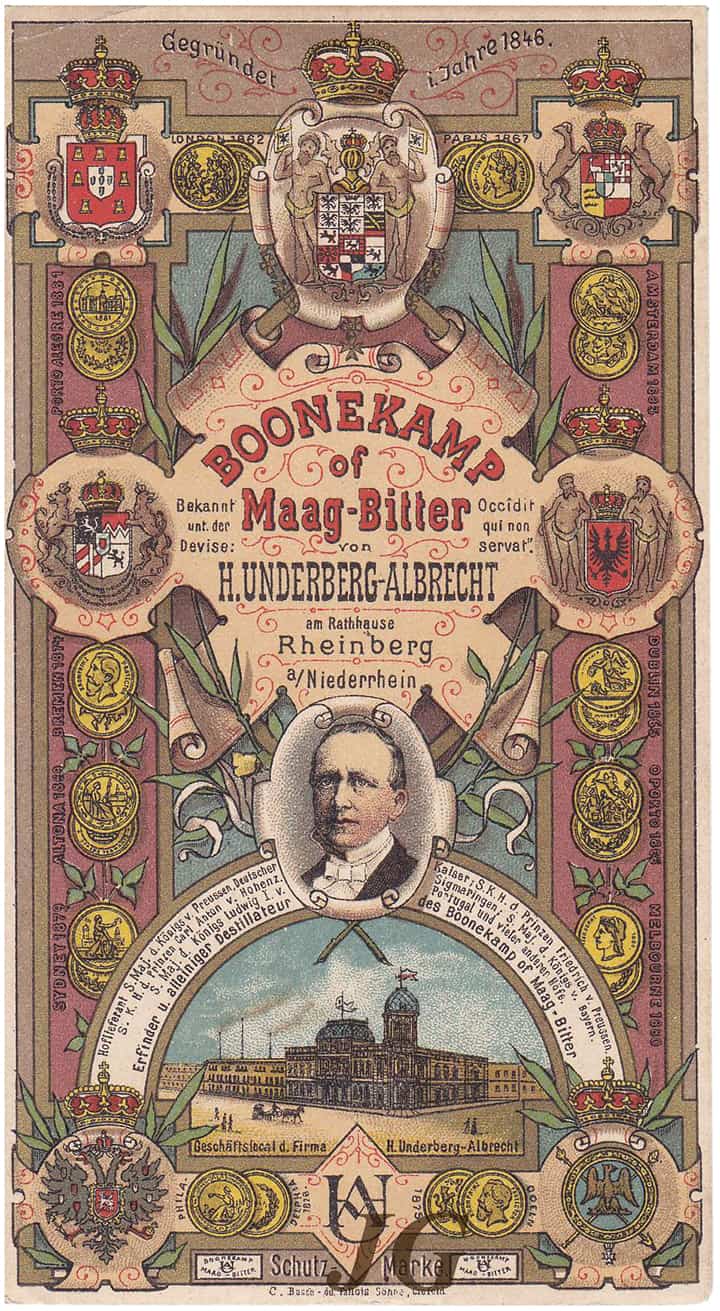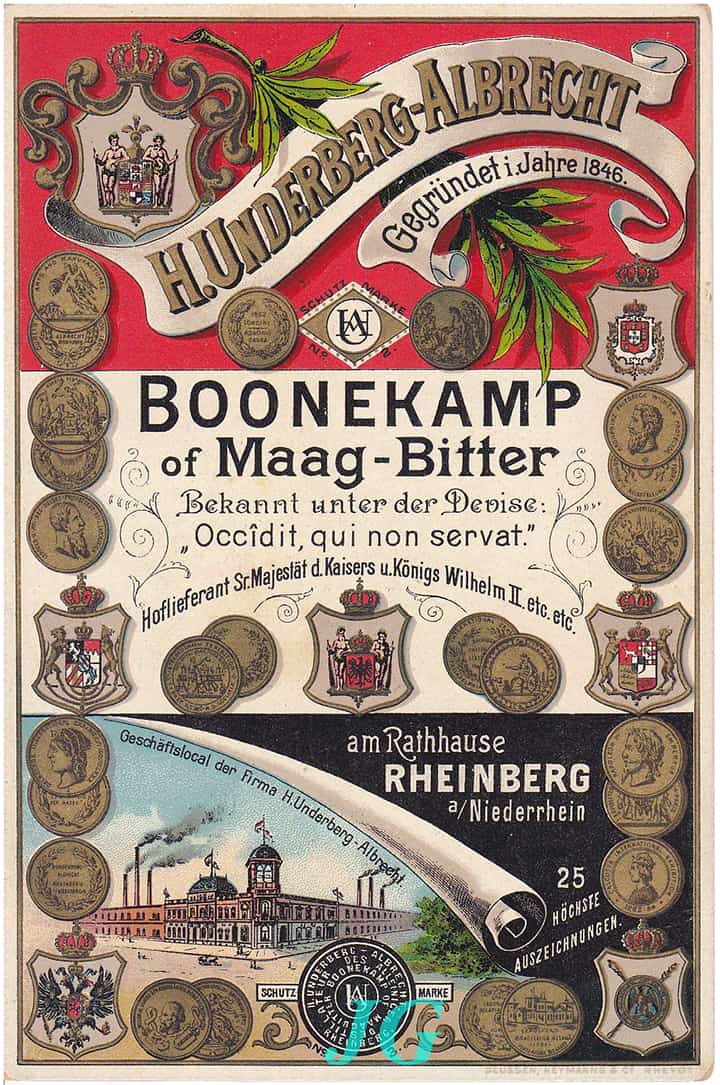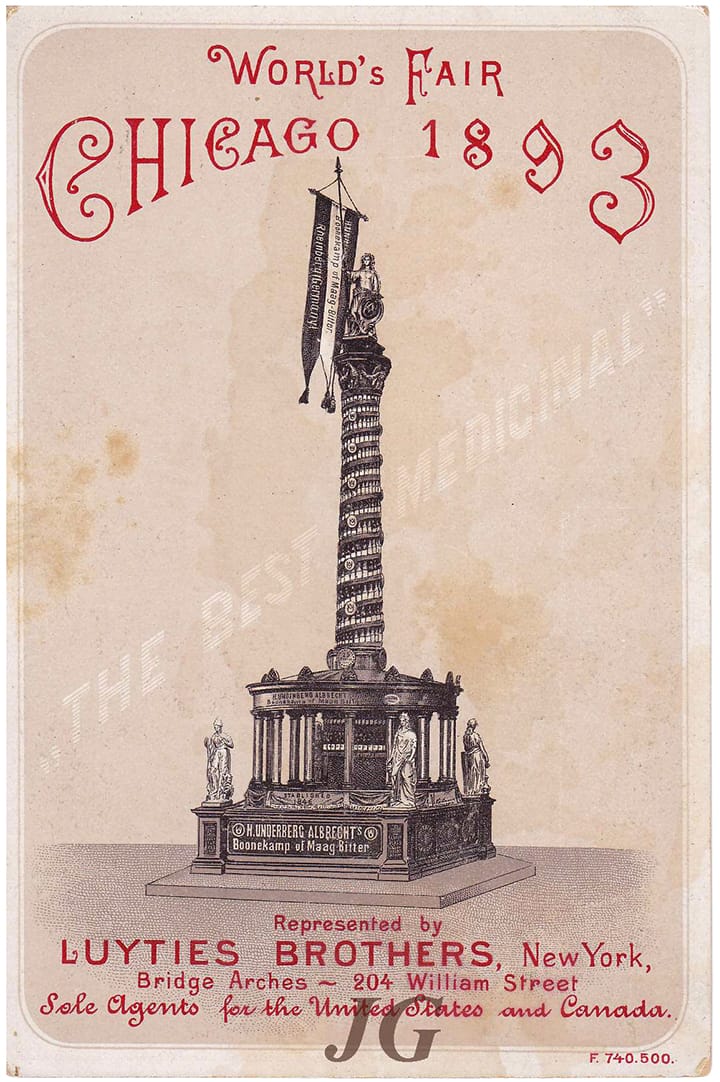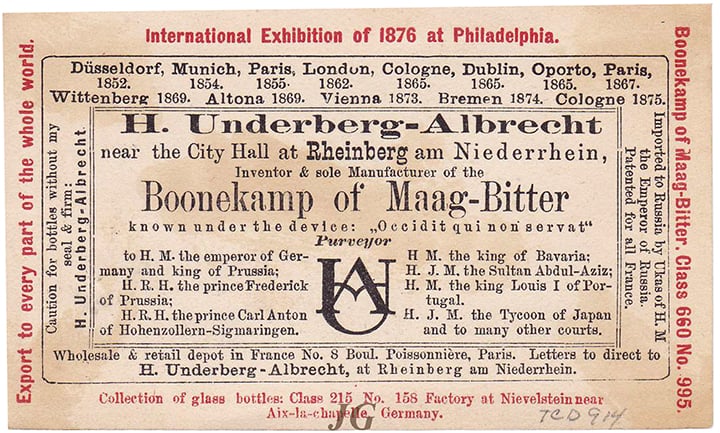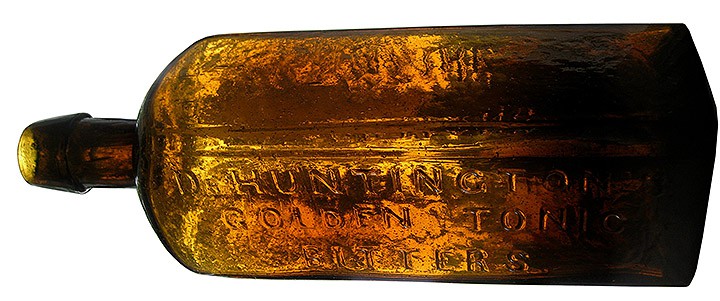
Dr. Huntington’s Golden Tonic Bitters – Portland, Maine
With a Lot of Character & Critters
12 June 2015 (R•062015) (R•081418) (R•092018) (R•062719)
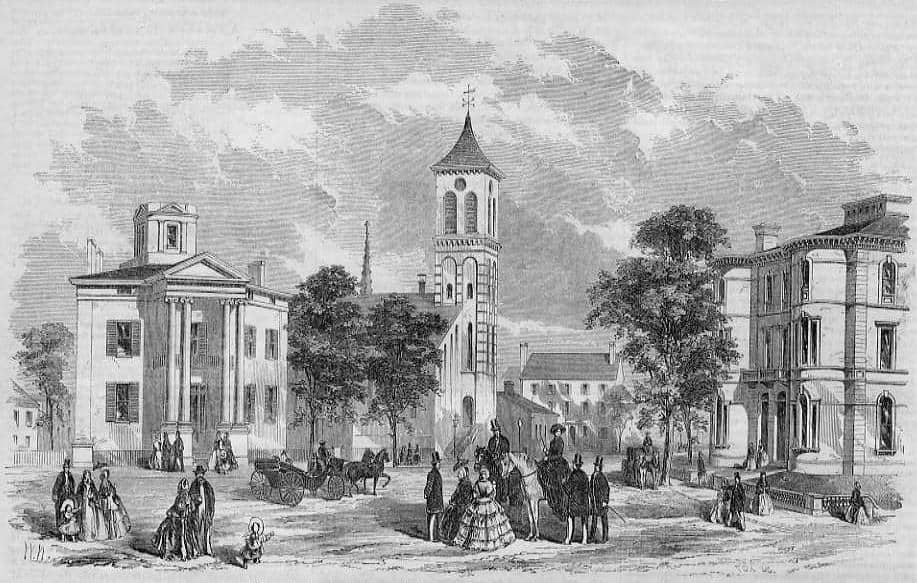
Portland, Maine: Free and Congress Streets in 1857
 Gary Beatty, as he sometimes does, called to ask me about a bitters bottle he was considering adding to his collection. When he mentioned it was a Dr. Huntington’s Golden Tonic Bitters from Portland, Maine, I immediately knew he had a good one in his net. Fortunately I have an example too. Let’s look at Gary’s wonderful pictures, my example and one that recently sold at Norman C. Heckler Auctions.
Gary Beatty, as he sometimes does, called to ask me about a bitters bottle he was considering adding to his collection. When he mentioned it was a Dr. Huntington’s Golden Tonic Bitters from Portland, Maine, I immediately knew he had a good one in his net. Fortunately I have an example too. Let’s look at Gary’s wonderful pictures, my example and one that recently sold at Norman C. Heckler Auctions.

First of all, the Carlyn Ring and W.C. Ham listing in Bitters Bottles is as follows:
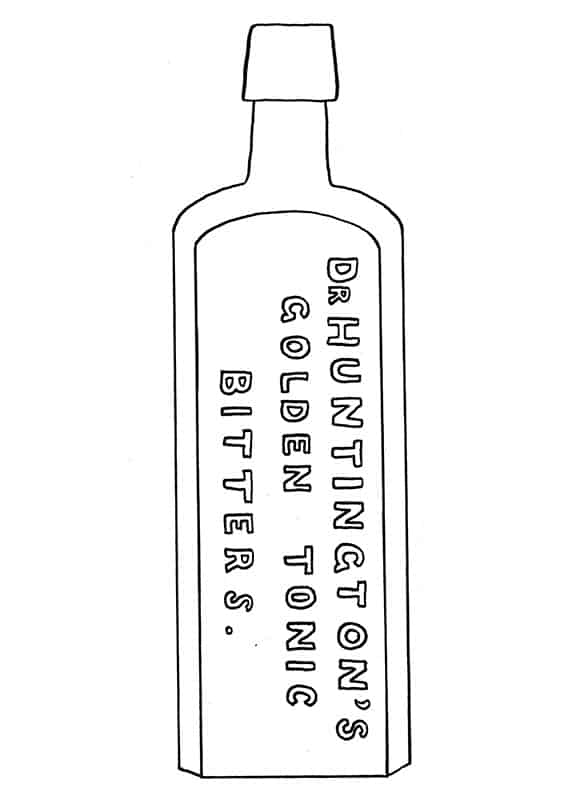
H 213 Dr. Huntington’s Golden Tonic Bitters
DR. HUNTINGTON’S / GOLDEN TONIC / BITTERS. // f // PORTLAND /
MAINE // f //
9 1/2 x 3 5/8 (6 7/8) 1/4
Square, LTC, Applied mouth, Amber, Rare; Aqua and Clear, Rare
Maine Business Directory, 1876
Here are Gary’s pictures and his e-mail after the transaction.
Hi Ferd, here is my latest addition to “Beatty’s Bitters Ranch” I sure think it is a beauty. Norm Heckler is confident it was blown at a Stoddard Glass House. Thought you might like to put it in the “Daily Dose” along with a picture of yours. To me a bitters that has Dr. embossed on it along with the town and state is as good as it gets. I think it’s a killer what do you think. Best Regards. Gary Beatty
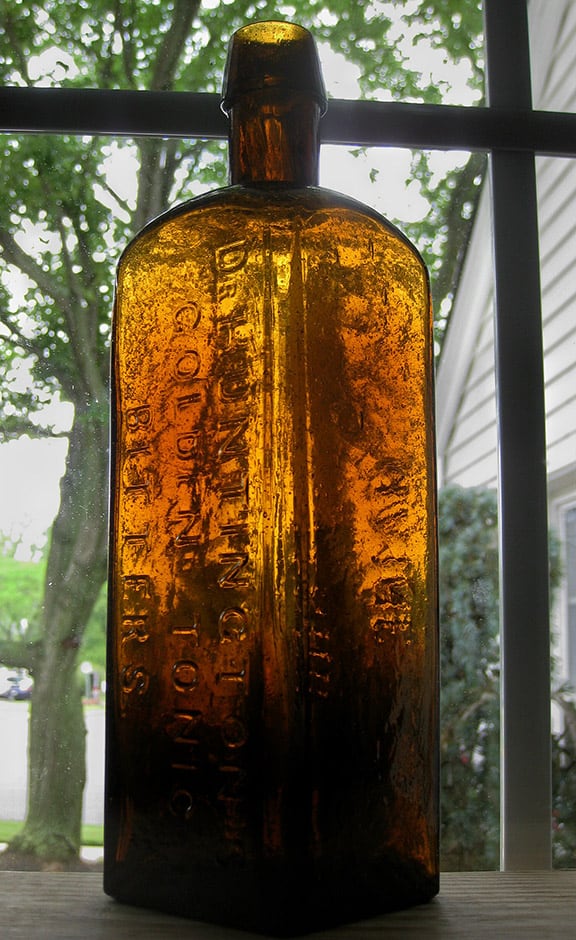
Dr. Huntington’s Golden Tonic Bitters – Portland, Maine – Beatty Collection
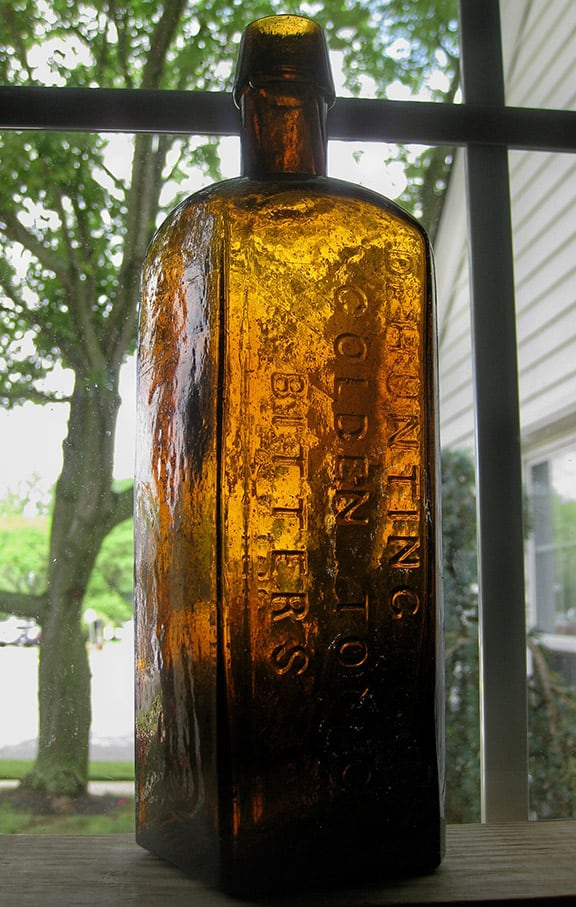
Dr. Huntington’s Golden Tonic Bitters – Portland, Maine – Beatty Collection
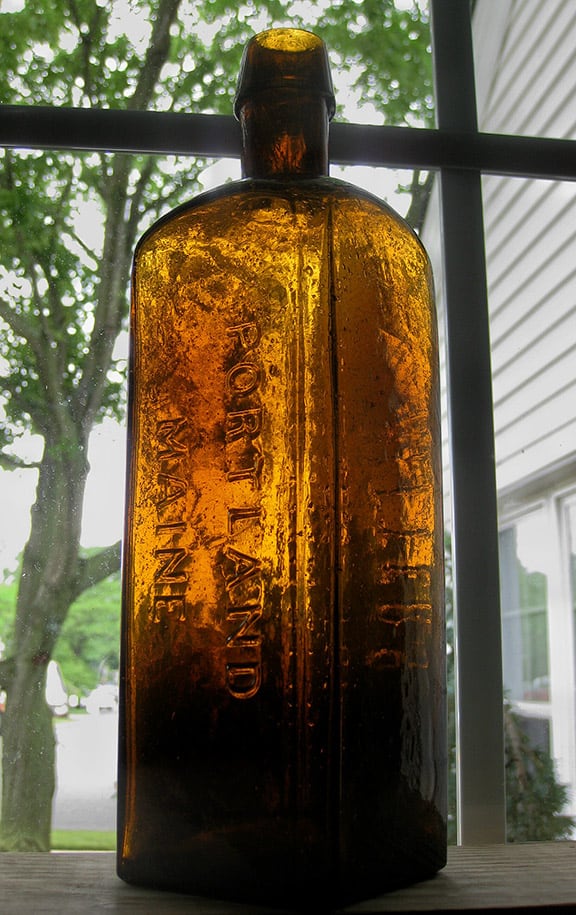
Dr. Huntington’s Golden Tonic Bitters – Portland, Maine – Beatty Collection
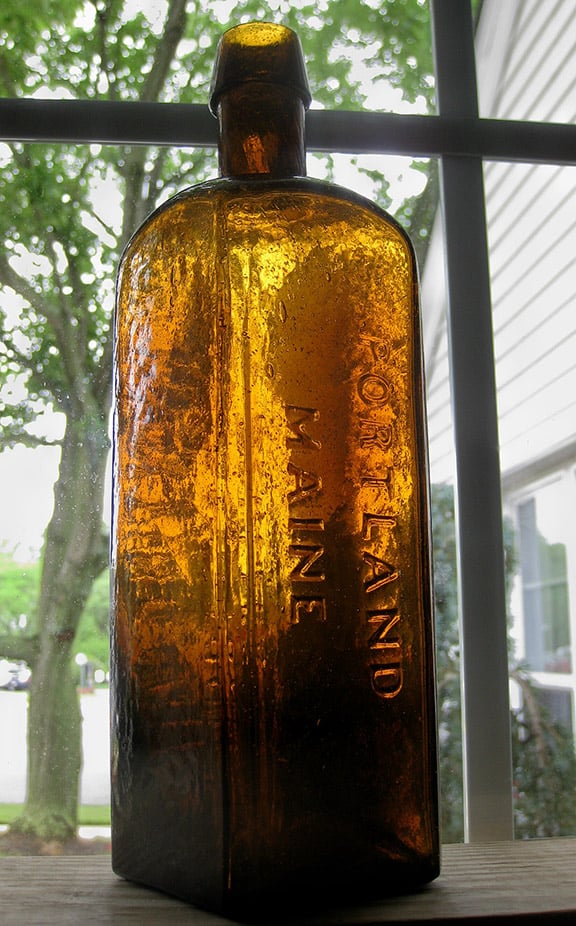
Dr. Huntington’s Golden Tonic Bitters – Portland, Maine – Beatty Collection
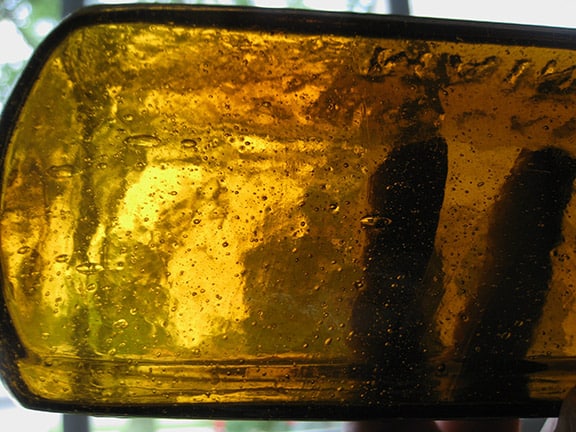
Dr. Huntington’s Golden Tonic Bitters – Portland, Maine – Beatty Collection
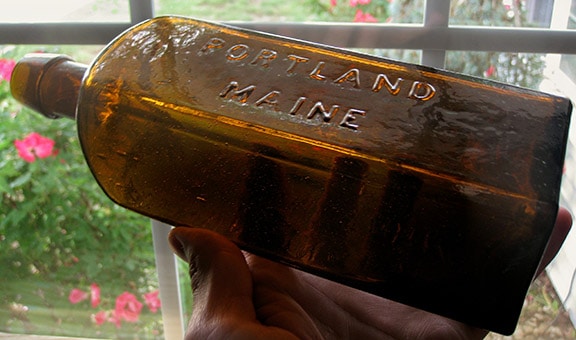
Dr. Huntington’s Golden Tonic Bitters – Portland, Maine – Beatty Collection
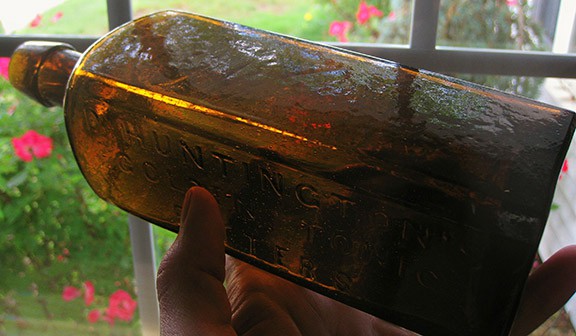
Dr. Huntington’s Golden Tonic Bitters – Portland, Maine – Beatty Collection
Here are my pictures:
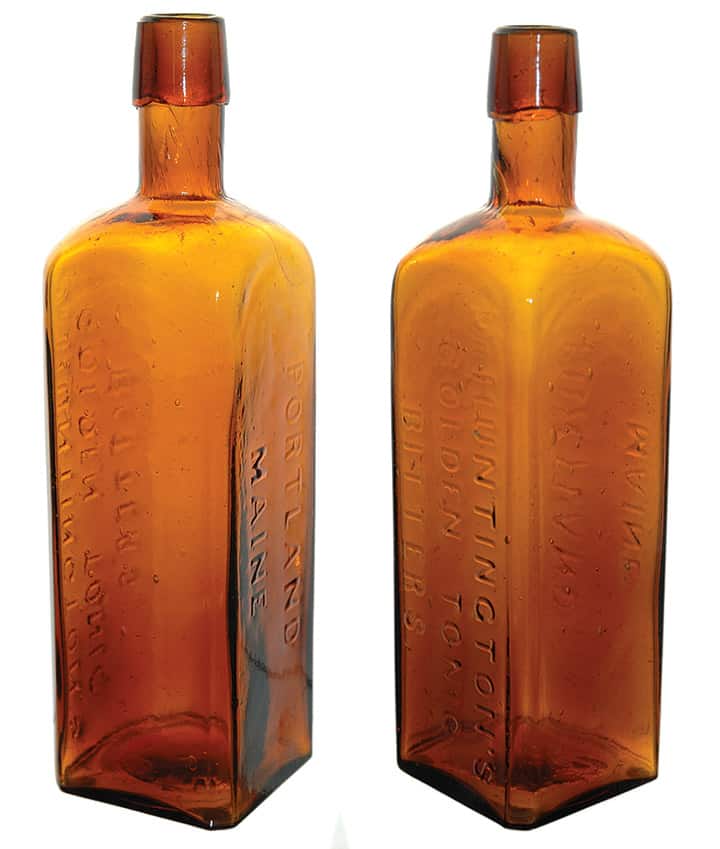
Dr. Huntington’s Golden Tonic Bitters – Portland, Maine – Meyer Collection
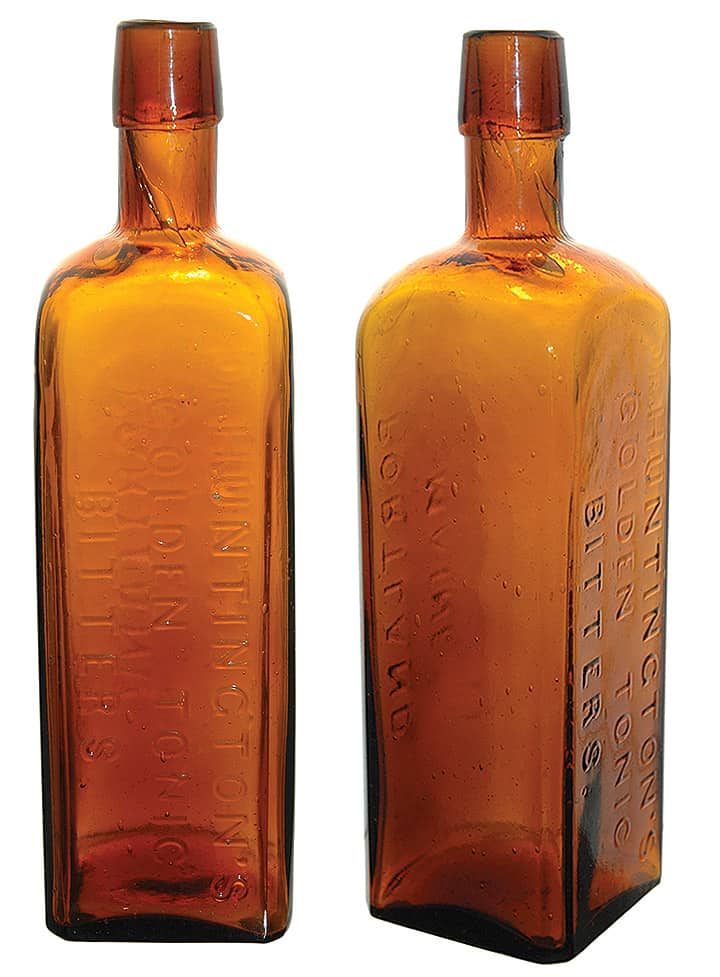
Dr. Huntington’s Golden Tonic Bitters – Portland, Maine – Meyer Collection
Here is the Norman C. Heckler example. I suspect Gary’s bottle is this example.
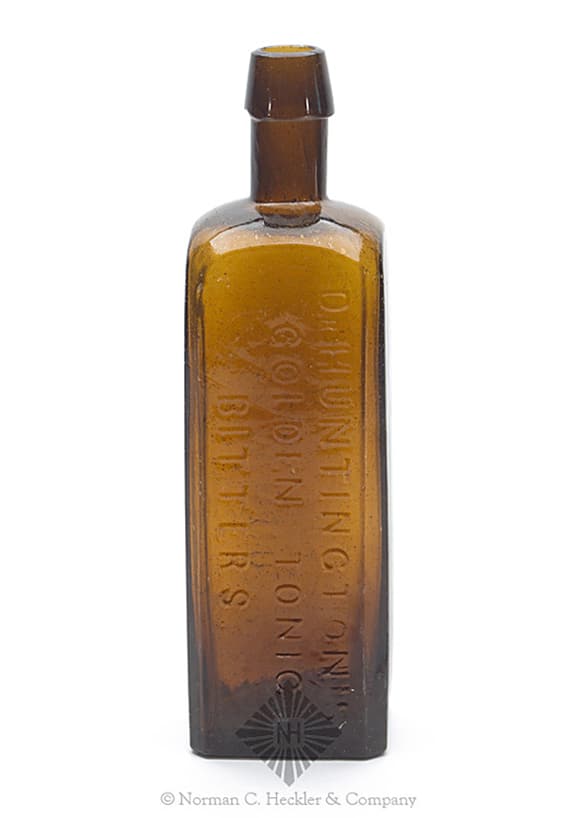
“Dr. Huntington’s / Golden Tonic / Bitters.” – “Portland / Maine” Bitters Bottle, probably a Stoddard glasshouse, Stoddard, New Hampshire, 1860-1872. Square with beveled corners, golden amber with an olive tone, applied sloping collared mouth – smooth base, ht. 9 3/8 inches. R/H #H-213 Beautiful color, thousands of tiny bubbles in the glass, strong embossing, fine condition. Kris Kernozicky collection. – Norman C. Heckler & Company
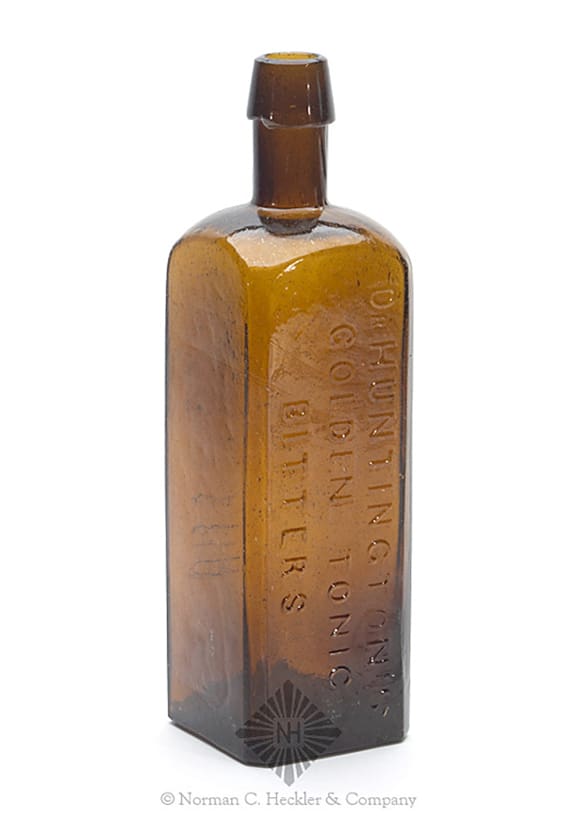
“Dr. Huntington’s / Golden Tonic / Bitters.” – “Portland / Maine” Bitters Bottle, probably a Stoddard glasshouse, Stoddard, New Hampshire, 1860-1872. Square with beveled corners, golden amber with an olive tone, applied sloping collared mouth – smooth base, ht. 9 3/8 inches. R/H #H-213 Beautiful color, thousands of tiny bubbles in the glass, strong embossing, fine condition. Kris Kernozicky collection. – Norman C. Heckler & Company
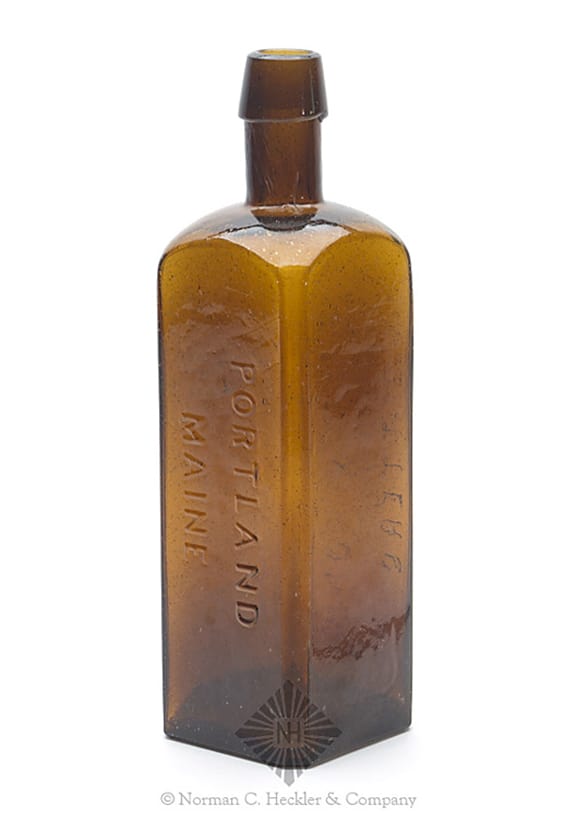
“Dr. Huntington’s / Golden Tonic / Bitters.” – “Portland / Maine” Bitters Bottle, probably a Stoddard glasshouse, Stoddard, New Hampshire, 1860-1872. Square with beveled corners, golden amber with an olive tone, applied sloping collared mouth – smooth base, ht. 9 3/8 inches. R/H #H-213 Beautiful color, thousands of tiny bubbles in the glass, strong embossing, fine condition. Kris Kernozicky collection. – Norman C. Heckler & Company

“DR. HUNTINGTON’S / GOLDEN TONIC / BITTERS – PORTLAND / MAINE”, (Ring/Ham, H-213), Maine, ca. 1875 – 1885, aqua, 9 1/4”h, smooth base, applied tapered collar mouth. Good glass whittle, rarely seen aqua color! Larry Umbreit Collection. – Glass Works Auctions | Auction 124
Is Alpheus Huntington our man?
So, we know that we have “Dr. Huntington” and “Portland, Maine” as clues with an 1875 date, plus or minus some years, by the look of the bottle. I now head to Portland Maine city directories during this time period and pretty quickly ascertain that Alpheus Huntington is most likely our man. I find no advertising and can not track down a labeled example of the bottle for assistance. I send a request to bitters trade card guru Joe Gourd for assistance as I know trade cards exist for the brand.
Alpheus Huntington was born on 16 September 1820 in Litchfield, Kennebec, Maine. His parents were Timothy Huntington and Abigail Hall. In 1850 he is listed as a peddler so he is probably pushing medicines of some sort. I see no medical school references but I could have missed that. He marries Lucy Ann Jack at a young age and they have a son named Fred Wallington Huntington who would later be a veterinary surgeon and a horseshoer. Alpheus Huntington would die on 28 April 1905.
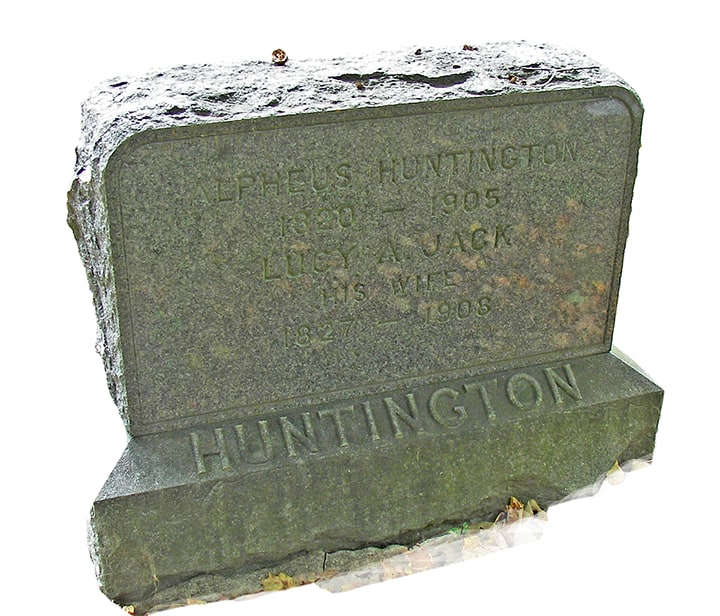
Alpheus Huntington and Lucy A. Jack grave marker
What is interesting about Alpheus was that he started out as a druggist and built a drug store around 1854 in Monmouth, Maine. Monmouth is a little southwest from Augusta, Maine and northeast of Portland. He eventually moves into the chewing gum and patent medicine business in Portland. Portland is important because it was the principal source in United States for chewing gum production at the time with the readily available spruce resin which was used in the making of gum.
Watch: History of Chewing Gum
“Everyone Chews the Queen of the North Gum, and use Huntington’s Liniment and Golden Tonic Bitters“
Huntington jointly conducted his patent medicine business from about 1860 to 1880 or so and becomes “Dr.” Huntington. As mentioned before, he is now located in Portland. This is a pretty wide date range. Somewhere during this period is when he made his bitters which, according to Norm Heckler, was probably blown at a Stoddard glass house in Stoddard, New Hampshire. The billhead below actually dates the bottle to 1862. According to Eric McGuire, “I am pretty sure you have the right guy for the proprietor of this product. On April 6, 1868, A. HUNTINGTON, of Portland, Maine, received a copyright for DR. HUNTINGTON’S GOLDEN TONIC BITTERS. This is surely Alpheus. This does not necessarily mean that the product was begun on that date, although it could be. I suspect his copyright was for a label for the bottle.”
The bottle also comes in clear and amber though I have never seen an example. It is also possible that another Dr. Huntington preceded this Huntington but he is an enigma now. That is assuming Alpheus is our man. There are no other Huntington’s in the directories during this period. Gotta be him.
Later in 1878 Huntington files for Bankruptcy.
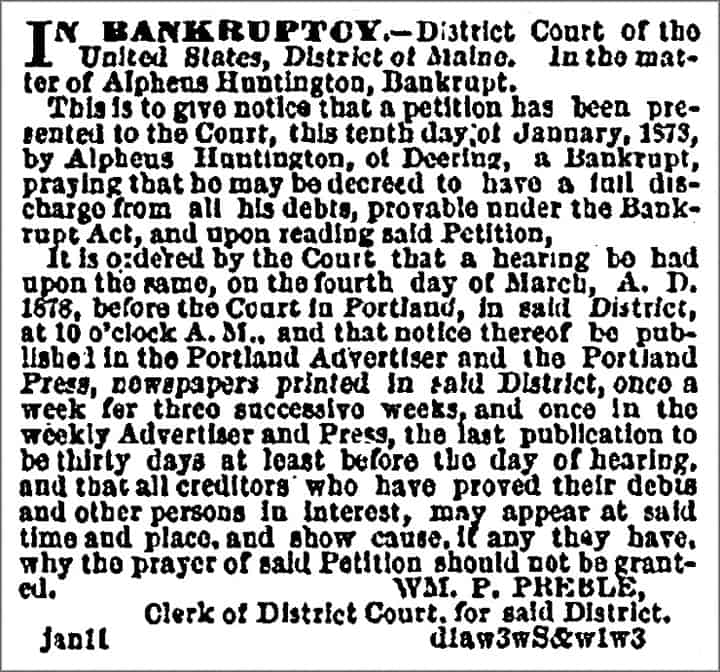
Huntington in Bankruptcy – Wednesday, January 30, 1878, Portland Daily Press (Portland, ME)
Advertising Trade Cards
Here below are a great series of advertising trade cards from Joe Gourd. They confirm that Alpheus Huntington is our man as the cards say. “Everyone Chews the Queen of the North Gum, and use Huntington’s Liniment and Golden Tonic Bitters”. The first series pictures birds. The reverse sides of the cards are blank.
I like that name “Queen of the North Gum”. Could this have been the first and only “bitters” chewing gum? Nah.
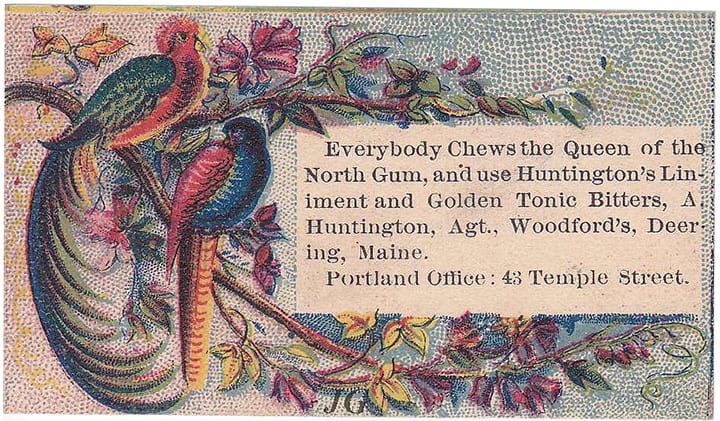
Everybody Chews the Queen of the North Gum, and use Huntington’s Liniment and Golden Tonic Bitters trade card (reverse blank) – Gourd Collection
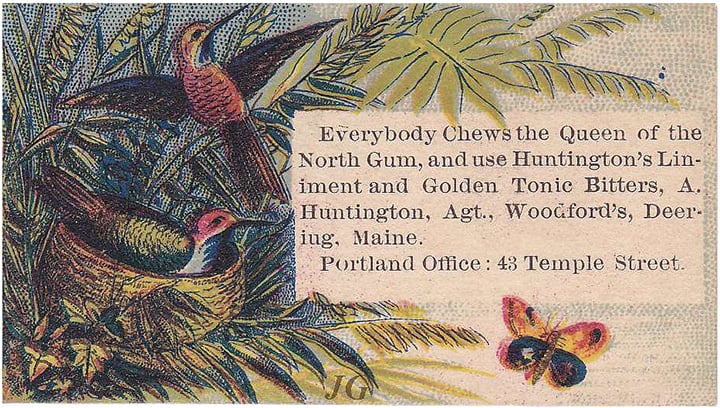
Everybody Chews the Queen of the North Gum, and use Huntington’s Liniment and Golden Tonic Bitters trade card (reverse blank) – Gourd Collection
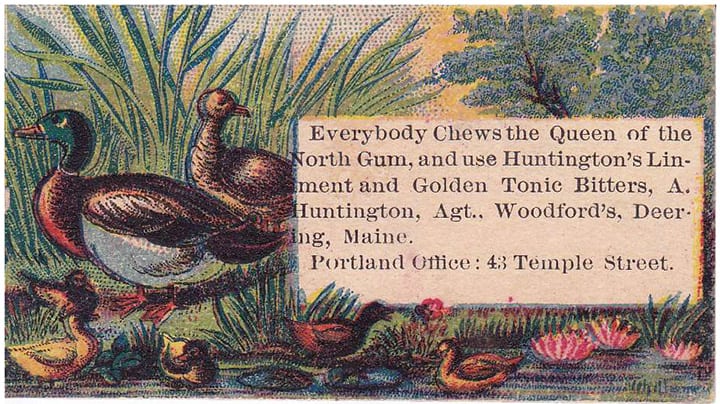
Everybody Chews the Queen of the North Gum, and use Huntington’s Liniment and Golden Tonic Bitters trade card (reverse blank) – Gourd Collection
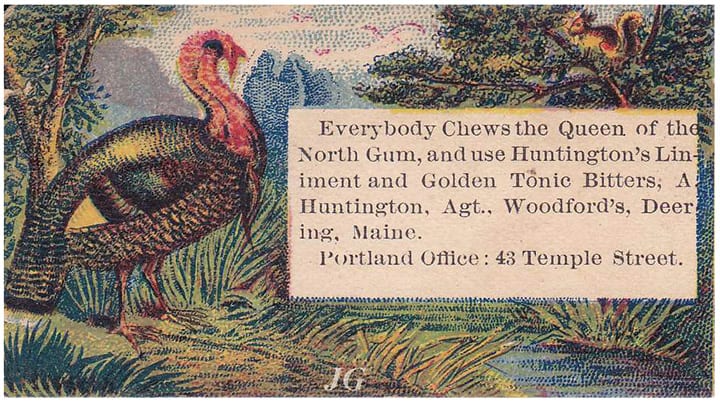
Everybody Chews the Queen of the North Gum, and use Huntington’s Liniment and Golden Tonic Bitters trade card (reverse blank) – Gourd Collection
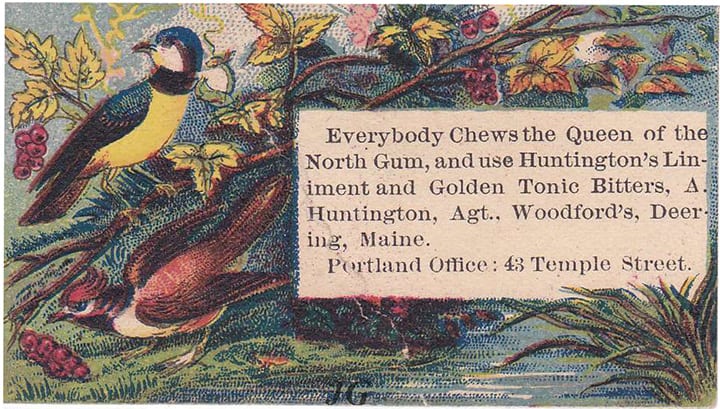
Everybody Chews the Queen of the North Gum, and use Huntington’s Liniment and Golden Tonic Bitters trade card (reverse blank) – Gourd Collection
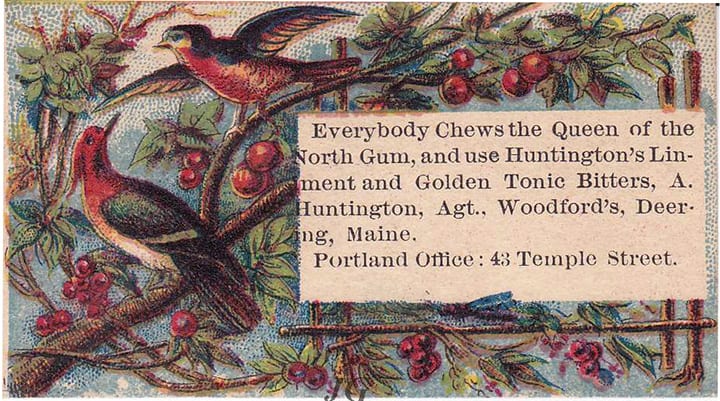
Everybody Chews the Queen of the North Gum, and use Huntington’s Liniment and Golden Tonic Bitters trade card (reverse blank) – Gourd Collection
The second series pictures frogs. The reverse sides of the cards are blank.
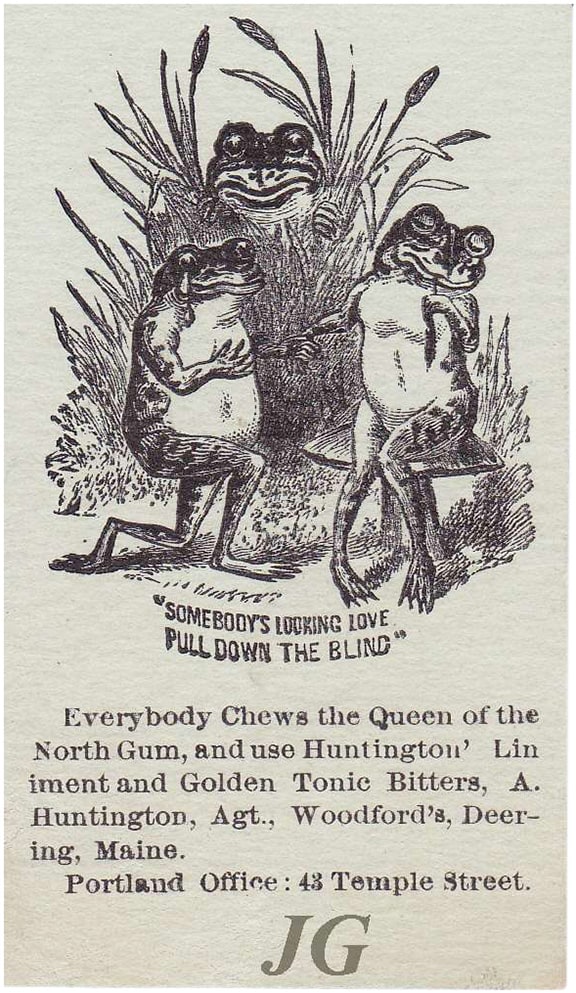
Everybody Chews the Queen of the North Gum, and use Huntington’s Liniment and Golden Tonic Bitters trade card (reverse blank) – Gourd Collection
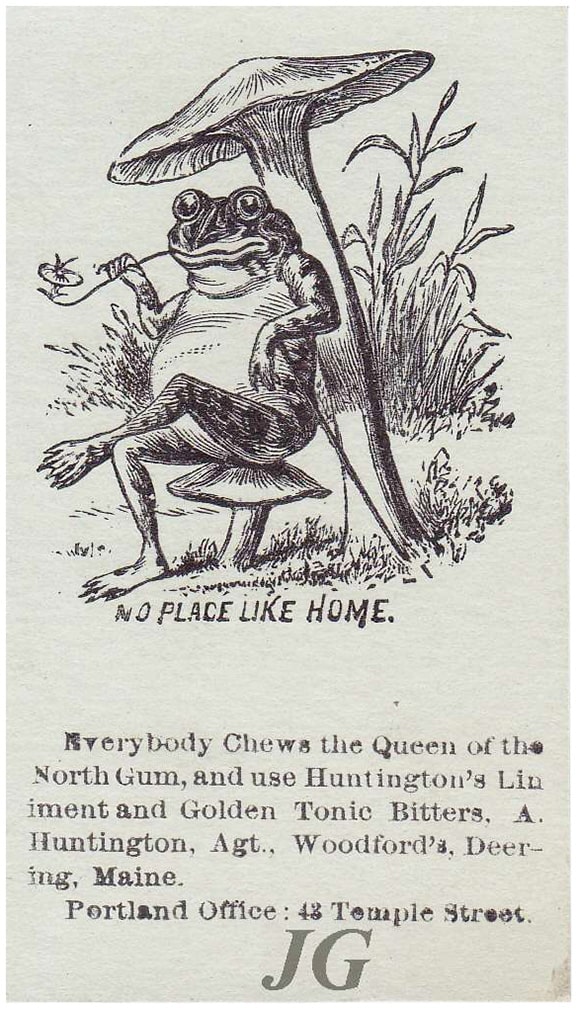
Everybody Chews the Queen of the North Gum, and use Huntington’s Liniment and Golden Tonic Bitters trade card (reverse blank) – Gourd Collection
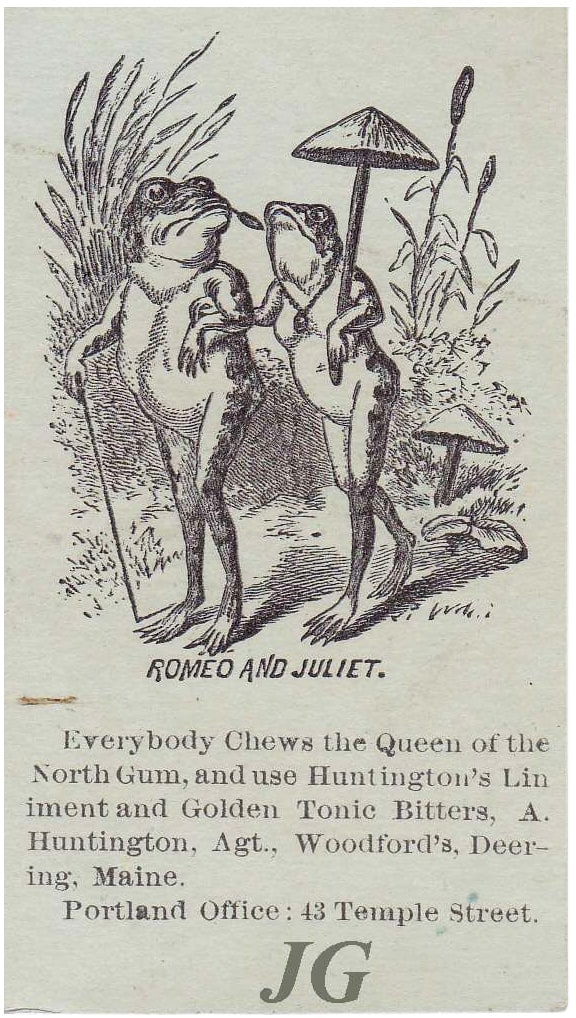
Everybody Chews the Queen of the North Gum, and use Huntington’s Liniment and Golden Tonic Bitters trade card (reverse blank) – Gourd Collection
Joe calls this next grouping of advertising cards the “Barnyard Series”. The reverse sides of the cards are blank.
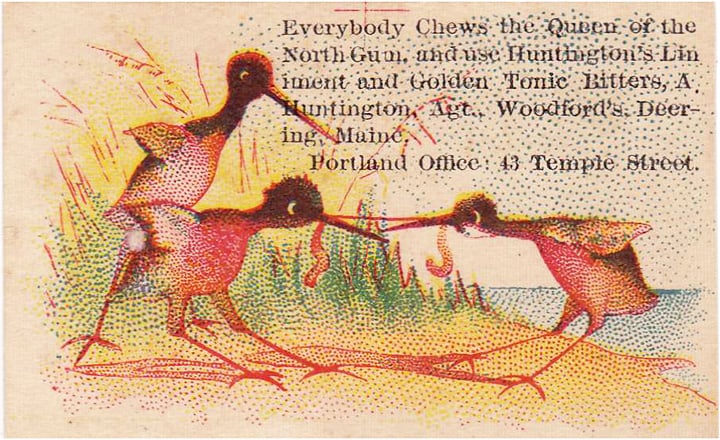
Everybody Chews the Queen of the North Gum, and use Huntington’s Liniment and Golden Tonic Bitters trade card (reverse blank) – Gourd Collection
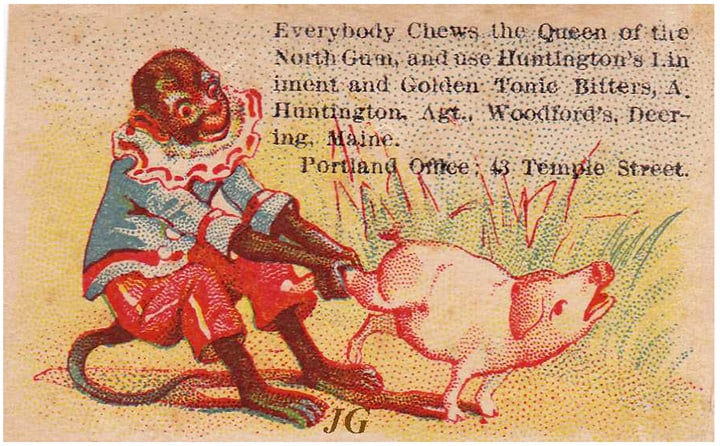
Everybody Chews the Queen of the North Gum, and use Huntington’s Liniment and Golden Tonic Bitters trade card (reverse blank) – Gourd Collection
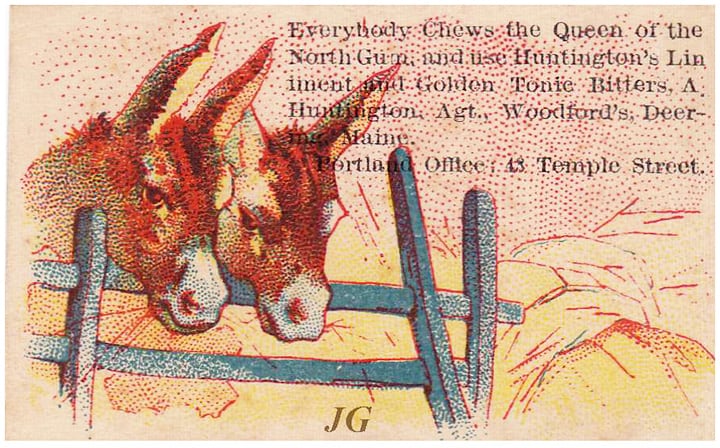
Everybody Chews the Queen of the North Gum, and use Huntington’s Liniment and Golden Tonic Bitters trade card (reverse blank) – Gourd Collection
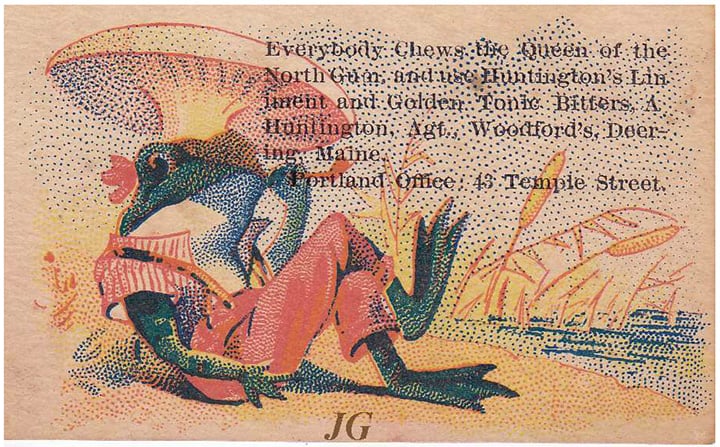
Everybody Chews the Queen of the North Gum, and use Huntington’s Liniment and Golden Tonic Bitters trade card (reverse blank) – Gourd Collection
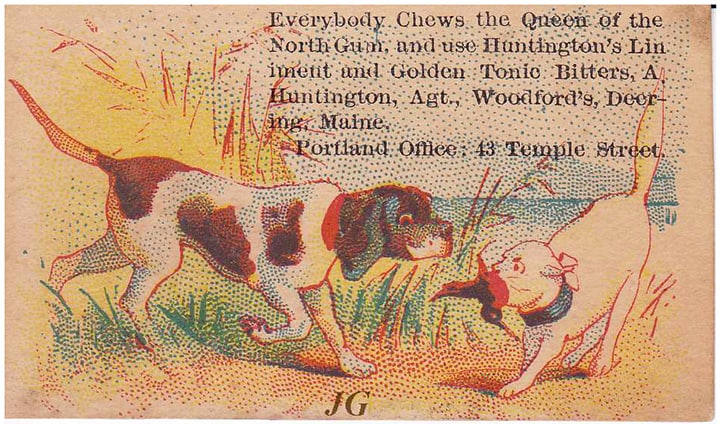
Everybody Chews the Queen of the North Gum, and use Huntington’s Liniment and Golden Tonic Bitters trade card (reverse blank) – Gourd Collection
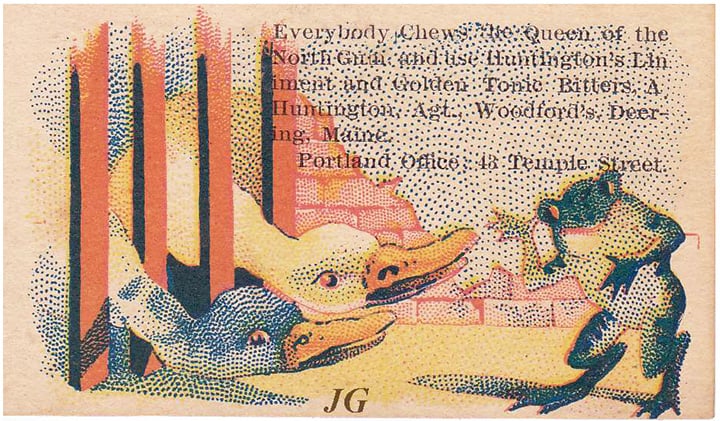
Everybody Chews the Queen of the North Gum, and use Huntington’s Liniment and Golden Tonic Bitters trade card (reverse blank) – Gourd Collection
This next grouping of advertising cards is called the “Winter Series” by Joe. The reverse sides of the cards are blank.
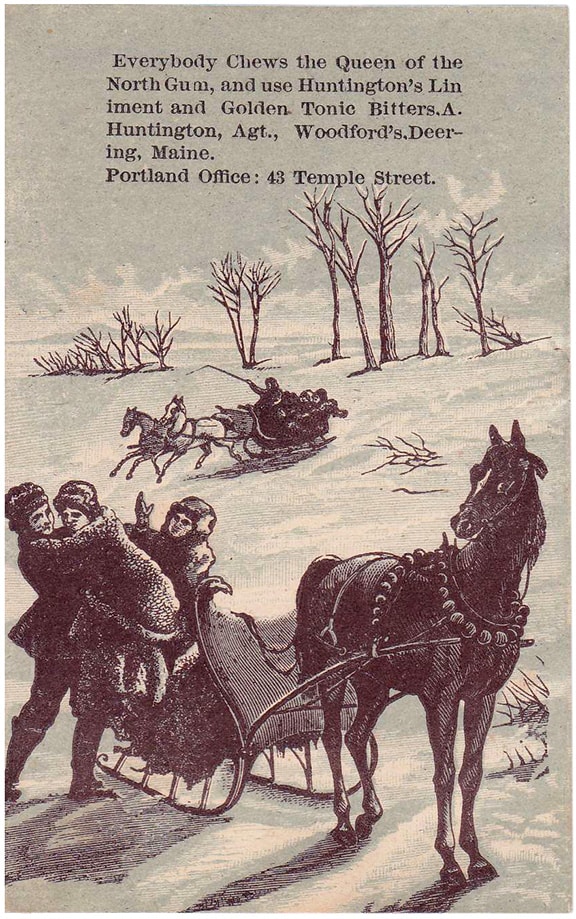
Everybody Chews the Queen of the North Gum, and use Huntington’s Liniment and Golden Tonic Bitters trade card (reverse blank) – Gourd Collection
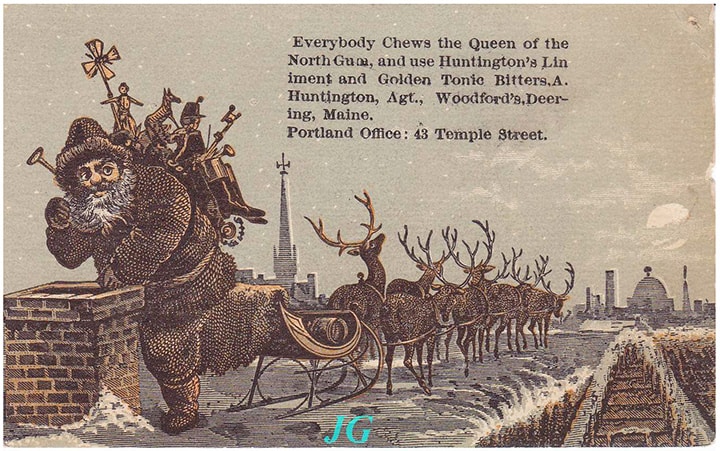
Everybody Chews the Queen of the North Gum, and use Huntington’s Liniment and Golden Tonic Bitters trade card (reverse blank) – Gourd Collection
This last series pictures nature scenes. Joe call these his “Sepia” cards. The reverse of the cards caries the standard message from the previous cards. The front of the cards have an area for a merchant to stamp their name and address.
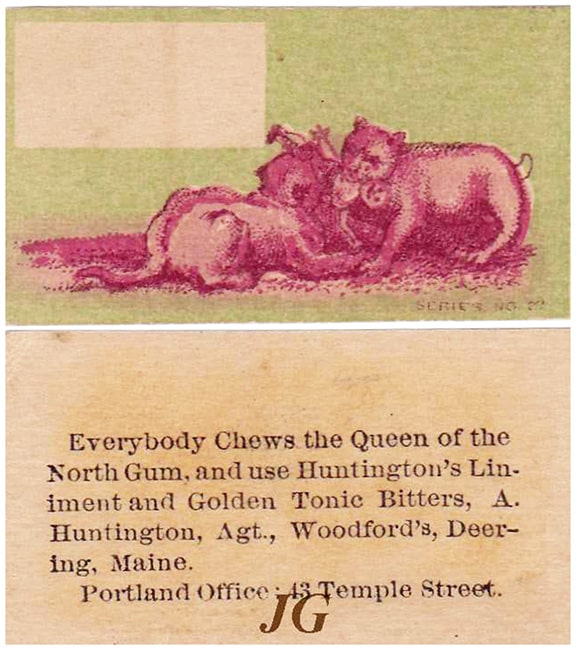
Everybody Chews the Queen of the North Gum, and use Huntington’s Liniment and Golden Tonic Bitters trade card – Gourd Collection
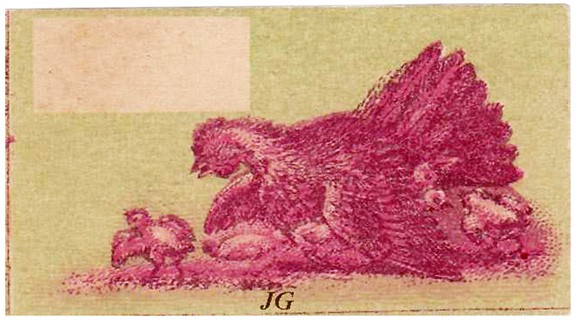
Everybody Chews the Queen of the North Gum, and use Huntington’s Liniment and Golden Tonic Bitters trade card – Gourd Collection
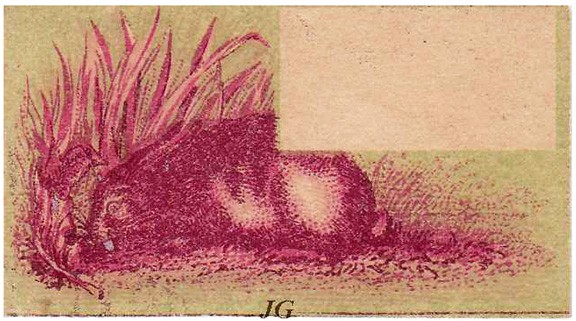
Everybody Chews the Queen of the North Gum, and use Huntington’s Liniment and Golden Tonic Bitters trade card – Gourd Collection
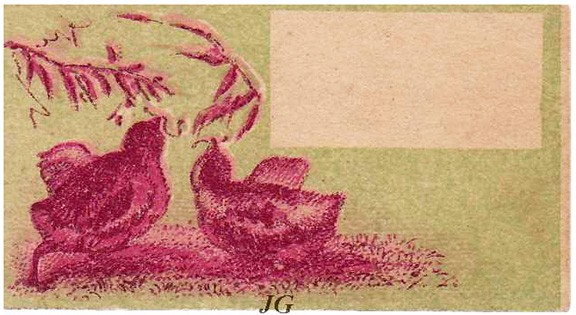
Everybody Chews the Queen of the North Gum, and use Huntington’s Liniment and Golden Tonic Bitters trade card – Gourd Collection
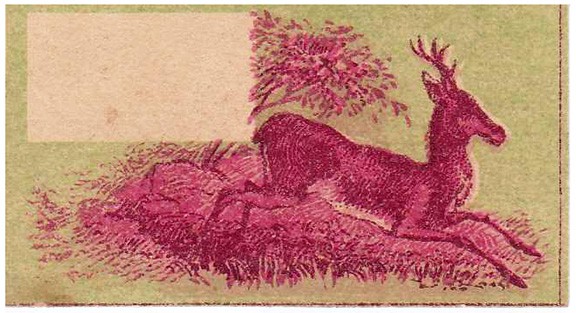
Everybody Chews the Queen of the North Gum, and use Huntington’s Liniment and Golden Tonic Bitters trade card – Gourd Collection
Labeled Dr. Huntington’s Golden Tonic Bitters

Labeled Dr. Huntington’s Golden Tonic Bitters. It confirms that Alpheus was the proprietor of the medicine. The back label also has a 4 cent Proprietary tax stamp dated March 13, 1870. – Sam Fuller

Pontiled medicine embossed A. Huntington and Monmouth, ME. embossed. Another bottle I have is smooth based and embossed Portland, ME. – Sam Fuller

Alpheus moved from Monmouth to Portland (Deering) sometime between 1863 and 1867. He was still located in Deering selling meds as late as 1885. The Horse and Ox liniment ad is from 1860 and the ad for his spruce gum and Golden Tonic Bitters is from 1869. – Sam Fuller, Stockton Springs, Maine
Read More: Globe Tonic Bitters – Portland, Maine
Read More: U.S. Gold Bitters – Augusta, Maine
Select Listings:
1820: Alpheus Huntington, Born 16 September 1820 in Litchfield, Kennebec, Maine – Huntington Family Association
1850: Alpheus Huntington, age 26, Pedlar (peddler), born abt 1824 Maine, wife Lucy A., 21, Monmouth, Kennebec, Maine – United States Federal Census
1854: The first trader at South Monmouth was John Meader, who opened a store in 1834. He was succeeded by Staple Chick, A. Huntington, Mr. Smith, W. & B. Witherell, Levi Day in 1854, W. Potter, B. Walker, J. W. Jordan in 1877, Buker Brothers 1884, C. A. Buker 1885, A. F. Tinkham 1887. At “Hall’s Mill,” the corner where the residence of Joshua Stover now stands, was a store occupied by Robert Randall and others. The first postmaster at South Monmouth was Lafayette W. Witherell, whose commission bears date December 22,1856; Barzillai Walker succeeded him April 22, 1858. The office was discontinued January 5, 1871, and reestablished May 8, 1871, with L. W. Witherell again postmaster. His successors were: Levi Day, April 15, 1872; John W. Jordan, February 7, 1878: Clarence A. Buker, January 16, 1884; L. W. Witherell, June 22, 1887; Algene F. Tinkham, December 6, 1887. – Illustrated History of Kennebec County, Maine; 1625-1799-1892, Part 2
Another old building was the Blossom & Judkins store, which stood a little south of Dr. M. O. Edward’s new drug store. Like nearly every other building in the village, it was remodeled and put to another use years ago. With one or two exceptions these buildings, with the Goodwin & Andrews store, which stood about where E. A. Dudley’s new store now stands, and was long occupied by William Arnold, and more recently by Ambrose Beal and Dudley & Blake; the store that stood where the meat market now stands, used by Henry S. Blue as a harness shop, and by C. L. Owen and others as a boot and shoe store; the drug stores erected by Alpheus Huntington and Watts & Andrews, all were consumed in the terrible conflagration of April 19, 1888, and the less extensive one of September 18, 1885. – Illustrated History of Kennebec County, Maine; 1625-1799-1892, Part 2
1856: Alpheus Huntington, Monmouth, Maine – The Maine Register and Business Directory, for the year 1856
1860: Alpheus Huntington, age 39, Druggist, born abt 1821 Maine, wife Lucy A., 33, son Fred W., 4, Monmouth, Kennebec, Maine – United States Federal Census
1862: Huntington’s Tonic Bitters noted on Pinchot & Bruen billhead (see above)
1863-1866: Alpheus Huntington, Maine – U.S. IRS Tax Assessment List
1868: On April 6, 1868, A. HUNTINGTON, of Portland, Maine, received a copyright for DR. HUNTINGTON’S GOLDEN TONIC BITTERS. This was probably for the label.
1869: Alpheus Huntington, manufacturer of spruce gum &c., 11 and 13 Plum, h. 59 Winter – Portland Maine City Directory
1870: Alpheus Huntington, age 48, born abt 1822 Maine, wife Lucy A., 43, Manufacturer of Gum, Portland Ward 6, Cumberland, Maine – United States Federal Census
1871: Alpheus Huntington, manufacturer of spruce gun &c. also chewing gums, 13 Plum, h. 59 Winter – Portland Maine City Directory
1873: Alpheus Huntington, patent medicines, chewing gums, 13 Plum, h. 59 Winter – Portland Maine City Directory
1875: Alpheus Huntington, Patent Medicines, 178 Fore, h. Woodford’s Corner – Portland Maine City Directory
1876-1877: Alpheus Huntington, Patent Medicine Manufacturer, chewing gum manufacturer, 121 Middle, h. Woodford’s Corner – Portland Maine City Directory
1880: Alpheus Huntington, age 58, born abt 1822 Maine, wife Lucy A., 53, Patent Medicine Man, Deering, Cumberland, Maine – United States Federal Census
1884: Alpheus Huntington, chewing gum manufacturer, Forest av. W., h. Grove, Fred W. Huntington (son), veterinary surgeon – Portland Maine City Directory
1885: Alpheus Huntington, chewing gum manufacturer, Deering N. Spring, h. Deering, Fred W. Huntington (son), veterinary surgeon – Portland Maine City Directory
1896-1898: Alpheus Huntington, h. 198 Deering, Fred W. Huntington (son), veterinary surgeon and horseshoer – Portland Maine City Directory
1900-1905: Alpheus Huntington, h. 490 Deering, Fred W. Huntington (son), veterinary surgeon and horseshoer, 1905 inspector – Portland Maine City Directory
1905: Death Alpheus Huntington, Find a Grave Index, 28 Apr 1905
![]() Finally coming out from under the work load associated with the FOHBC 2015 Chattanooga National and I am doing what I like best, that is passionately collecting and writing about antique bitters bottles. I even gave a talk with the master, Jack Sullivan, in Chattanooga, the seminar titled, “Every Bottle has a Story”. You can also see some of the bitters bottles in Chattanooga here: Chattanooga National Bitters Spotting
Finally coming out from under the work load associated with the FOHBC 2015 Chattanooga National and I am doing what I like best, that is passionately collecting and writing about antique bitters bottles. I even gave a talk with the master, Jack Sullivan, in Chattanooga, the seminar titled, “Every Bottle has a Story”. You can also see some of the bitters bottles in Chattanooga here: Chattanooga National Bitters Spotting